
Search Product category Any value Sample Label 1 Sample Label 2 Sample Label 3

How to Write a SWOT Analysis for a Business Plan
- March 21, 2024
- Business Plan , How to Write

Navigating the complexities of business requires a clear understanding of your strategic position, and a SWOT analysis is an essential tool to help you achieve this clarity. It’s a straightforward method that breaks down into Strengths, Weaknesses, Opportunities, and Threats, providing a snapshot of where your business stands and guiding your future strategic moves.
With this guide, you’ll learn how to leverage your advantages, address challenges, seize new opportunities, and guard against potential threats. Let’s dive into the process together and set a strong foundation for your business’s strategic planning. Let’s dive in!
What is a SWOT Analysis?
A SWOT analysis is a strategic planning tool used to identify and understand the Strengths, Weaknesses, Opportunities, and Threats related to business competition or project planning. This method helps organizations in assessing both internal and external factors that could impact their objectives.
- Strengths : Positive attributes internal to the organization and within its control. Strengths are resources and capabilities that can be used as a basis for developing a competitive advantage.
- Weaknesses : Factors that are within an organization’s control but detract from its ability to attain the desired goal. These are areas the business needs to improve to remain competitive.
- Opportunities : External chances to improve performance in the environment. Opportunities reflect the potential you can leverage to grow your business or project.
- Threats : External challenges to the business’s performance or project’s success. Threats might stem from various sources, such as economic downturns, increased competition, or changes in regulatory landscapes.
Why Use a SWOT Analysis?
We use a SWOT analysis for several important reasons in business and strategic planning:
- Strategic Overview : It provides a concise and comprehensive overview of the current strategic position of the business or project. By examining internal and external factors, stakeholders can get a clear picture of their situation.
- Decision Making : SWOT analysis aids in decision-making by highlighting the strengths to leverage, weaknesses to address, opportunities to pursue, and threats to mitigate. It helps in prioritizing actions based on the analysis.
- Opportunity Identification : SWOT analysis is instrumental in identifying new opportunities for growth and expansion. Opportunities might come from market trends , economic shifts, or changes in technology.
- Risk Management : By identifying threats, organizations can develop strategies to address or mitigate these risks before they become significant issues. It’s a proactive approach to managing potential external challenges.
- Resource Allocation : Understanding the organization’s strengths and weaknesses helps in the effective allocation of resources. Resources can be directed to areas where they are needed most or where they will have the highest impact.
- Competitive Advantage : It helps businesses identify unique features and capabilities that give them a competitive edge in the market. Recognizing these strengths can guide marketing strategies and business development.
How to Write a SWOT Analysis
Writing a strength in a SWOT analysis involves identifying and articulating the internal attributes and resources of a business or project that contribute to its success and competitive advantage. Here’s how to effectively write a strength in a SWOT analysis:
- Identify Internal Positive Attributes : Focus on internal factors that are within the control of the business. These can include resources, skills, or other advantages relative to competitors. Consider areas like strong brand reputation, proprietary technology, skilled workforce, financial resources, strategic location, and efficient processes.
- Be Specific and Relevant : General statements like “we have a good team” are less helpful than specific ones like “our team includes industry-recognized experts in X field.” The more precise you are, the more actionable your analysis will be. Ensure that the strengths are directly relevant to achieving the business’s goals and objectives.
- Use Quantifiable Data When Possible : Whenever you can, back up your strengths with quantifiable data. For example, “a customer satisfaction rate of 95%” or “a 20% lower production cost than industry average” provides concrete evidence of your strengths.
- Compare to Competitors : Strengths are often relative to the competition. Identify areas where your business outperforms competitors or fills a gap in the market. This might involve superior product quality, a unique service model, or a more extensive distribution network.
Example: Instead of simply stating “Experienced management team” as a strength, you could write: “Our management team has over 50 years of combined experience in the tech industry, including a track record of successful product launches and market expansions. This depth of experience provides us with strategic insights and operational expertise that have consistently resulted in market share growth and above-industry-average profitability.”
Writing a weakness in a SWOT analysis involves acknowledging and detailing the internal factors that limit or challenge your business or project’s ability to achieve its goals. Here’s a structured approach to effectively articulate weaknesses in a SWOT analysis:
- Identify Internal Limitations : Focus on internal attributes that are within the control of the organization but currently act as disadvantages. Weaknesses might include insufficient resources, lack of expertise, outdated technology, poor location, limited product range, or inefficiencies in processes.
- Be Specific and Honest : It’s important to be honest and specific about your organization’s weaknesses. Vague statements won’t help in addressing these issues. For instance, rather than saying “we need to improve our marketing,” specify “our current marketing strategy does not effectively reach our target demographic of 18-25-year-olds on digital platforms.”
- Use Internal Comparisons and Feedback : Compare your performance, processes, and resources against your own past performance or industry benchmarks. Utilize customer feedback, employee insights, and performance data to identify areas of weakness.
- Keep it Constructive : While it’s crucial to be honest about weaknesses, frame them in a way that focuses on potential for improvement. Consider each weakness as an area for development and growth.
Example: Instead of a broad statement like “Inadequate online presence,” a more effective description would be: “Our business currently lacks a robust online presence, reflected in our outdated website and minimal engagement on key social media platforms. This limits our ability to attract younger demographics who predominantly discover and interact with brands online. Improving our online visibility and engagement could enhance brand awareness and customer acquisition.”
Opportunities
Writing opportunities in a SWOT analysis involves identifying and articulating external factors that your business or project could exploit to its advantage. Opportunities are elements in the environment that, if leveraged effectively, could provide a pathway for growth, improvement, or competitive advantage. Here’s how to systematically approach writing opportunities in your SWOT analysis:
- Spot External Trends : Focus on the trends and changes outside your organization that could be beneficial. These might include technological advancements, shifts in consumer behavior, market gaps, regulatory changes, or economic trends.
- Be Relevant and Actionable : Ensure that the opportunities you identify are relevant to your business and actionable. They should align with your business’s strengths and capabilities, allowing you to take practical steps toward capitalizing on them.
- Use Market Research : Base your identification of opportunities on solid market research. Understand your target market , industry trends, and the competitive landscape to pinpoint where the real opportunities lie.
- Detail Potential Benefits : Clearly articulate how each opportunity could benefit your business. Whether it’s entering a new market, launching a new product line, or adopting new technology, explain the potential impact on your business growth and success.
Example: Rather than vaguely stating “New market segments,” a more strategic description of an opportunity could be: “With increasing consumer interest in sustainable living, there’s a growing market segment for eco-friendly products. Our business’s strong commitment to sustainability and existing lineup of environmentally friendly products positions us well to capture this emerging market. Expanding our product range to include more items that cater to eco-conscious consumers can tap into this trend, potentially opening up new revenue streams and enhancing our brand’s reputation as a leader in sustainability.”
Writing threats in a SWOT analysis involves identifying external challenges that could pose risks to your business or project’s success. These are factors outside your control that have the potential to harm your operations, financial performance, or strategic positioning. Addressing threats effectively in a SWOT analysis requires a focused approach:
- Identify External Challenges : Start by pinpointing the external factors that could negatively impact your business. This can include new competitors entering the market, changes in consumer preferences, technological advancements that render your product less desirable, regulatory changes, or economic downturns.
- Be Precise and Realistic : Clearly define each threat in specific terms, avoiding vague descriptions. Being realistic about the level of risk each threat poses is crucial; not every external challenge is a dire threat, but understanding the potential impact is key for strategic planning.
- Assess the Impact : For each threat identified, evaluate how it could impact your business. Consider the worst-case scenario and more likely outcomes to gauge the potential severity of the threat. This helps in prioritizing which threats need immediate attention and strategic response.
- Use Reliable Sources : Base your identification of threats on solid, reliable information. This might include industry reports, economic forecasts, and news sources that provide insights into market dynamics and external conditions.
- Consider Your Weaknesses : Link potential threats to your identified weaknesses. Understanding how external threats could exploit your vulnerabilities offers valuable insights for fortifying your business against these challenges.
Example: Instead of broadly stating “Economic uncertainty,” a more actionable description of a threat would be: “The looming economic downturn poses a significant threat to discretionary consumer spending. Given our business’s reliance on non-essential luxury products, a reduction in consumer spending could directly impact sales. This economic uncertainty requires us to diversify our product offerings and identify more value-oriented options to maintain customer engagement and spending during tighter economic conditions.”
Privacy Overview
.css-s5s6ko{margin-right:42px;color:#F5F4F3;}@media (max-width: 1120px){.css-s5s6ko{margin-right:12px;}} Join us: Learn how to build a trusted AI strategy to support your company's intelligent transformation, featuring Forrester .css-1ixh9fn{display:inline-block;}@media (max-width: 480px){.css-1ixh9fn{display:block;margin-top:12px;}} .css-1uaoevr-heading-6{font-size:14px;line-height:24px;font-weight:500;-webkit-text-decoration:underline;text-decoration:underline;color:#F5F4F3;}.css-1uaoevr-heading-6:hover{color:#F5F4F3;} .css-ora5nu-heading-6{display:-webkit-box;display:-webkit-flex;display:-ms-flexbox;display:flex;-webkit-align-items:center;-webkit-box-align:center;-ms-flex-align:center;align-items:center;-webkit-box-pack:start;-ms-flex-pack:start;-webkit-justify-content:flex-start;justify-content:flex-start;color:#0D0E10;-webkit-transition:all 0.3s;transition:all 0.3s;position:relative;font-size:16px;line-height:28px;padding:0;font-size:14px;line-height:24px;font-weight:500;-webkit-text-decoration:underline;text-decoration:underline;color:#F5F4F3;}.css-ora5nu-heading-6:hover{border-bottom:0;color:#CD4848;}.css-ora5nu-heading-6:hover path{fill:#CD4848;}.css-ora5nu-heading-6:hover div{border-color:#CD4848;}.css-ora5nu-heading-6:hover div:before{border-left-color:#CD4848;}.css-ora5nu-heading-6:active{border-bottom:0;background-color:#EBE8E8;color:#0D0E10;}.css-ora5nu-heading-6:active path{fill:#0D0E10;}.css-ora5nu-heading-6:active div{border-color:#0D0E10;}.css-ora5nu-heading-6:active div:before{border-left-color:#0D0E10;}.css-ora5nu-heading-6:hover{color:#F5F4F3;} Register now .css-1k6cidy{width:11px;height:11px;margin-left:8px;}.css-1k6cidy path{fill:currentColor;}
- Project management |
SWOT analysis: Examples and templates

A SWOT analysis helps you identify strengths, weaknesses, opportunities, and threats for a specific project or your overall business plan. It’s used for strategic planning and to stay ahead of market trends. Below, we describe each part of the SWOT framework and show you how to conduct your own.
Whether you’re looking for external opportunities or internal strengths, we’ll walk you through how to perform your own SWOT analysis, with helpful examples along the way.
What is a SWOT analysis?
A SWOT analysis is a technique used to identify strengths, weaknesses, opportunities, and threats for your business or even a specific project. It’s most widely used by organizations—from small businesses and non-profits to large enterprises—but a SWOT analysis can be used for personal purposes as well.
While simple, a SWOT analysis is a powerful tool for helping you identify competitive opportunities for improvement. It helps you improve your team and business while staying ahead of market trends.
What does SWOT stand for?
SWOT is an acronym that stands for:
Opportunities

When analyzed together, the SWOT framework can paint a larger picture of where you are and how to get to the next step. Let’s dive a little deeper into each of these terms and how they can help identify areas of improvement.
Strengths in SWOT refer to internal initiatives that are performing well. Examining these areas helps you understand what’s already working. You can then use the techniques that you know work—your strengths—in other areas that might need additional support, like improving your team’s efficiency .
When looking into the strengths of your organization, ask yourself the following questions:
What do we do well? Or, even better: What do we do best?
What’s unique about our organization?
What does our target audience like about our organization?
Which categories or features beat out our competitors?
Example SWOT strength:
Customer service: Our world-class customer service has an NPS score of 90 as compared to our competitors, who average an NPS score of 70.
Weaknesses in SWOT refer to internal initiatives that are underperforming. It’s a good idea to analyze your strengths before your weaknesses in order to create a baseline for success and failure. Identifying internal weaknesses provides a starting point for improving those projects.
Identify the company’s weaknesses by asking:
Which initiatives are underperforming and why?
What can be improved?
What resources could improve our performance?
How do we rank against our competitors?
Example SWOT weakness:
E-commerce visibility: Our website visibility is low because of a lack of marketing budget , leading to a decrease in mobile app transactions.
Opportunities in SWOT result from your existing strengths and weaknesses, along with any external initiatives that will put you in a stronger competitive position. These could be anything from weaknesses that you’d like to improve or areas that weren’t identified in the first two phases of your analysis.
Since there are multiple ways to come up with opportunities, it’s helpful to consider these questions before getting started:
What resources can we use to improve weaknesses?
Are there market gaps in our services?
What are our business goals for the year?
What do your competitors offer?
Example SWOT opportunities:
Marketing campaign: To improve brand visibility, we’ll run ad campaigns on YouTube, Facebook, and Instagram.
Threats in SWOT are areas with the potential to cause problems. Different from weaknesses, threats are external and out of your control. This can include anything from a global pandemic to a change in the competitive landscape.
Here are a few questions to ask yourself to identify external threats:
What changes in the industry are cause for concern?
What new market trends are on the horizon?
Where are our competitors outperforming us?
Example SWOT threats:
New competitor: With a new e-commerce competitor set to launch within the next month, we could see a decline in customers.
SWOT analysis example
One of the most popular ways to create a SWOT analysis is through a SWOT matrix—a visual representation of strengths, weaknesses, opportunities, and threats. The matrix comprises four separate squares that create one larger square.
A SWOT matrix is great for collecting information and documenting the questions and decision-making process . Not only will it be handy to reference later on, but it’s also great for visualizing any patterns that arise.
Check out the SWOT matrix below for a simple example. As you can see, each of the quadrants lists out the company's strengths, weaknesses, opportunities, and threats.
![swot analysis examples for business plan [Inline illustration] SWOT analysis (Example)](https://assets.asana.biz/transform/cfab4ed2-46d1-4636-b801-14b3d86c8367/inline-project-management-SWOT-analysis-4-2x?io=transform:fill,width:2560&format=webp)
When used correctly and effectively, your matrix can be a great toolkit for evaluating your organization’s strengths and weaknesses.
How to do a SWOT analysis, with examples
A SWOT analysis can be conducted in a variety of ways. Some teams like to meet and throw ideas on a whiteboard, while others prefer the structure of a SWOT matrix. However you choose to make your SWOT analysis, getting creative with your planning process allows new ideas to flow and results in more unique solutions.
There are a few ways to ensure that your SWOT analysis is thorough and done correctly. Let’s take a closer look at some tips to help you get started.
Tip 1: Consider internal factors
Often, strengths and weaknesses stem from internal processes. These tend to be easier to solve since you have more control over the outcome. When you come across internal factors, you can start implementing improvements in a couple of different ways.
Meet with department stakeholders to form a business plan around how to improve your current situation.
Research and implement new tools, such as a project management tool , that can help streamline these processes for you.
Take immediate action on anything that can be changed in 24 hours or less. If you don’t have the capacity, consider delegating these items to others with deadlines.
The way you go about solving internal factors will depend on the type of problem. If it’s more complex, you might need to use a combination of the above or a more thorough problem management process.
Tip 2: Evaluate external factors
External factors stem from processes outside of your control. This includes competitors, market trends, and anything else that’s affecting your organization from the outside in.
External factors are trickier to solve, as you can’t directly control the outcome. What you can do is pivot your own processes in a way that mitigates negative external factors.
You can work to solve these issues by:
Competing with market trends
Forecasting market trends before they happen
Improving adaptability to improve your reaction time
Track competitors using reporting tools that automatically update you as soon as changes occur
While you won’t be able to control an external environment, you can control how your organization reacts to it.
Let’s say, for instance, that you’re looking to compete with a market trend. For example, a competitor introduced a new product to the market that’s outperforming your own. While you can’t take that product away, you can work to launch an even better product or marketing campaign to mitigate any decline in sales.
Tip 3: Hold a brainstorming session
Brainstorming new and innovative ideas can help to spur creativity and inspire action. To host a high impact brainstorming session, you’ll want to:
Invite team members from various departments. That way, ideas from each part of the company are represented.
Be intentional about the number of team members you invite, since too many participants could lead to a lack of focus or participation. The sweet spot for a productive brainstorming session is around 10 teammates.
Use different brainstorming techniques that appeal to different work types.
Set a clear intention for the session.
Tip 4: Get creative
In order to generate creative ideas, you have to first invite them. That means creating fun ways to come up with opportunities. Try randomly selecting anonymous ideas, talking through obviously bad examples, or playing team building games to psych up the team.
Tip 5: Prioritize opportunities
Now, rank the opportunities. This can be done as a team or with a smaller group of leaders. Talk through each idea and rank it on a scale of one through 10. Once you’ve agreed on your top ideas based on team capabilities, competencies, and overall impact, it’s easier to implement them.
Tip 6: Take action
It’s all too easy to feel finished at this stage —but the actual work is just beginning. After your SWOT analysis, you’ll have a list of prioritized opportunities. Now is the time to turn them into strengths. Use a structured system such as a business case , project plan, or implementation plan to outline what needs to get done—and how you plan to do it.
SWOT analysis template
A SWOT analysis template is often presented in a grid format, divided into four quadrants. Each quadrant represents one of the four elements.
Use this free SWOT analysis template to jump-start your team’s strategic planning.
Identify the strengths that contribute to achieving your objectives. These are internal characteristics that give you an advantage. Some examples could be a strong brand reputation, an innovative culture, or an experienced management team.
Next, focus on weaknesses. These are internal factors that could serve as obstacles to achieving your objectives. Common examples might include a lack of financial resources, high operational costs, or outdated technology.
Move on to the opportunities. These are external conditions that could be helpful in achieving your goals. For example, you might be looking at emerging markets, increased demand, or favorable shifts in regulations.
Lastly, let's address threats. These are external conditions that could negatively impact your objectives. Examples include increased competition or potential economic downturns.
Why is a SWOT analysis important?
A SWOT analysis can help you improve processes and plan for growth. While similar to a competitive analysis , it differs because it evaluates both internal and external factors. Analyzing key areas around these opportunities and threats will equip you with the insights needed to set your team up for success.

A SWOT analysis isn’t only useful for organizations. With a personal SWOT analysis, you can examine areas of your life that could benefit from improvement, from your leadership style to your communication skills. These are the benefits of using a SWOT analysis in any scenario.
1. Identifies areas of opportunity
One of the biggest benefits of conducting an analysis is to determine opportunities for growth. It’s a great starting point for startups and teams that know they want to improve but aren’t exactly sure how to get started.
Opportunities can come from many different avenues, like external factors such as diversifying your products for competitive advantage or internal factors like improving your team’s workflow . Either way, capitalizing on opportunities is an excellent way to grow as a team.
2. Identifies areas that could be improved
Identifying weaknesses and threats during a SWOT analysis can pave the way for a better business strategy.
Ultimately, learning from your mistakes is the best way to excel. Once you find areas to streamline, you can work with team members to brainstorm an action plan . This will let you use what you already know works and build on your company’s strengths.
3. Identifies areas that could be at risk
Whether you have a risk register in place or not, it’s always crucial to identify risks before they become a cause for concern. A SWOT analysis can help you stay on top of actionable items that may play a part in your risk decision-making process.
It may be beneficial to pair your SWOT analysis with a PEST analysis, which examines external solutions such as political, economic, social, and technological factors—all of which can help you identify and plan for project risks .
When should you use a SWOT analysis?
You won’t always need an in-depth SWOT analysis. It’s most useful for large, general overviews of situations, scenarios, or your business.
A SWOT analysis is most helpful:
Before you implement a large change—including as part of a larger change management plan
When you launch a new company initiative
If you’d like to identify opportunities for growth and improvement
Any time you want a full overview of your business performance
If you need to identify business performance from different perspectives
SWOT analyses are general for a reason—so they can be applied to almost any scenario, project, or business.
SWOT analysis: Pros and cons
Although SWOT is a useful strategic planning tool for businesses and individuals alike, it does have limitations. Here’s what you can expect.
The simplicity of SWOT analysis makes it a go-to tool for many. Because it is simple, it takes the mystery out of strategic planning and lets people think critically about their situations without feeling overwhelmed.
For instance, a small bakery looking to expand its operations can use SWOT analysis to easily understand its current standing. Identifying strengths like a loyal customer base, weaknesses such as limited seating space, opportunities like a rising trend in artisanal baked goods, and threats from larger chain bakeries nearby can all be accomplished without any specialized knowledge or technical expertise.
Versatility
Its versatile nature allows SWOT analysis to be used across various domains. Whether it’s a business strategizing for the future or an individual planning their career path, SWOT analysis lends itself well.
For example, a tech start-up in the competitive Silicon Valley landscape could employ SWOT to navigate its pathway to profitability. Strengths might include a highly skilled development team; weaknesses could be a lack of brand recognition; opportunities might lie in emerging markets; and threats could include established tech giants.
Meaningful analysis
SWOT excels in identifying external factors that could impact performance. It nudges organizations to look beyond the present and anticipate potential future scenarios.
A retail company, for example, could use SWOT analysis to identify opportunities in e-commerce and threats from changing consumer behavior or new competitors entering the market. By doing so, the company can strategize on how to leverage online platforms to boost sales and counteract threats by enhancing the customer experience or adopting new technologies.
Subjectivity and bias
The subjective nature of SWOT analysis may lead to biases. It relies heavily on individual perceptions, which can sometimes overlook crucial data or misinterpret information, leading to skewed conclusions.
For example, a manufacturing company might undervalue the threat of new entrants in the market due to an overconfidence bias among the management. This subjectivity might lead to a lack of preparation for competitive pricing strategies, ultimately affecting the company's market share.
Lack of prioritization
SWOT analysis lays out issues but falls short on prioritizing them. Organizations might struggle to identify which elements deserve immediate attention and resources.
For instance, a healthcare provider identifying numerous opportunities for expansion into new services may become overwhelmed with the choices. Without a clear way to rank these opportunities, resources could be spread too thinly or given to projects that do not have as much of an impact, leading to less-than-ideal outcomes.
Static analysis
Since SWOT analysis captures a snapshot at a particular moment, it may miss the evolving nature of challenges and opportunities, possibly leading to outdated strategies. An example could be a traditional retail business that performs a SWOT analysis and decides to focus on expanding physical stores, overlooking the growing trend of e-commerce. As online shopping continues to evolve and gain popularity, the static analysis might lead to investment in areas with diminishing returns while missing out on the booming e-commerce market trend.
SWOT analysis FAQ
What are the five elements of swot analysis.
Traditionally, SWOT stands for its four main elements: strengths, weaknesses, opportunities, and threats. However, a fifth essential element often overlooked is "actionable strategies." Originally developed by Albert Humphrey, SWOT is more than just a list—it's a planning tool designed to generate actionable strategies for making informed business decisions. This fifth element serves to tie the other four together, enabling departments like human resources and marketing to turn analysis into actionable plans.
What should a SWOT analysis include?
A comprehensive SWOT analysis should focus on the internal and external factors that affect your organization. Internally, consider your strong brand and product line as your strengths, and maybe your supply chain weaknesses. Externally, you'll want to look at market share, partnerships, and new technologies that could either pose opportunities or threats. You should also account for demographics, as it helps in market targeting and segmentation.
How do you write a good SWOT analysis?
Writing an effective SWOT analysis begins with research. Start by identifying your strengths, like a strong brand, and your weaknesses, like a small human resources department. Following that, look outward to find opportunities, possibly in technological advancement, and threats, like fluctuations in market share. Many businesses find it helpful to use a free SWOT analysis template to structure this information. A good SWOT analysis doesn't just list these elements; it integrates them to provide a clear roadmap for making business decisions.
What are four examples of threats in SWOT analysis?
New technologies: Rapid technological advancement can make your product or service obsolete.
Supply chain disruptions: Whether due to natural disasters or geopolitical tensions, an unstable supply chain can seriously jeopardize your operations.
Emerging competitors: New players entering the market can erode your market share and offer alternative solutions to your customer base.
Regulatory changes: New laws or regulations can add costs and complexity to your business, affecting your competitiveness.
How do you use a SWOT analysis?
Once you've completed a SWOT analysis, use the results as a decision-making aid. It can help prioritize actions, develop strategic plans that play to your strengths, improve weaknesses, seize opportunities, and counteract threats. It’s a useful tool for setting objectives and creating a roadmap for achieving them.
Plan for growth with a SWOT analysis
A SWOT analysis can be an effective technique for identifying key strengths, weaknesses, opportunities, and threats. Understanding where you are now can be the most impactful way to determine where you want to go next.
Don’t forget, a bit of creativity and collaboration can go a long way. Encourage your team to think outside of the box with 100+ team motivational quotes .
Related resources

Unmanaged business goals don’t work. Here’s what does.

How Asana uses work management to drive product development

How Asana uses work management to streamline project intake processes

How Asana uses work management for smoother creative production
SWOT Analysis: How To Do One [With Template & Examples]
Published: October 05, 2023
As your business grows, you need a roadmap to help navigate the obstacles, challenges, opportunities, and projects that come your way. Enter: the SWOT analysis.

This framework can help you develop a plan to determine your priorities, maximize opportunities, and minimize roadblocks as you scale your organization. Below, let’s go over exactly what a SWOT analysis is, a few SWOT analysis examples, and how to conduct one for your business.
![swot analysis examples for business plan → Download Now: Market Research Templates [Free Kit]](https://no-cache.hubspot.com/cta/default/53/6ba52ce7-bb69-4b63-965b-4ea21ba905da.png)
When you’re done reading, you’ll have all the inspiration and tactical advice you need to tackle a SWOT analysis for your business.
What is a SWOT analysis? Importance of a SWOT Analysis How to Write a Good SWOT Analysis SWOT Analysis Examples How to Act on a SWOT Analysis
What is a SWOT analysis?
A SWOT analysis is a strategic planning technique that puts your business in perspective using the following lenses: Strengths, Weaknesses, Opportunities, and Threats. Using a SWOT analysis helps you identify ways your business can improve and maximize opportunities, while simultaneously determining negative factors that might hinder your chances of success.
While it may seem simple on the surface, a SWOT analysis allows you to make unbiased evaluations on:
- Your business or brand.
- Market positioning.
- A new project or initiative.
- A specific campaign or channel.
Practically anything that requires strategic planning, internal or external, can have the SWOT framework applied to it, helping you avoid unnecessary errors down the road from lack of insight.
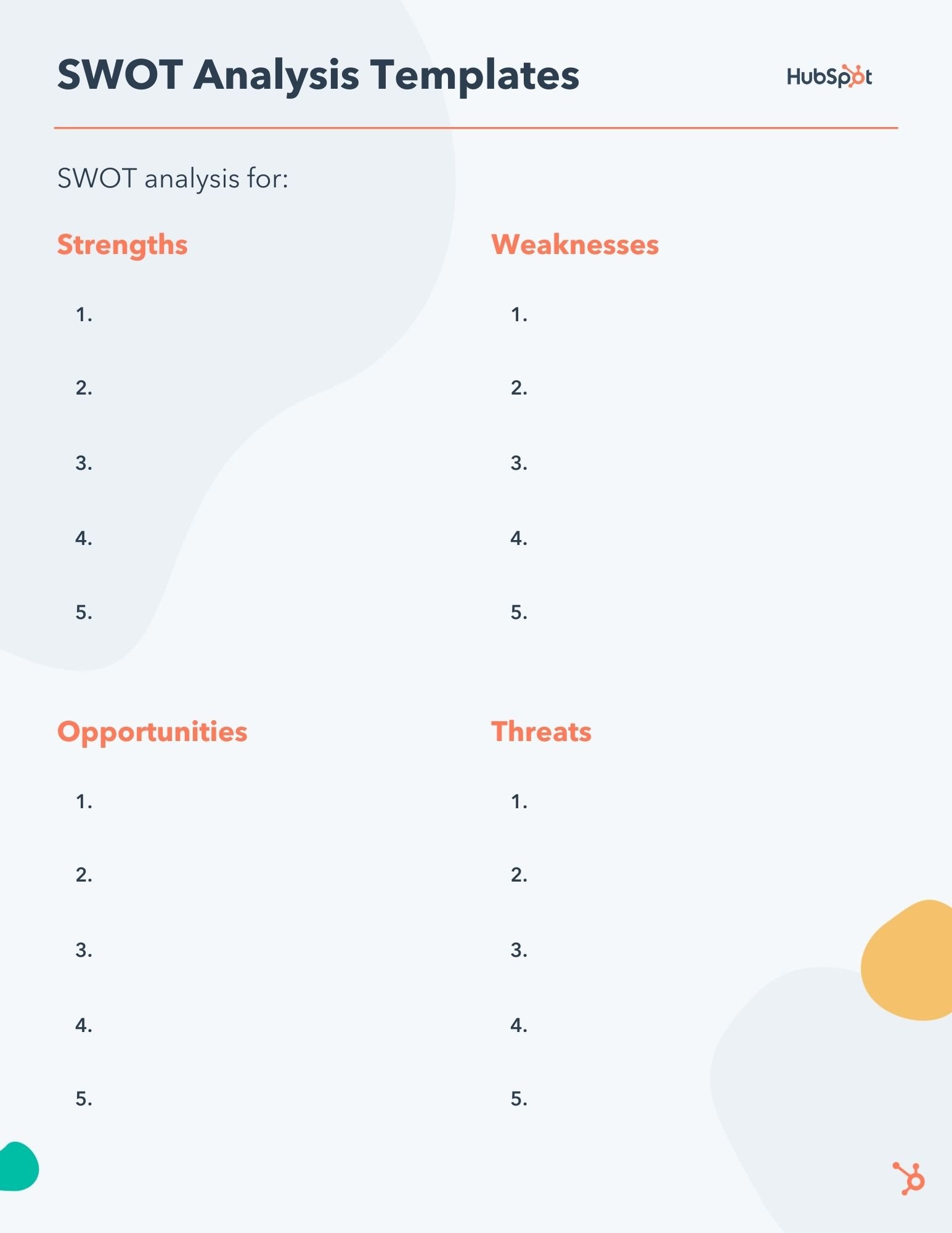
Free SWOT Analysis Template
A free SWOT analysis template, plus other helpful market research resources.
Opportunities
You're all set.
Click this link to access this resource at any time.
Importance of a SWOT Analysis
You’ve noticed by now that SWOT stands for Strengths, Weaknesses, Opportunities, and Threats. The framework seems simple enough that you’d be tempted to forgo using it at all, relying instead on your intuition to take these things into account.
But you shouldn’t. Doing a SWOT analysis is important. Here’s why.
SWOT gives you the chance to worry and to dream.
A SWOT analysis is an important step in your strategic process because it gives you the opportunity to explore both the potential risks and the exciting possibilities that lie ahead. You’re giving yourself the space to dream, evaluate, and worry before taking action. Your insights then turn into assets as you create the roadmap for your initiative.
For instance, when you consider the weaknesses and threats that your business may face, you can address any concerns or challenges and strategize on how to mitigate those risks. At the same time, you can identify strengths and opportunities, which can inspire innovative ideas and help you dream big. Both are equally important.
SWOT forces you to define your variables.
Instead of diving head first into planning and execution, you’re taking inventory of all your assets and roadblocks. This process will help you develop strategies that leverage your strengths and opportunities while addressing and mitigating the impact of weaknesses and threats.
As a result, you'll gain a comprehensive understanding of your current situation and create a more specific and effective roadmap. Plus, a SWOT analysis is inherently proactive. That means you'll be better equipped to make informed decisions, allocate resources effectively, and set realistic goals.
SWOT allows you to account for mitigating factors.
As you identify weaknesses and threats, you’re better able to account for them in your roadmap, improving your chances of success.
Moreover, accounting for mitigating factors allows you to allocate your resources wisely and make informed decisions that lead to sustainable growth. With a SWOT analysis as a guide, you can confidently face challenges and seize opportunities.
SWOT helps you keep a written record.
As your organization grows and changes, you’ll be able to strike things off your old SWOTs and make additions. You can look back at where you came from and look ahead at what’s to come.
In other words, SWOT analyses serve as a tangible history of your progress and provide a reference point for future decision-making. With each update, your SWOT analysis becomes a living document that guides your strategic thinking and helps you stay agile and adaptable in an ever-changing business landscape.
By maintaining this written record, you foster a culture of continuous improvement and empower your team to make data-driven decisions and stay aligned with your long-term vision.
Parts of a SWOT Analysis
Conducting a SWOT analysis will help you strategize effectively, unlock valuable insights, and make informed decisions. But what exactly does a SWOT analysis include?
Let’s explore each component: Strengths, Weaknesses, Opportunities, and Threats.
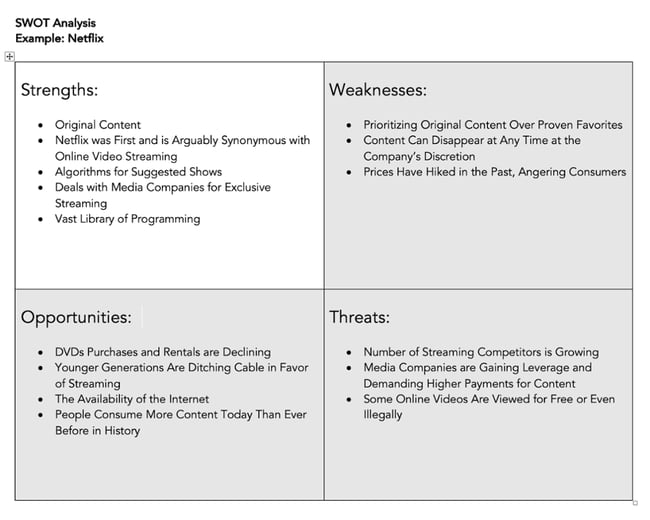
Your strengths are the unique advantages and internal capabilities that give your company a competitive edge in the market. A strong brand reputation, innovative products or services, or exceptional customer service are just a few examples. By identifying and capitalizing on your strengths, you can foster customer loyalty and build a solid foundation for growth.
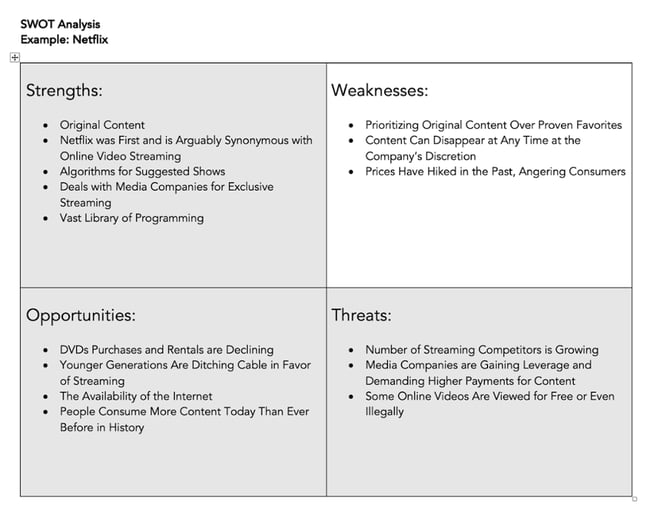
No business is flawless. Weaknesses are areas where you may face challenges or fall short of your potential. It could be outdated processes, skill gaps within the team, or inadequate resources. By acknowledging these weaknesses, you can establish targeted initiatives for improvement, upskill your team, adopt new technologies, and enhance your overall operational efficiency.
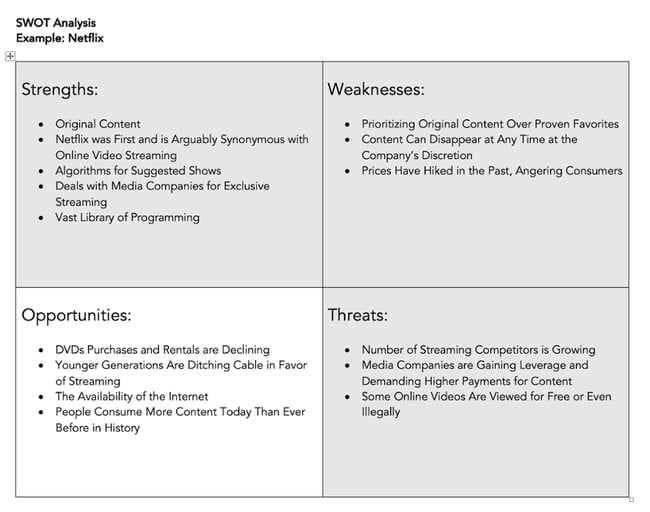
Opportunities are external factors that can contribute to your company's progress. These may include emerging markets, technological advancements, changes in consumer behavior, or gaps in the market that your company can fill. By seizing these opportunities, you can expand your market reach, diversify your product offerings, forge strategic partnerships, or even venture into untapped territories.
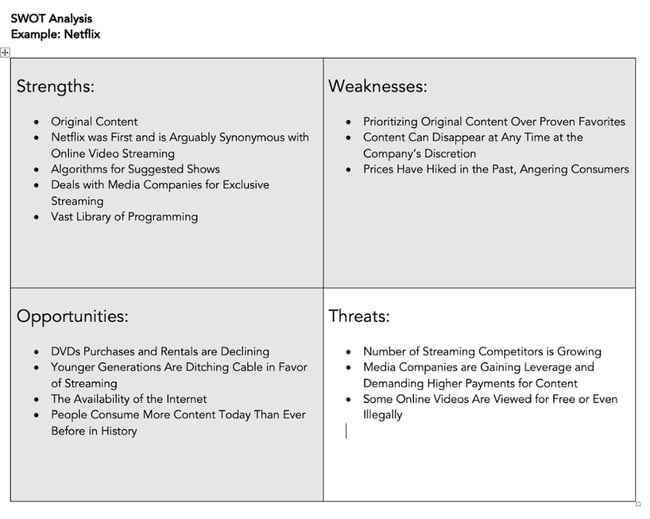
Threats are external factors that are beyond your control and pose challenges to your business. Increased competition, economic volatility, evolving regulatory landscapes, or even changing market trends are examples of threats. By proactively assessing and addressing them, you can develop contingency plans, adjust your strategies, and minimize their impact on your operations.
In a SWOT analysis, you’ll have to take both internal and external factors into account. We’ll cover those next.
.png)
Free Market Research Kit
5 Research and Planning Templates + a Free Guide on How to Use Them in Your Market Research
- SWOT Analysis Template
- Survey Template
- Focus Group Template
SWOT Analysis Internal and External Factors
A SWOT analysis typically has internal (i.e., within your organization) and external (i.e., outside your organization) factors at play. Here's a breakdown of each.
Internal Factors
Internal factors refer to the characteristics and resources within your organization that directly influence its operations and performance. These factors are completely within your organization's control, so they can be modified, improved, or capitalized upon.
In a SWOT analysis, strengths and weaknesses are categorized as internal factors. Let’s look at a few examples.
- Brand reputation
- Unique expertise
- Loyal customer base
- Talented workforce
- Efficient processes
- Proprietary technology
- Outdated technology
- Inadequate resources
- Poor financial health
- Inefficient processes
- Skill gaps within the team
External Factors
External factors are elements outside the organization's control that have an impact on its operations, market position, and success. These factors arise from the industry climate and the broader business environment. You typically have no control over external factors, but you can respond to them.
In a SWOT analysis, opportunities and threats are categorized as external factors. Let’s look at a few examples.
- Emerging markets
- Changing consumer trends
- Technological advancements
- Positive shifts in regulations
- New gaps in the market you could fill
- Intense competition
- Economic downturns
- Disruptive technologies
- Changing regulations
- Negative shifts in consumer behavior
Remember, a well-rounded SWOT analysis empowers you to capitalize on strengths, address weaknesses, seize opportunities, and navigate threats — all while making informed decisions for the future.
Now, let’s take a look at how you can write a good SWOT analysis for yourself or for stakeholders.
How do you write a good SWOT analysis?
There are several steps you’ll want to take when evaluating your business and conducting a strategic SWOT analysis.
1. Download HubSpot's SWOT Analysis Template.
There’s no need to start from scratch for your analysis. Instead, start by downloading a free, editable template from HubSpot. Feel free to use the model yourself, or create your own as it suits your needs.
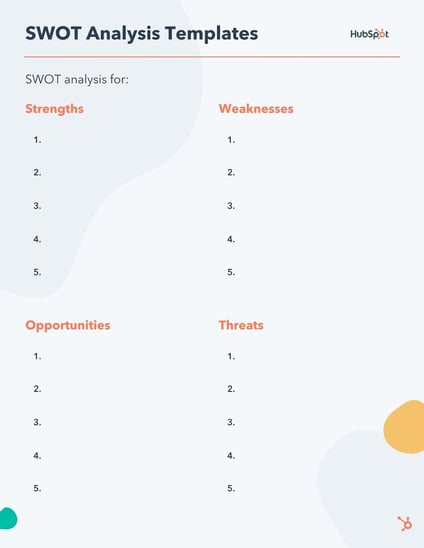
3. Identify your objective.
Before you start writing things down, you’ll need to figure out what you’re evaluating with your SWOT analysis.
Be specific about what you want to analyze. Otherwise, your SWOT analysis may end up being too broad, and you’ll get analysis paralysis as you are making your evaluations.
If you’re creating a new social media program, you’ll want to conduct an analysis to inform your content creation strategy. If you’re launching a new product, you’ll want to understand its potential positioning in the space. If you’re considering a brand redesign, you’ll want to consider existing and future brand conceptions.
All of these are examples of good reasons to conduct a SWOT analysis. By identifying your objective, you’ll be able to tailor your evaluation to get more actionable insights.
4. Identify your strengths.
“Strengths” refers to what you are currently doing well. Think about the factors that are going in your favor as well as the things you offer that your competitors just can’t beat.
For example, let’s say you want to use a SWOT analysis to evaluate your new social media strategy.
If you’re looking at a new social media program, perhaps you want to evaluate how your brand is perceived by the public. Is it easily recognizable and well-known? Even if it’s not popular with a widespread group, is it well-received by a specific audience?
Next, think about your process: Is it effective or innovative? Is there good communication between marketing and sales?
Finally, evaluate your social media message, and in particular, how it differs from the rest of the industry. I’m willing to bet you can make a lengthy list of some major strengths of your social media strategy over your competitors, so try to dive into your strengths from there.
5. Identify your weaknesses.
In contrast to your strengths, what are the roadblocks hindering you from reaching your goals? What do your competitors offer that continues to be a thorn in your side?
This section isn’t about dwelling on negative aspects. Rather, it’s critical to foresee any potential obstacles that could mitigate your success.
When identifying weaknesses, consider what areas of your business are the least profitable, where you lack certain resources, or what costs you the most time and money. Take input from employees in different departments, as they’ll likely see weaknesses you hadn’t considered.
If you’re examining a new social media strategy, you might start by asking yourself these questions: First, if I were a consumer, what would prevent me from buying this product, or engaging with this business? What would make me click away from the screen?
Second, what do I foresee as the biggest hindrance to my employees’ productivity, or their ability to get the job done efficiently? What derails their social media efforts?
6. Consider your opportunities.
This is your chance to dream big. What are some opportunities for your social media strategy you hope, but don’t necessarily expect, to reach?
For instance, maybe you’re hoping your Facebook ads will attract a new, larger demographic. Maybe you’re hoping your YouTube video gets 10,000 views and increases sales by 10%.
Whatever the case, it’s important to include potential opportunities in your SWOT analysis. Ask yourself these questions:
- What technologies do I want my business to use to make it more effective?
- What new target audience do I want to reach?
- How can the business stand out more in the current industry?
- Is there something our customers complain about that we could fix?
The opportunities category goes hand-in-hand with the weaknesses category. Once you’ve made a list of weaknesses, it should be easy to create a list of potential opportunities that could arise if you eliminate your weaknesses.
7. Contemplate your threats.
It’s likely, especially if you’re prone to worry, you already have a good list of threats in your head.
If not, gather your employees and brainstorm. Start with these questions:
- What obstacles might prevent us from reaching our goals?
- What’s going on in the industry, or with our competitors, that might mitigate our success?
- Is there new technology out there that could conflict with our product?
Writing down your threats helps you evaluate them objectively.
For instance, maybe you list your threats in terms of least and most likely to occur and divide and conquer each. If one of your biggest threats is your competitor’s popular Instagram account, you could work with your marketing department to create content that showcases your product’s unique features.
SWOT Analysis Chart
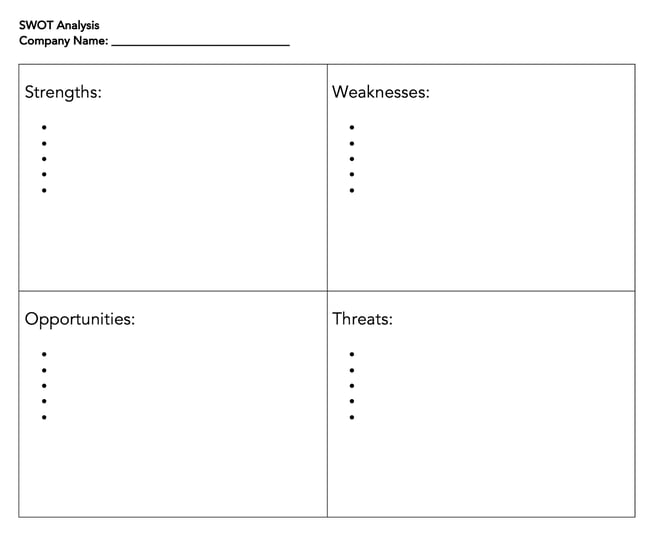
Download a free SWOT analysis chart included in HubSpot’s free market research kit .
A SWOT analysis doesn’t have to be fancy. Our SWOT analysis chart provides a clear and structured framework for capturing and organizing your internal strengths and weaknesses, and external opportunities and threats. It's the perfect visual aid to make sense of the wealth of information gathered during your analysis.
(Plus, you can always customize and paste it into a document you plan to share with stakeholders.)
But remember: Filling out the SWOT chart is just one step in the process. Combine it with our entire market research kit , and you'll have all the tools necessary to help your organization navigate new opportunities and threats.
SWOT Analysis Examples
The template above helps get you started on your own SWOT analysis.
But, if you’re anything like me, it’s not enough to see a template. To fully understand a concept, you need to see how it plays out in the real world.
These SWOT examples are not exhaustive. However, they are a great starting point to inspire you as you do your own SWOT analysis.
Apple’s SWOT analysis
Here’s how we’d conduct a SWOT analysis on Apple.

First off, strengths. While Apple has many strengths, let’s identify the top three:
- Brand recognition.
- Innovative products.
- Ease of use.
Apple’s brand is undeniably strong, and its business is considered the most valuable in the world . Since it’s easily recognized, Apple can produce new products and almost ensure a certain degree of success by virtue of the brand name itself.
Apple’s highly innovative products are often at the forefront of the industry. One thing that sets Apple apart from the competition is its product inter-connectivity.
For instance, an Apple user can easily sync their iPhone and iPad together. They can access all of their photos, contacts, apps, and more no matter which device they are using.
Lastly, customers enjoy how easy it is to use Apple’s products. With a sleek and simple design, each product is developed so that most people can quickly learn how to use them.
Next, let’s look at three of Apple’s weaknesses.
- High prices
- Closed ecosystem
- Lack of experimentation
While the high prices don’t deter Apple’s middle- and upper-class customer base, they do hinder Apple’s ability to reach a lower-class demographic.
Apple also suffers from its own exclusivity. Apple controls all its services and products in-house, and while many customers become loyal brand advocates for this reason, it means all burdens fall on Apple employees.
Ultimately, Apple’s tight control over who distributes its products limits its market reach.
Lastly, Apple is held to a high standard when it comes to creating and distributing products. Apple’s brand carries a high level of prestige. That level of recognition inhibits Apple from taking risks and experimenting freely with new products that could fail.
Now, let’s take a look at opportunities for Apple.
It’s easy to recognize opportunities for improvement, once you consider Apple’s weaknesses. Here’s a list of three we came up with:
- Expand distribution options.
- Create new product lines.
- Technological advancement.
One of Apple’s biggest weaknesses is its distribution network, which, in the name of exclusivity, remains relatively small. If Apple expanded its network and enabled third-party businesses to sell its products, it could reach more people globally, while alleviating some of the stress currently put on in-house employees.
There are also plenty of opportunities for Apple to create new products. Apple could consider creating more affordable products to reach a larger demographic, or spreading out into new industries — Apple self-driving cars, perhaps?
Finally, Apple could continue advancing its products’ technology. Apple can take existing products and refine them, ensuring each product offers as many unique features as possible.
Finally, let’s look at threats to Apple.
Believe it or not, they do exist.
Here are three of Apple’s biggest threats:
- Tough competition.
- International issues.
Apple isn’t the only innovative tech company out there, and it continues to face tough competition from Samsung, Google, and other major forces. In fact, Samsung sold more smartphones than Apple did in Q1 of 2022 , shipping 17 million more units than Apple and holding 24% of the market share.
Many of Apple’s weaknesses hinder Apple’s ability to compete with the tech corporations that have more freedom to experiment, or that don’t operate in a closed ecosystem.
A second threat to Apple is lawsuits. Apple has faced plenty of lawsuits, particularly between Apple and Samsung . These lawsuits interfere with Apple’s reputable image and could steer some customers to purchase elsewhere.
Finally, Apple needs to improve its reach internationally. The company isn’t number one in China and doesn’t have a very positive relationship with the Chinese government. In India, which has one of the largest consumer markets in the world, Apple’s market share is low , and the company has trouble bringing stores to India’s market.
If Apple can’t compete globally the way Samsung or Google can, it risks falling behind in the industry.
Starbucks SWOT Analysis
Now that we’ve explored the nuances involved with a SWOT analysis, let’s fill out a SWOT template using Starbucks as an example.
Here’s how we’d fill out a SWOT template if we were Starbucks:

Download this Template for Free
Restaurant Small Business SWOT Analysis
Some small business marketers may have difficulty relating to the SWOTs of big brands like Apple and Starbucks. Here’s an example of how a dine-in Thai restaurant might visualize each element.
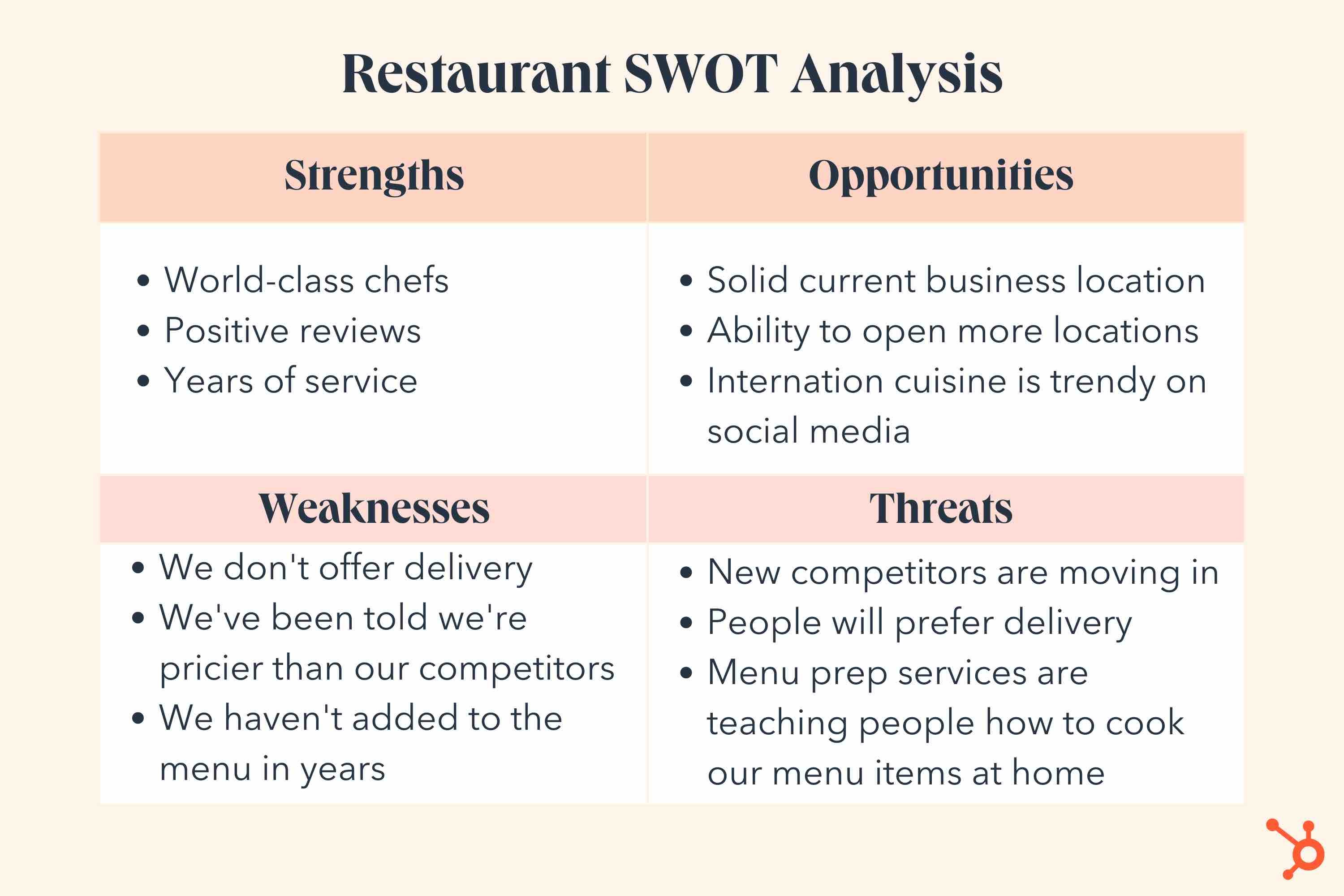
Small restaurants can lean into their culinary expertise and service skills to find opportunities for growth and brand awareness. A SWOT analysis can also help identify weaknesses that can be improved, such as menu variation and pricing.
While a restaurant might not be as worried about high-level lawsuits, a small business might be more concerned about competitors or disruptors that might enter the playing field.
Local Boutique SWOT Analysis
In another small business example, let’s take a look at a SWOT analysis for a local boutique.
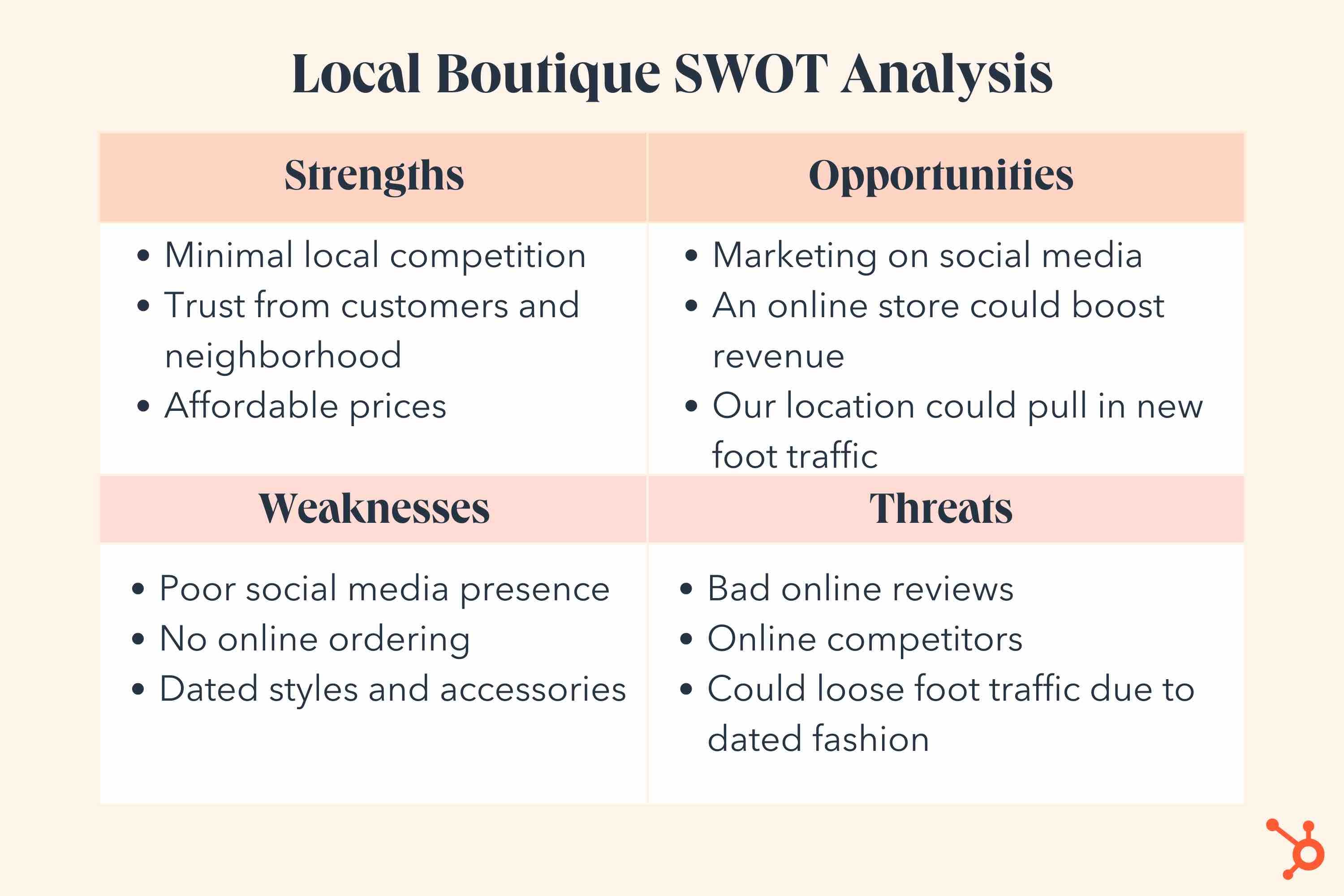
This shop might be well known in its neighborhood, but it also might take time to build an online presence or get its products in an online store.
Because of this, some of its strengths and opportunities might relate to physical factors while weaknesses and threats might relate to online situations.
How to Act on a SWOT Analysis
After conducting a SWOT analysis, you may be asking yourself: What’s next?
Putting together a SWOT analysis is only one step. Executing the findings identified by the analysis is just as important — if not more.
Put your insights into action using the following steps.
Take advantage of your strengths.
Use your strengths to pursue opportunities from your analysis.
For example, if we look at the local boutique example above, the strength of having affordable prices can be a value proposition. You can emphasize your affordable prices on social media or launch an online store.
Address your weaknesses.
Back to the boutique example, one of its weaknesses is having a poor social media presence. To mitigate this, the boutique could hire a social media consultant to improve its strategy. They may even tap into the expertise of a social-savvy employee.
Make note of the threats.
Threats are often external factors that can’t be controlled, so it’s best to monitor the threats outlined in your SWOT analysis to be aware of their impacts on your business.
When to Use a SWOT Analysis
While the examples above focus on business strategy in general, you can also use a SWOT analysis to evaluate and predict how a singular product will play out in the market.
Ultimately, a SWOT analysis can measure and tackle both big and small challenges, from deciding whether or not to launch a new product to refining your social media strategy.
Editor's note: This post was originally published in May 2018 and has been updated for comprehensiveness.

Don't forget to share this post!
Related articles.

Market Research: A How-To Guide and Template

20+ Tools & Resources for Conducting Market Research

What's a Competitive Analysis & How Do You Conduct One?

TAM SAM SOM: What Do They Mean & How Do You Calculate Them?
![swot analysis examples for business plan How to Run a Competitor Analysis [Free Guide]](https://blog.hubspot.com/hubfs/Google%20Drive%20Integration/how%20to%20do%20a%20competitor%20analysis_122022.jpeg)
How to Run a Competitor Analysis [Free Guide]
![swot analysis examples for business plan 5 Challenges Marketers Face in Understanding Audiences [New Data + Market Researcher Tips]](https://blog.hubspot.com/hubfs/challenges%20marketers%20face%20in%20understanding%20the%20customer%20.png)
5 Challenges Marketers Face in Understanding Audiences [New Data + Market Researcher Tips]

Causal Research: The Complete Guide

Total Addressable Market (TAM): What It Is & How You Can Calculate It

What Is Market Share & How Do You Calculate It?
![swot analysis examples for business plan 3 Ways Data Privacy Changes Benefit Marketers [New Data]](https://blog.hubspot.com/hubfs/how-data-privacy-benefits-marketers_1.webp)
3 Ways Data Privacy Changes Benefit Marketers [New Data]
Free Guide & Templates to Help Your Market Research
Marketing software that helps you drive revenue, save time and resources, and measure and optimize your investments — all on one easy-to-use platform
Plan Smarter, Grow Faster:
25% Off Annual Plans! Save Now

0 results have been found for “”
Return to blog home
What Is a SWOT Analysis and How to Do It Right (With Examples)
Posted february 2, 2021 by noah parsons.

A SWOT analysis is an incredibly simple, yet powerful tool to help you develop your business strategy, whether you’re building a startup or guiding an existing company.
What is a SWOT Analysis?
SWOT stands for Strengths, Weaknesses, Opportunities, and Threats.
Strengths and weaknesses are internal to your company—things that you have some control over and can change. Examples include who is on your team, your patents and intellectual property, and your location.
Opportunities and threats are external—things that are going on outside your company, in the larger market. You can take advantage of opportunities and protect against threats, but you can’t change them. Examples include competitors, prices of raw materials, and customer shopping trends.
A SWOT analysis organizes your top strengths, weaknesses, opportunities, and threats into an organized list and is usually presented in a simple two-by-two grid. Go ahead and download our free template if you just want to dive right in and get started.

Why do a SWOT Analysis?
When you take the time to do a SWOT analysis, you’ll be armed with a solid strategy for prioritizing the work that you need to do to grow your business.
You may think that you already know everything that you need to do to succeed, but a SWOT analysis will force you to look at your business in new ways and from new directions. You’ll look at your strengths and weaknesses, and how you can leverage those to take advantage of the opportunities and threats that exist in your market.
Who should do a SWOT Analysis?
For a SWOT analysis to be effective, company founders and leaders need to be deeply involved. This isn’t a task that can be delegated to others.
But, company leadership shouldn’t do the work on their own , either. For best results, you’ll want to gather a group of people who have different perspectives on the company. Select people who can represent different aspects of your company, from sales and customer service to marketing and product development. Everyone should have a seat at the table.
Innovative companies even look outside their own internal ranks when they perform a SWOT analysis and get input from customers to add their unique voice to the mix.
If you’re starting or running a business on your own, you can still do a SWOT analysis. Recruit additional points of view from friends who know a little about your business, your accountant, or even vendors and suppliers. The key is to have different points of view.
Existing businesses can use a SWOT analysis to assess their current situation and determine a strategy to move forward . But, remember that things are constantly changing and you’ll want to reassess your strategy, starting with a new SWOT analysis every six to 12 months.
For startups, a SWOT analysis is part of the business planning process. It’ll help codify a strategy so that you start off on the right foot and know the direction that you plan to go.
How to do a SWOT analysis the right way
As I mentioned above, you want to gather a team of people together to work on a SWOT analysis. You don’t need an all-day retreat to get it done, though. One or two hours should be more than plenty.
1. Gather the right people
Gather people from different parts of your company and make sure that you have representatives from every department and team. You’ll find that different groups within your company will have entirely different perspectives that will be critical to making your SWOT analysis successful.
2. Throw your ideas at the wall
Doing a SWOT analysis is similar to brainstorming meetings, and there are right and wrong ways to run them. I suggest giving everyone a pad of sticky-notes and have everyone quietly generate ideas on their own to start things off. This prevents groupthink and ensures that all voices are heard.
After five to 10 minutes of private brainstorming, put all the sticky-notes up on the wall and group similar ideas together. Allow anyone to add additional notes at this point if someone else’s idea sparks a new thought.
3. Rank the ideas
Once all of the ideas are organized, it’s time to rank the ideas. I like using a voting system where everyone gets five or ten “votes” that they can distribute in any way they like. Sticky dots in different colors are useful for this portion of the exercise.
Based on the voting exercise, you should have a prioritized list of ideas. Of course, the list is now up for discussion and debate, and someone in the room should be able to make the final call on the priority. This is usually the CEO, but it could be delegated to someone else in charge of business strategy.
You’ll want to follow this process of generating ideas for each of the four quadrants of your SWOT analysis: Strengths, Weaknesses, Opportunities, and Threats.
Questions that can help inspire your analysis
Here are a few questions that you can ask your team when you’re building your SWOT analysis. These questions can help explain each section and spark creative thinking.
Strengths are internal, positive attributes of your company. These are things that are within your control.
- What business processes are successful?
- What assets do you have in your teams? (ie. knowledge, education, network, skills, and reputation)
- What physical assets do you have, such as customers, equipment, technology, cash, and patents?
- What competitive advantages do you have over your competition?
Weaknesses are negative factors that detract from your strengths. These are things that you might need to improve on to be competitive.
- Are there things that your business needs to be competitive?
- What business processes need improvement?
- Are there tangible assets that your company needs, such as money or equipment?
- Are there gaps on your team?
- Is your location ideal for your success?
Opportunities
Opportunities are external factors in your business environment that are likely to contribute to your success.
- Is your market growing and are there trends that will encourage people to buy more of what you are selling?
- Are there upcoming events that your company may be able to take advantage of to grow the business?
- Are there upcoming changes to regulations that might impact your company positively?
- If your business is up and running, do customers think highly of you?
Threats are external factors that you have no control over. You may want to consider putting in place contingency plans for dealing with them if they occur.
- Do you have potential competitors who may enter your market?
- Will suppliers always be able to supply the raw materials you need at the prices you need?
- Could future developments in technology change how you do business?
- Is consumer behavior changing in a way that could negatively impact your business?
- Are there market trend s that could become a threat?
SWOT Analysis example
To help you get a better sense of what at SWOT example actually looks like, we’re going to look at UPer Crust Pies, a specialty meat and fruit pie cafe in Michigan’s Upper Peninsula. They sell hot, ready-to-go pies and frozen take-home options, as well as an assortment of fresh salads and beverages.
The company is planning to open its first location in downtown Yubetchatown and is very focused on developing a business model that will make it easy to expand quickly and that opens up the possibility of franchising. Here’s what their SWOT analysis might look like:
SWOT analysis for UPer Crust Pies

How to use your SWOT Analysis
With your SWOT analysis complete, you’re ready to convert it into a real strategy. After all, the exercise is about producing a strategy that you can work on during the next few months.
The first step is to look at your strengths and figure out how you can use those strengths to take advantage of your opportunities. Then, look at how your strengths can combat the threats that are in the market . Use this analysis to produce a list of actions that you can take.
With your action list in hand, look at your company calendar and start placing goals (or milestones) on it. What do you want to accomplish in each calendar quarter (or month) moving forward?
You’ll also want to do this by analyzing how external opportunities might help you combat your own, internal weaknesses. Can you also minimize those weaknesses so you can avoid the threats that you identified?
Again, you’ll have an action list that you’ll want to prioritize and schedule.
UPer Crust Pies — Potential strategies for growth
Back to the UPer Crust Pies example: Based on their SWOT analysis, here are a few potential strategies for growth to help you think through how to translate your SWOT into actionable goals.
- Investigate investors. UPer Crust Pies might investigate its options for obtaining capital.
- Create a marketing plan. Because UPer Crust Pies wants to execute a specific marketing strategy—targeting working families by emphasizing that their dinner option is both healthy and convenient—the company should develop a marketing plan.
- Plan a grand opening. A key piece of that marketing plan will be the store’s grand opening, and the promotional strategies necessary to get UPer Crust Pies’ target market in the door.
Next steps with your SWOT Analysis
With your goals and actions in hand, you’ll be a long way toward completing a strategic plan for your business. I like to use the Lean Planning methodology for strategic plans as well as regular business planning. The actions that you generate from your SWOT analysis will fit right into the milestones portion of your Lean Plan and will give you a concrete foundation that you can grow your business from. You can download our free Lean Plan template to help you get started.
If you have additional ideas for how a SWOT analysis can help your business and how it fits into your regular business planning, I’d love to hear from you. You can find me on Twitter @noahparsons .
Editor’s note: This article was originally published in 2018 and updated for 2021.
Like this post? Share with a friend!
Noah Parsons
Posted in management , growth & metrics, join over 1 million entrepreneurs who found success with liveplan, like this content sign up to receive more.
Subscribe for tips and guidance to help you grow a better, smarter business.
You're all set!
Exciting business insights and growth strategies will be coming your way each month.
We care about your privacy. See our privacy policy .

How it works
For Business
Join Mind Tools
Article • 17 min read
SWOT Analysis
Understanding your business, informing your strategy.
By the Mind Tools Content Team
What Is a SWOT Analysis?
SWOT stands for Strengths, Weaknesses, Opportunities, and Threats, and so a SWOT analysis is a technique for assessing these four aspects of your business.
SWOT Analysis is a tool that can help you to analyze what your company does best now, and to devise a successful strategy for the future. SWOT can also uncover areas of the business that are holding you back, or that your competitors could exploit if you don't protect yourself.
A SWOT analysis examines both internal and external factors – that is, what's going on inside and outside your organization. So some of these factors will be within your control and some will not. In either case, the wisest action you can take in response will become clearer once you've discovered, recorded and analyzed as many factors as you can.
In this article, video and infographic, we explore how to carry out a SWOT analysis, and how to put your findings into action. We also include a worked example and a template to help you get started on a SWOT analysis in your own workplace.
Why Is SWOT Analysis Important?
SWOT Analysis can help you to challenge risky assumptions and to uncover dangerous blindspots about your organization's performance. If you use it carefully and collaboratively, it can deliver new insights on where your business currently is, and help you to develop exactly the right strategy for any situation.
For example, you may be well aware of some of your organization's strengths, but until you record them alongside weaknesses and threats you might not realize how unreliable those strengths actually are.
Equally, you likely have reasonable concerns about some of your business weaknesses but, by going through the analysis systematically, you could find an opportunity, previously overlooked, that could more than compensate.
How to Write a SWOT Analysis
SWOT analysis involves making lists – but so much more, too! When you begin to write one list (say, Strengths), the thought process and research that you'll go through will prompt ideas for the other lists (Weaknesses, Opportunities or Threats). And if you compare these lists side by side, you will likely notice connections and contradictions, which you'll want to highlight and explore.
You'll find yourself moving back and forth between your lists frequently. So, make the task easier and more effective by arranging your four lists together in one view.
A SWOT matrix is a 2x2 grid, with one square for each of the four aspects of SWOT. (Figure 1 shows what it should look like.) Each section is headed by some questions to get your thinking started.
Figure 1. A SWOT Analysis Matrix.
Swot analysis template.
When conducting your SWOT analysis, you can either draw your own matrix, or use our free downloadable template .
How to Do a SWOT Analysis
Avoid relying on your own, partial understanding of your organization. Your assumptions could be wrong. Instead, gather a team of people from a range of functions and levels to build a broad and insightful list of observations.
Then, every time you identify a Strength, Weakness, Opportunity, or Threat, write it down in the relevant part of the SWOT analysis grid for all to see.
Let's look at each area in more detail and consider what fits where, and what questions you could ask as part of your data gathering.
Strengths are things that your organization does particularly well, or in a way that distinguishes you from your competitors. Think about the advantages your organization has over other organizations. These might be the motivation of your staff, access to certain materials, or a strong set of manufacturing processes.
Your strengths are an integral part of your organization, so think about what makes it "tick." What do you do better than anyone else? What values drive your business? What unique or lowest-cost resources can you draw upon that others can't? Identify and analyze your organization's Unique Selling Proposition (USP), and add this to the Strengths section.
Then turn your perspective around and ask yourself what your competitors might see as your strengths. What factors mean that you get the sale ahead of them?
Remember, any aspect of your organization is only a strength if it brings you a clear advantage. For example, if all of your competitors provide high-quality products, then a high-quality production process is not a strength in your market: it's a necessity.
Weaknesses, like strengths, are inherent features of your organization, so focus on your people, resources, systems, and procedures. Think about what you could improve, and the sorts of practices you should avoid.
Once again, imagine (or find out) how other people in your market see you. Do they notice weaknesses that you tend to be blind to? Take time to examine how and why your competitors are doing better than you. What are you lacking?
Be honest! A SWOT analysis will only be valuable if you gather all the information you need. So, it's best to be realistic now, and face any unpleasant truths as soon as possible.
Opportunities
Opportunities are openings or chances for something positive to happen, but you'll need to claim them for yourself!
They usually arise from situations outside your organization, and require an eye to what might happen in the future. They might arise as developments in the market you serve, or in the technology you use. Being able to spot and exploit opportunities can make a huge difference to your organization's ability to compete and take the lead in your market.
Think about good opportunities that you can exploit immediately. These don't need to be game-changers: even small advantages can increase your organization's competitiveness. What interesting market trends are you aware of, large or small, which could have an impact?
You should also watch out for changes in government policy related to your field. And changes in social patterns, population profiles, and lifestyles can all throw up interesting opportunities.
Threats include anything that can negatively affect your business from the outside, such as supply-chain problems, shifts in market requirements, or a shortage of recruits. It's vital to anticipate threats and to take action against them before you become a victim of them and your growth stalls.
Think about the obstacles you face in getting your product to market and selling. You may notice that quality standards or specifications for your products are changing, and that you'll need to change those products if you're to stay in the lead. Evolving technology is an ever-present threat, as well as an opportunity!
Always consider what your competitors are doing, and whether you should be changing your organization's emphasis to meet the challenge. But remember that what they're doing might not be the right thing for you to do. So, avoid copying them without knowing how it will improve your position.
Be sure to explore whether your organization is especially exposed to external challenges. Do you have bad debt or cash-flow problems, for example, that could make you vulnerable to even small changes in your market? This is the kind of threat that can seriously damage your business, so be alert.
Use PEST Analysis to ensure that you don't overlook threatening external factors. And PMESII-PT is an especially helpful check in very unfamiliar or uncertain environments.
Frequently Asked Questions About SWOT Analysis
1. who invented swot analysis.
Many people attribute SWOT Analysis to Albert S. Humphrey. However, there has been some debate on the originator of the tool, as discussed in the International Journal of Business Research .
2. What Does SWOT Analysis Stand For?
SWOT Analysis stands for Strengths, Weaknesses, Opportunities and Threats.
3. What Can a SWOT Analysis Be Used For?
SWOT analysis is a useful tool to help you determine your organization's position in the market. You can then use this information to create an informed strategy suited to your needs and capabilities.
4. How Do I Write a SWOT Analysis?
To conduct a SWOT analysis, you first need to create a 2x2 matrix grid. Each square is then assigned to one of the four aspects of SWOT. You can either draw this grid yourself or use our downloadable template to get started.
5. How Do SWOT Analysis and the TOWS Matrix compare?
While SWOT analysis puts the emphasis on the internal environment (your strengths and weaknesses), TOWS forces you to look at your external environment first (your threats and opportunities). In most cases, you'll do a SWOT Analysis first, and follow up with a TOWS Matrix to offer a broader context.
6. What Are the Biggest SWOT Analysis Mistakes?
- Making your lists too long. Ask yourself if your ideas are feasible as you go along.
- Being vague. Be specific to provide more focus for later discussions.
- Not seeing weaknesses. Be sure to ask customers and colleagues what they experience in real life.
- Not thinking ahead. It's easy to come up with nice ideas without taking them through to their logical conclusion. Always consider their practical impact.
- Being unrealistic. Don't plan in detail for opportunities that don't exist yet. For example, that export market you've been eyeing may be available at some point, but the trade negotiations to open it up could take years.
- Relying on SWOT Analysis alone. SWOT Analysis is valuable. But when you use it alongside other planning tools (SOAR, TOWS or PEST), the results will be more vigorous.
How to Use a SWOT Analysis
Use a SWOT Analysis to assess your organization's current position before you decide on any new strategy. Find out what's working well, and what's not so good. Ask yourself where you want to go, how you might get there – and what might get in your way.
Once you've examined all four aspects of SWOT, you'll want to build on your strengths, boost your weaker areas, head off any threats, and exploit every opportunity. In fact, you'll likely be faced with a long list of potential actions.
But before you go ahead, be sure to develop your ideas further. Look for potential connections between the quadrants of your matrix. For example, could you use some of your strengths to open up further opportunities? And, would even more opportunities become available by eliminating some of your weaknesses?
Finally, it's time to ruthlessly prune and prioritize your ideas, so that you can focus time and money on the most significant and impactful ones. Refine each point to make your comparisons clearer. For example, only accept precise, verifiable statements such as, "Cost advantage of $30/ton in sourcing raw material x," rather than, "Better value for money."
Remember to apply your learnings at the right level in your organization. For example, at a product or product-line level, rather than at the much vaguer whole-company level. And use your SWOT analysis alongside other strategy tools (for example, Core Competencies Analysis ), so that you get a comprehensive picture of the situation you're dealing with.
A SWOT Analysis Example
Imagine this scenario: a small start-up consultancy wants a clear picture of its current situation, to decide on a future strategy for growth. The team gathers, and draws up the SWOT Analysis shown in Figure 2.
Figure 2. A Completed SWOT Analysis.
As a result of the team's analysis, it's clear that the consultancy's main strengths lie in its agility, technical expertise, and low overheads. These allow it to offer excellent customer service to a relatively small client base.
The company's weaknesses are also to do with its size. It will need to invest in training, to improve the skills base of the small staff. It'll also need to focus on retention, so it doesn't lose key team members.
There are opportunities in offering rapid-response, good-value services to local businesses and to local government organizations. The company can likely be first to market with new products and services, given that its competitors are slow adopters.
The threats require the consultancy to keep up-to-date with changes in technology. It also needs to keep a close eye on its largest competitors, given its vulnerability to large-scale changes in its market. To counteract this, the business needs to focus its marketing on selected industry websites, to get the greatest possible market presence on a small advertising budget.
It's also possible to carry out a Personal SWOT Analysis . This can be useful for developing your career in ways that take best advantage of your talents, abilities and opportunities.
SWOT Analysis Infographic
See SWOT Analysis represented in our infographic :
SWOT Analysis helps you to identify your organization's Strengths, Weaknesses, Opportunities, and Threats.
It guides you to build on what you do well, address what you're lacking, seize new openings, and minimize risks.
Apply a SWOT Analysis to assess your organization's position before you decide on any new strategy.
Use a SWOT matrix to prompt your research and to record your ideas. Avoid making huge lists of suggestions. Be as specific as you can, and be honest about your weaknesses.
Be realistic and rigorous. Prune and prioritize your ideas, to focus time and money on the most significant and impactful actions and solutions. Complement your use of SWOT with other tools.
Collaborate with a team of people from across the business. This will help to uncover a more accurate and honest picture.
Find out what's working well, and what's not so good. Ask yourself where you want to go, how you might get there – and what might get in your way.
Download Template Worksheet
You've accessed 1 of your 2 free resources.
Get unlimited access
Discover more content
Personal swot analysis.
Seeing Strengths, Weaknesses, Opportunities, and Threats
Add comment
Comments (2)
SWOT is useless. When you try it and you find Weaknesses box bulging, but Strengths & Opportunities completely empty, what can that possibly achieve?
Leslie Bartnicki
The love of my life for 15 years was diagnosed 2 years ago at age 54. Symptoms were tremor in right leg, loss of handwriting ability, and soft voice. He also have difficulty rising from a seated position and have balance issues. he started out taking only Azilect, then Mirapex, and 6 months ago Sinemet. Several months ago he started falling frequently, hence the reason for Sinemet. We tried every shots available but nothing worked. In March 2023, my neurologist and I decided to go with natural treatment and was introduced to Natural Herbs Centre Ayurvedic organic Parkinson’s protocol, he had a total decline of symptoms with this treatment, the Tremor, falling frequently, stiffness, body weakness, balance issues, depression and others has subsided. Visit Natural Herbs Centre official website naturalherbscentre. com. This treatment is a breakthrough for all suffering from Parkinson’s, don’t give up Hope. Keep Sharing the Awareness, herbs are truly gift from God. I can personally vouch for these remedy but you would probably need to decide what works best for you

Get 20% off your first year of Mind Tools
Our on-demand e-learning resources let you learn at your own pace, fitting seamlessly into your busy workday. Join today and save with our limited time offer!
Sign-up to our newsletter
Subscribing to the Mind Tools newsletter will keep you up-to-date with our latest updates and newest resources.
Subscribe now
Business Skills
Personal Development
Leadership and Management
Most Popular
Newest Releases

Team Management Skills

5 Phrases That Kill Collaboration
Mind Tools Store
About Mind Tools Content
Discover something new today
How do i manage a hybrid team.
Adjusting your management style to a hybrid world
The Life Career Rainbow
Finding a Work-Life Balance That Suits You
How Emotionally Intelligent Are You?
Boosting Your People Skills
Self-Assessment
What's Your Leadership Style?
Learn About the Strengths and Weaknesses of the Way You Like to Lead
Recommended for you
The leader-member exchange theory.
Getting the Best From All Team Members
Business Operations and Process Management
Strategy Tools
Customer Service
Business Ethics and Values
Handling Information and Data
Project Management
Knowledge Management
Self-Development and Goal Setting
Time Management
Presentation Skills
Learning Skills
Career Skills
Communication Skills
Negotiation, Persuasion and Influence
Working With Others
Difficult Conversations
Creativity Tools
Self-Management
Work-Life Balance
Stress Management and Wellbeing
Coaching and Mentoring
Change Management
Team Management
Managing Conflict
Delegation and Empowerment
Performance Management
Leadership Skills
Developing Your Team
Talent Management
Problem Solving
Decision Making
Pain Points
BRAND NEW Two-Day LIVE Summit with 20+ Ecommerce Trailblazers.
- Skip to primary navigation
- Skip to main content
A magazine for young entrepreneurs
The best advice in entrepreneurship
Subscribe for exclusive access, swot analysis: definition, examples, and step-by-step guide.

Written by Mary Kate Miller | June 29, 2021
Comments -->

Get real-time frameworks, tools, and inspiration to start and build your business. Subscribe here
A SWOT analysis can help a small business owner or business assess a company’s position to determine the most optimal strategy going forward. This business practice can help you identify what you’re doing well, what you want to do better, and what kinds of obstacles you might encounter along the way.
This guide will walk you through everything you need to know about a SWOT analysis: what it is, how it works, and how to do it. We’ll also include an example and a template to help guide you as you perform your own SWOT analysis.
What Is a SWOT Analysis?
A SWOT analysis is a strategic planning technique that outlines an organization’s strengths, weaknesses, opportunities, and threats. Assessing business competition in this way can help an organization plan strategically and execute more effectively.
The 4 Parts of a SWOT Analysis
Your business’s strengths SWOT section should include anything that your business does differently or better than competitors. Think about your unique value proposition, trends you’ve noticed in positive customer feedback, operational strengths, and company culture. This section is the perfect place to name and celebrate anything you’re already doing well.
Don’t be afraid to toot your own horn (while also remaining objective). Clearly identifying your business’s strengths not only helps you keep your spirits balanced as you address your weaknesses, it will also give you a sense of where to concentrate your resources. It’s easier to build a successful business when you’re working towards something, rather than acting in opposition.
Questions to help you determine your strengths:
- What is your business’s unique value proposition?
- What common compliments do you receive from your customers?
- What does your business do particularly well?
- How do you operate differently from your competitors?
- What gives you an edge on the competition ? (This can include something product-related like “better access to raw materials” or “lower cost of goods,” or it can be an internal strength like “strong company culture” or “employee motivation.”)
- What might your competitors name as your strengths?
Your weaknesses are the areas in which the business has room for improvement. You should include structural weaknesses in this section—those that relate to your systems, procedures, resources, and personnel. This is a great place to look at common feedback from employees (either from exit interviews, anonymous surveys, or other sources) and recurring customer complaints.
Questions to help you determine your weaknesses:
- What areas of your business could stand to improve?
- What are common hiccups in your customer experience ?
- How do you use your resources? Is there room for improvement?
- What improvements are needed in your employee experience?
- What weaknesses might your customers see that you tend to overlook?
- What weaknesses might your competitors think you have?
Opportunities
Your opportunities are the positive, external factors that your business might benefit from… but cannot directly control. That might include market opportunities, consumer purchasing trends, legal or regulatory changes, population changes, the cost of raw materials, and more. For example, businesses that provide accessibility for aging seniors might recognize the forthcoming “silver tsunami” of Baby Boomers entering the target demographic. This would be a clear opportunity to expand their customer base.
Questions to help you determine your opportunities:
- What trends might affect your industry?
- How might the right talent create new opportunities?
- your customers ask for anything you don’t offer (but could)?
- How might population changes affect your business opportunities? (think: generational shifts)
- Is there a need in the industry that you’re not creating, but could?
- Do your competitors have any weaknesses that could be opportunities for you?
- Is there a way to repackage current products to demand a higher price?
- Are there any new, or potential, regulatory or tax changes that might provide a new opportunity?
Your threats are the external factors that have the potential to negatively affect your business. A threat can be specific and competitor-based or more structural. buy clomid online buy clomid online no prescription Examples of structural threats could be supply chain challenges, shifts in market requirements, talent shortages, or changes to social media algorithms (especially if your business heavily relies on social media marketing). You might also face a threat (or threats) from your competitors. This can include the way they operate, how they’re marketing, or the products they offer.
Identifying every external threat your business faces is essential for your business to identify how it must adapt in order to meet and overcome these challenges.
Questions to help you determine threats:
- What happens if a supplier or manufacturer runs out of materials you use?
- What if a natural disaster (like a pandemic) strikes? buy amitriptyline online buy amitriptyline online no prescription
- Is your market shrinking?
- What are your competitors offering? Are they expanding or offering different products?
- How are your competitors marketing?
- What technological threats are you vulnerable to (website security, social media algorithm changes)?
- Are there any businesses that aren’t competitors now but could become competitors in the future?
The Benefits of a SWOT Analysis
SWOT analyses offer a variety of benefits for businesses and personal brands. Here are some of the most common benefits of a SWOT analysis:
- You can use it to determine a strategic plan.
- You can use it to drive an innovative, informed marketing plan.
- It can help you identify external opportunities.
- It can help you identify external threats.
- It can reveal environmental factors that might affect your business, either positively or negatively.
- You can develop a plan for how to tackle internal weaknesses.
How to Do a SWOT Analysis
You can approach SWOT analyses in multiple ways. You can conduct a personal SWOT analysis for yourself as an individual, you can perform a marketing SWOT analysis to determine a competitive advantage in your marketing , or you can use a SWOT analysis as a part of broader strategic planning.
Whatever your end goal for a SWOT analysis, follow these steps.
1. Create a SWOT Matrix
Use a SWOT template or create your own. You can create your SWOT framework on the computer or on a whiteboard—if you choose to do the latter, be sure that someone is in charge of recording the responses so that you don’t lose key insights (you can also take a picture at the end of the SWOT session).

2. Assemble Key Stakeholders
A SWOT analysis is most effective when it collects a variety of perspectives. Gathering key stakeholders with various perspectives will help you see more than you would have seen alone. Marketing leaders might be able to give you a more specific sense of the opportunities and threats related to your content marketing efforts. Your people team is closest to all personnel changes and feedback, so they’ll have the clearest sense of an organization’s strengths and what is driving employee retention (or challenging it). Sales leaders can help translate opportunities into a cohesive business strategy.
It’s simple: when it comes to a SWOT analysis, more heads are better than one.
3. Brainstorm Around Your Companies’ Strengths, Weaknesses, Opportunities, and Threats
Go through each field of the SWOT diagram, spending some time with each one. Ask the group the guiding questions to ensure you’re developing a comprehensive picture of the internal and external environment. There are no bad ideas in brainstorming. You’re just trying to get thoughts flowing. Something that feels like a “bad idea” might lead to discovering a potential threat you’d never thought of before or nuanced analysis of how you stack up to your nearest competitor. The key here is to keep the brainstorm going.
4. Record Relevant Thoughts in Their Respective Sections
As you brainstorm, record points and ideas when they are relevant. At the end of the session, your SWOT analysis should leave you with a clear sense of the organization’s strengths and company’s weaknesses that you can use to guide your strategy formulation.
5. Edit Your List
Revisit the SWOT diagram at a later time and edit it, culling out anything you don’t really need. You can also polish up some of the key insights gleaned in the brainstorming session. This is especially important if you plan to use your SWOT analysis as a more formal document that might be disseminated broadly.
6. Create a More Formal Version (Optional)
The final step, if you choose to do it, is to take your SWOT takeaways and put them together in a polished document that you can share.
A SWOT Analysis Example
It can be easier to understand how to approach a SWOT analysis if you’ve seen a SWOT analysis example. For the sake of this example, we will imagine a hypothetical company and what its SWOT analysis might look like.
The Business
An Instagram-friendly fitness business offering virtual workouts.
- The business is not limited to a specific geographic area.
- The company offers great benefits so employees tend to stay.
- Workouts look really good, so they market well on social media (particularly Instagram).
- The app experience can be glitchy.
- High customer churn rate.
- Competitors let you filter classes by the instructor. Ours doesn’t offer that.
- There is growing interest in our type of workout.
- As a result of the pandemic, consumers are more interested in at-home workouts.
- We could start offering retail products and branded workout equipment like our competitors do.
- Our app is vulnerable to hacking.
- If Instagram changes its algorithm, we may become wholly dependent on paid ads instead of organic posts.
A SWOT Analysis Template
Use this template to create your own SWOT analysis.
Strengths Section: What Your Company Does Well
Weaknesses section: what your company could improve, opportunities section: external factors you could use to your advantage, threats section: external factors that could harm your business, owning the hard truths of a swot analysis.
A SWOT analysis can bring up a lot of hard truths. It’s difficult to confront your company’s weaknesses and sometimes looking at threats can make them feel like the existential kind. Overcome these obstacles and give yourself the fortitude to confront business challenges head on with the Mental Toughness mini-course. The best part? It’s free.

About Mary Kate Miller
Mary Kate Miller writes about small business, real estate, and finance. In addition to writing for Foundr, her work has been published by The Washington Post, Teen Vogue, Bustle, and more. She lives in Chicago.
Related Posts

How to Find USA Suppliers

How to Find Chinese Manufacturers to Bring Your Product to Life

AI Tools For Business: 6 Tools to Start from Scratch With

Business Not Making Money? Here’s the Reason(s) Why

What Is MOQ (Minimum Order Quantity)? Learn How It Impacts Your Business.

What Is a Wholesaler? Everything You Need To Know

What Is ROI? And How Can You Calculate It like a Pro?

Jessica Rolph Says Your Subscription Product Needs Purpose

34 Real Ways to Make Money from Home

54 Good Business Ideas That Could Be Your Next Big Thing

What to Sell on Amazon: 9 Tips to Find Profitable Products

Customer Retention Is More Important Than Leads. Here’s Why.

How Hismile Transformed from Internet Sensation into a Category Contender

Profit and Loss Statement: What Is It and Why Your Business Needs One

How Much Do Consultants Make? Get Ready to Consult.
FREE TRAINING FROM LEGIT FOUNDERS
Actionable Strategies for Starting & Growing Any Business.
How to Do a SWOT Analysis for Better Strategic Planning

6 min. read
Updated October 27, 2023
Conducting a SWOT analysis of your business is a lot more fun than it sounds. It won’t take much time, and doing it forces you to think about your business in a whole new way.
The point of a SWOT analysis is to help you develop a strong business strategy by making sure you’ve considered all of your business’s strengths and weaknesses, as well as the opportunities and threats it faces in the marketplace.

- What is a SWOT analysis?
S.W.O.T. is an acronym that stands for Strengths, Weaknesses, Opportunities, and Threats. A SWOT analysis is an organized list of your business’s greatest strengths, weaknesses, opportunities, and threats.
Strengths and weaknesses are internal to the company (think: reputation, patents, location). You can change them over time but not without some work. Opportunities and threats are external (think: suppliers, competitors, prices)—they are out there in the market, happening whether you like it or not. You can’t change them.
Existing businesses can use a SWOT analysis, at any time, to assess a changing environment and respond proactively. In fact, I recommend conducting a strategy review meeting at least once a year that begins with a SWOT analysis.
New businesses should use a SWOT analysis as a part of their planning process. There is no “one size fits all” plan for your business, and thinking about your new business in terms of its unique “SWOTs” will put you on the right track right away, and save you from a lot of headaches later on.
Looking to get started right away? Download our free SWOT Analysis template.
In this article, I will cover the following:
- How to conduct a SWOT analysis
- Questions to ask during a SWOT analysis
- Example of a SWOT analysis
- TOWS analysis: Developing strategies for your SWOT analysis
To get the most complete, objective results, a SWOT analysis is best conducted by a group of people with different perspectives and stakes in your company. Management, sales, customer service, and even customers can all contribute valid insight. Moreover, the SWOT analysis process is an opportunity to bring your team together and encourage their participation in and adherence to your company’s resulting strategy.
A SWOT analysis is typically conducted using a four-square SWOT analysis template, but you could also just make lists for each category. Use the method that makes it easiest for you to organize and understand the results.
I recommend holding a brainstorming session to identify the factors in each of the four categories. Alternatively, you could ask team members to individually complete our free SWOT analysis template, and then meet to discuss and compile the results. As you work through each category, don’t be too concerned about elaborating at first; bullet points may be the best way to begin. Just capture the factors you believe are relevant in each of the four areas.
Once you are finished brainstorming, create a final, prioritized version of your SWOT analysis, listing the factors in each category in order of highest priority at the top to lowest priority at the bottom.
Brought to you by
Create a professional business plan
Using ai and step-by-step instructions.
Secure funding
Validate ideas
Build a strategy
I’ve compiled some questions below to help you develop each section of your SWOT analysis. There are certainly other questions you could ask; these are just meant to get you started.
Strengths (internal, positive factors)
Strengths describe the positive attributes, tangible and intangible, internal to your organization. They are within your control.
- What do you do well?
- Positive attributes of people , such as knowledge, background, education, credentials, network, reputation, or skills.
- Tangible assets of the company , such as capital, credit, existing customers or distribution channels, patents, or technology.
- What advantages do you have over your competition?
- Do you have strong research and development capabilities? Manufacturing facilities?
- What other positive aspects, internal to your business, add value or offer you a competitive advantage?
Weaknesses (internal, negative factors)
Weaknesses are aspects of your business that detract from the value you offer or place you at a competitive disadvantage. You need to enhance these areas in order to compete with your best competitor.
- What factors that are within your control detract from your ability to obtain or maintain a competitive edge?
- What areas need improvement to accomplish your objectives or compete with your strongest competitor?
- What does your business lack (for example, expertise or access to skills or technology)?
- Does your business have limited resources?
- Is your business in a poor location?
Opportunities (external, positive factors)
Opportunities are external attractive factors that represent reasons your business is likely to prosper.
- What opportunities exist in your market or the environment that you can benefit from?
- Is the perception of your business positive?
- Has there been recent market growth or have there been other changes in the market the create an opportunity?
- Is the opportunity ongoing, or is there just a window for it? In other words, how critical is your timing?
Threats (external, negative factors)
Threats include external factors beyond your control that could place your strategy, or the business itself, at risk. You have no control over these, but you may benefit by having contingency plans to address them if they should occur.
- Who are your existing or potential competitors?
- What factors beyond your control could place your business at risk?
- Are there challenges created by an unfavorable trend or development that may lead to deteriorating revenues or profits?
- What situations might threaten your marketing efforts?
- Has there been a significant change in supplier prices or the availability of raw materials?
- What about shifts in consumer behavior, the economy, or government regulations that could reduce your sales?
- Has a new product or technology been introduced that makes your products, equipment, or services obsolete?
- Examples of a SWOT analysis
For illustration, here’s a brief SWOT example from a hypothetical, medium-sized computer store in the United States:
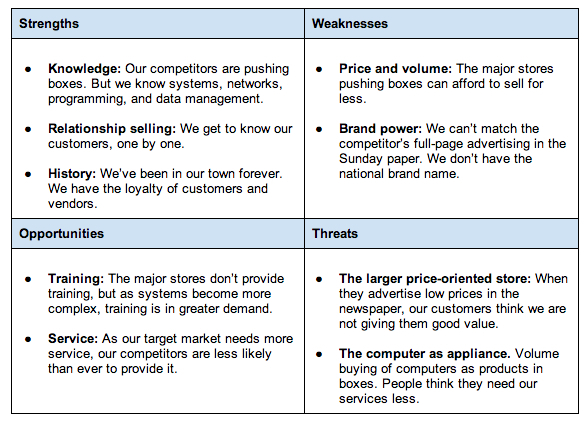
See our SWOT analysis examples article for in-depth examples of SWOT analyses for several different industries and business types or download our free SWOT analysis template .
- TOWS analysis: Developing strategies from your SWOT analysis
Once you have identified and prioritized your SWOT results, you can use them to develop short-term and long-term strategies for your business. After all, the true value of this exercise is in using the results to maximize the positive influences on your business and minimize the negative ones.
But how do you turn your SWOT results into strategies? One way to do this is to consider how your company’s strengths, weaknesses, opportunities, and threats overlap with each other. This is sometimes called a TOWS analysis.
For example, look at the strengths you identified, and then come up with ways to use those strengths to maximize the opportunities (these are strength-opportunity strategies). Then, look at how those same strengths can be used to minimize the threats you identified (these are strength-threats strategies).
Continuing this process, use the opportunities you identified to develop strategies that will minimize the weaknesses (weakness-opportunity strategies) or avoid the threats (weakness-threats strategies).
The following table might help you organize the strategies in each area:
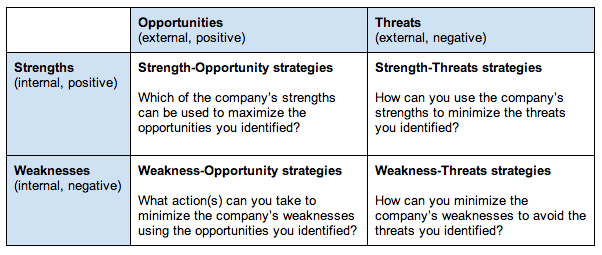
Once you’ve developed strategies and included them in your strategic plan, be sure to schedule regular review meetings. Use these meetings to talk about why the results of your strategies are different from what you’d planned (because they always will be) and decide what your team will do going forward.
See why 1.2 million entrepreneurs have written their business plans with LivePlan
Tim Berry is the founder and chairman of Palo Alto Software , a co-founder of Borland International, and a recognized expert in business planning. He has an MBA from Stanford and degrees with honors from the University of Oregon and the University of Notre Dame. Today, Tim dedicates most of his time to blogging, teaching and evangelizing for business planning.

Table of Contents
Related Articles

9 Min. Read
Craft your sales plan

4 Min. Read
Create a positioning statement

3 Min. Read
Outline your marketing strategy

Create a unique value proposition
The Bplans Newsletter
The Bplans Weekly
Subscribe now for weekly advice and free downloadable resources to help start and grow your business.
We care about your privacy. See our privacy policy .

The quickest way to turn a business idea into a business plan
Fill-in-the-blanks and automatic financials make it easy.
No thanks, I prefer writing 40-page documents.

Discover the world’s #1 plan building software
- Search Search Please fill out this field.
What Is SWOT Analysis?
Understanding swot analysis, how to do a swot analysis, the bottom line.
- Fundamental Analysis
SWOT Analysis: How To With Table and Example
These frameworks are essential to fundamentally analyzing companies
:max_bytes(150000):strip_icc():format(webp)/wk_headshot_aug_2018_02__william_kenton-5bfc261446e0fb005118afc9.jpg)
Ariel Courage is an experienced editor, researcher, and former fact-checker. She has performed editing and fact-checking work for several leading finance publications, including The Motley Fool and Passport to Wall Street.
:max_bytes(150000):strip_icc():format(webp)/ArielCourage-50e270c152b046738d83fb7355117d67.jpg)
SWOT (strengths, weaknesses, opportunities, and threats) analysis is a framework used to evaluate a company's competitive position and to develop strategic planning. SWOT analysis assesses internal and external factors, as well as current and future potential.
A SWOT analysis is designed to facilitate a realistic, fact-based, data-driven look at the strengths and weaknesses of an organization, initiatives, or within its industry. The organization needs to keep the analysis accurate by avoiding pre-conceived beliefs or gray areas and instead focusing on real-life contexts. Companies should use it as a guide and not necessarily as a prescription.
Subscribe to 'Term of the Day' and learn a new financial term every day. Stay informed and make smart financial decisions. Sign up now .
Key Takeaways
- SWOT analysis is a strategic planning technique that provides assessment tools.
- Identifying core strengths, weaknesses, opportunities, and threats leads to fact-based analysis, fresh perspectives, and new ideas.
- A SWOT analysis pulls information internal sources (strengths of weaknesses of the specific company) as well as external forces that may have uncontrollable impacts to decisions (opportunities and threats).
- SWOT analysis works best when diverse groups or voices within an organization are free to provide realistic data points rather than prescribed messaging.
- Findings of a SWOT analysis are often synthesized to support a single objective or decision that a company is facing.
Investopedia / Xiaojie Liu
SWOT analysis is a technique for assessing the performance, competition, risk, and potential of a business, as well as part of a business such as a product line or division, an industry, or other entity.
Using internal and external data , the technique can guide businesses toward strategies more likely to be successful, and away from those in which they have been, or are likely to be, less successful. Independent SWOT analysts, investors, or competitors can also guide them on whether a company, product line, or industry might be strong or weak and why.
SWOT analysis was first used to analyze businesses. Now, it's often used by governments, nonprofits, and individuals, including investors and entrepreneurs. There is seemingly limitless applications to the SWOT analysis.
Components of SWOT Analysis
Every SWOT analysis will include the following four categories. Though the elements and discoveries within these categories will vary from company to company, a SWOT analysis is not complete without each of these elements:
Strengths describe what an organization excels at and what separates it from the competition : a strong brand, loyal customer base, a strong balance sheet, unique technology, and so on. For example, a hedge fund may have developed a proprietary trading strategy that returns market-beating results. It must then decide how to use those results to attract new investors.
Weaknesses stop an organization from performing at its optimum level. They are areas where the business needs to improve to remain competitive: a weak brand, higher-than-average turnover, high levels of debt, an inadequate supply chain, or lack of capital.
Opportunities
Opportunities refer to favorable external factors that could give an organization a competitive advantage. For example, if a country cuts tariffs, a car manufacturer can export its cars into a new market, increasing sales and market share .
Threats refer to factors that have the potential to harm an organization. For example, a drought is a threat to a wheat-producing company, as it may destroy or reduce the crop yield. Other common threats include things like rising costs for materials, increasing competition, tight labor supply. and so on.
Analysts present a SWOT analysis as a square segmented into four quadrants, each dedicated to an element of SWOT. This visual arrangement provides a quick overview of the company’s position. Although all the points under a particular heading may not be of equal importance, they all should represent key insights into the balance of opportunities and threats, advantages and disadvantages, and so forth.
The SWOT table is often laid out with the internal factors on the top row and the external factors on the bottom row. In addition, the items on the left side of the table are more positive/favorable aspects, while the items on the right are more concerning/negative elements.
A SWOT analysis can be broken into several steps with actionable items before and after analyzing the four components. In general, a SWOT analysis will involve the following steps.
Step 1: Determine Your Objective
A SWOT analysis can be broad, though more value will likely be generated if the analysis is pointed directly at an objective. For example, the objective of a SWOT analysis may focused only on whether or not to perform a new product rollout . With an objective in mind, a company will have guidance on what they hope to achieve at the end of the process. In this example, the SWOT analysis should help determine whether or not the product should be introduced.
Step 2: Gather Resources
Every SWOT analysis will vary, and a company may need different data sets to support pulling together different SWOT analysis tables. A company should begin by understanding what information it has access to, what data limitations it faces, and how reliable its external data sources are.
In addition to data, a company should understand the right combination of personnel to have involved in the analysis. Some staff may be more connected with external forces, while various staff within the manufacturing or sales departments may have a better grasp of what is going on internally. Having a broad set of perspectives is also more likely to yield diverse, value-adding contributions.
Step 3: Compile Ideas
For each of the four components of the SWOT analysis, the group of people assigned to performing the analysis should begin listing ideas within each category. Examples of questions to ask or consider for each group are in the table below.
Internal Factors
What occurs within the company serves as a great source of information for the strengths and weaknesses categories of the SWOT analysis. Examples of internal factors include financial and human resources , tangible and intangible (brand name) assets, and operational efficiencies.
Potential questions to list internal factors are:
- (Strength) What are we doing well?
- (Strength) What is our strongest asset?
- (Weakness) What are our detractors?
- (Weakness) What are our lowest-performing product lines?
External Factors
What happens outside of the company is equally as important to the success of a company as internal factors. External influences, such as monetary policies , market changes, and access to suppliers, are categories to pull from to create a list of opportunities and weaknesses.
Potential questions to list external factors are:
- (Opportunity) What trends are evident in the marketplace?
- (Opportunity) What demographics are we not targeting?
- (Threat) How many competitors exist, and what is their market share?
- (Threat) Are there new regulations that potentially could harm our operations or products?
Companies may consider performing this step as a "white-boarding" or "sticky note" session. The idea is there is no right or wrong answer; all participants should be encouraged to share whatever thoughts they have. These ideas can later be discarded; in the meantime, the goal should be to come up with as many items as possible to invoke creativity and inspiration in others.
Step 4: Refine Findings
With the list of ideas within each category, it is now time to clean-up the ideas. By refining the thoughts that everyone had, a company can focus on only the best ideas or largest risks to the company. This stage may require substantial debate among analysis participants, including bringing in upper management to help rank priorities.
Step 5: Develop the Strategy
Armed with the ranked list of strengths, weaknesses, opportunities, and threats, it is time to convert the SWOT analysis into a strategic plan. Members of the analysis team take the bulleted list of items within each category and create a synthesized plan that provides guidance on the original objective.
For example, the company debating whether to release a new product may have identified that it is the market leader for its existing product and there is the opportunity to expand to new markets. However, increased material costs, strained distribution lines, the need for additional staff, and unpredictable product demand may outweigh the strengths and opportunities. The analysis team develops the strategy to revisit the decision in six months in hopes of costs declining and market demand becoming more transparent.
Use a SWOT analysis to identify challenges affecting your business and opportunities that can enhance it. However, note that it is one of many techniques, not a prescription.
Benefits of SWOT Analysis
A SWOT analysis won't solve every major question a company has. However, there's a number of benefits to a SWOT analysis that make strategic decision-making easier.
- A SWOT analysis makes complex problems more manageable. There may be an overwhelming amount of data to analyze and relevant points to consider when making a complex decision. In general, a SWOT analysis that has been prepared by paring down all ideas and ranking bullets by importance will aggregate a large, potentially overwhelming problem into a more digestible report.
- A SWOT analysis requires external consider. Too often, a company may be tempted to only consider internal factors when making decisions. However, there are often items out of the company's control that may influence the outcome of a business decision. A SWOT analysis covers both the internal factors a company can manage and the external factors that may be more difficult to control.
- A SWOT analysis can be applied to almost every business question. The analysis can relate to an organization, team, or individual. It can also analyze a full product line , changes to brand, geographical expansion, or an acquisition. The SWOT analysis is a versatile tool that has many applications.
- A SWOT analysis leverages different data sources. A company will likely use internal information for strengths and weaknesses. The company will also need to gather external information relating to broad markets, competitors, or macroeconomic forces for opportunities and threats. Instead of relying on a single, potentially biased source, a good SWOT analysis compiles various angles.
- A SWOT analysis may not be overly costly to prepare. Some SWOT reports do not need to be overly technical; therefore, many different staff members can contribute to its preparation without training or external consulting.
SWOT Analysis Example
In 2015, a Value Line SWOT analysis of The Coca-Cola Company noted strengths such as its globally famous brand name, vast distribution network, and opportunities in emerging markets. However, it also noted weaknesses and threats such as foreign currency fluctuations, growing public interest in "healthy" beverages, and competition from healthy beverage providers.
Its SWOT analysis prompted Value Line to pose some tough questions about Coca-Cola's strategy, but also to note that the company "will probably remain a top-tier beverage provider" that offered conservative investors "a reliable source of income and a bit of capital gains exposure."
Five years later, the Value Line SWOT analysis proved effective as Coca-Cola remains the 6th strongest brand in the world (as it was then). Coca-Cola's shares (traded under ticker symbol KO) have increased in value by over 60% during the five years after the analysis was completed.
To get a better picture of a SWOT analysis, consider the example of a fictitious organic smoothie company. To better understand how it competes within the smoothie market and what it can do better, it conducted a SWOT analysis. Through this analysis, it identified that its strengths were good sourcing of ingredients, personalized customer service, and a strong relationship with suppliers. Peering within its operations, it identified a few areas of weakness: little product diversification, high turnover rates, and outdated equipment.
Examining how the external environment affects its business, it identified opportunities in emerging technology, untapped demographics, and a culture shift towards healthy living. It also found threats, such as a winter freeze damaging crops, a global pandemic, and kinks in the supply chain. In conjunction with other planning techniques, the company used the SWOT analysis to leverage its strengths and external opportunities to eliminate threats and strengthen areas where it is weak.
SWOT (strengths, weaknesses, opportunities, and threats) analysis is a method for identifying and analyzing internal strengths and weaknesses and external opportunities and threats that shape current and future operations and help develop strategic goals. SWOT analyses are not limited to companies. Individuals can also use SWOT analysis to engage in constructive introspection and form personal improvement goals.
What Is an Example of SWOT Analysis?
Home Depot conducted a SWOT analysis, creating a balanced list of its internal advantages and disadvantages and external factors threatening its market position and growth strategy. High-quality customer service, strong brand recognition, and positive relationships with suppliers were some of its notable strengths; whereas, a constricted supply chain, interdependence on the U.S. market, and a replicable business model were listed as its weaknesses.
Closely related to its weaknesses, Home Depot's threats were the presence of close rivals, available substitutes, and the condition of the U.S. market. It found from this study and other analysis that expanding its supply chain and global footprint would be key to its growth.
What Are the 4 Steps of SWOT Analysis?
The four steps of SWOT analysis comprise the acronym SWOT: strengths, weaknesses, opportunities, and threats. These four aspects can be broken into two analytical steps. First, a company assesses its internal capabilities and determines its strengths and weaknesses. Then, a company looks outward and evaluates external factors that impact its business. These external factors may create opportunities or threaten existing operations.
How Do You Write a Good SWOT Analysis?
Creating a SWOT analysis involves identifying and analyzing the strengths, weaknesses, opportunities, and threats of a company. It is recommended to first create a list of questions to answer for each element. The questions serve as a guide for completing the SWOT analysis and creating a balanced list. The SWOT framework can be constructed in list format, as free text, or, most commonly, as a 4-cell table, with quadrants dedicated to each element. Strengths and weaknesses are listed first, followed by opportunities and threats.
Why Is SWOT Analysis Used?
A SWOT analysis is used to strategically identify areas of improvement or competitive advantages for a company. In addition to analyzing thing that a company does well, SWOT analysis takes a look at more detrimental, negative elements of a business. Using this information, a company can make smarter decisions to preserve what it does well, capitalize on its strengths, mitigate risk regarding weaknesses, and plan for events that may adversely affect the company in the future.
A SWOT analysis is a great way to guide business-strategy meetings. It's powerful to have everyone in the room discuss the company's core strengths and weaknesses, define the opportunities and threats, and brainstorm ideas. Oftentimes, the SWOT analysis you envision before the session changes throughout to reflect factors you were unaware of and would never have captured if not for the group’s input.
A company can use a SWOT for overall business strategy sessions or for a specific segment such as marketing, production, or sales. This way, you can see how the overall strategy developed from the SWOT analysis will filter down to the segments below before committing to it. You can also work in reverse with a segment-specific SWOT analysis that feeds into an overall SWOT analysis.
Although a useful planning tool, SWOT has limitations. It is one of several business planning techniques to consider and should not be used alone. Also, each point listed within the categories is not prioritized the same. SWOT does not account for the differences in weight. Therefore, a deeper analysis is needed, using another planning technique.
Business News Daily. " SWOT Analysis: What It Is and When to Use It ."
Seeking Alpha. " The Coca-Cola Company: A Short SWOT Analysis ."
Panmore. " Home Depot SWOT Analysis & Recommendations ."
:max_bytes(150000):strip_icc():format(webp)/pest-analysis.asp-896881e77f6a46588dcc398b45fa3274.jpg)
- Terms of Service
- Editorial Policy
- Privacy Policy
- Your Privacy Choices
We use essential cookies to make Venngage work. By clicking “Accept All Cookies”, you agree to the storing of cookies on your device to enhance site navigation, analyze site usage, and assist in our marketing efforts.
Manage Cookies
Cookies and similar technologies collect certain information about how you’re using our website. Some of them are essential, and without them you wouldn’t be able to use Venngage. But others are optional, and you get to choose whether we use them or not.
Strictly Necessary Cookies
These cookies are always on, as they’re essential for making Venngage work, and making it safe. Without these cookies, services you’ve asked for can’t be provided.
Show cookie providers
- Google Login
Functionality Cookies
These cookies help us provide enhanced functionality and personalisation, and remember your settings. They may be set by us or by third party providers.
Performance Cookies
These cookies help us analyze how many people are using Venngage, where they come from and how they're using it. If you opt out of these cookies, we can’t get feedback to make Venngage better for you and all our users.
- Google Analytics
Targeting Cookies
These cookies are set by our advertising partners to track your activity and show you relevant Venngage ads on other sites as you browse the internet.
- Google Tag Manager
- Infographics
- Daily Infographics
- Graphic Design
- Graphs and Charts
- Data Visualization
- Human Resources
- Training and Development
- Beginner Guides
Blog Marketing
20+ Free SWOT Analysis Templates
By Midori Nediger , Oct 12, 2023

You know what you need if you’re contemplating producing a new product line, jumping into a new industry, or even just working on a company analysis for a school assignment?
A SWOT analysis chart.
SWOT analysis is a great way to effectively evaluate a person, campaign, strategy or product — and if you want to create a SWOT table that impresses (your stakeholders or your college professor), you need a SWOT analysis template.
Read on to see different types of SWOT analysis templates you can create with Venngage, plus top tips and plenty of SWOT analysis examples.
Click to skip ahead:
SWOT analysis templates for strategic decision making
How to do a swot analysis, swot analysis best practices & design tips (+examples).
Ready to dive into your SWOT analysis? I’ve got some cool templates lined up that you can use as a starting point:
SWOT analysis templates for Word
Swot analysis templates for powerpoint, personal swot analysis templates, company swot analysis templates, marketing swot analysis templates, nonprofit swot analysis templates, exec swot analysis templates, consultant swot analysis templates.
You can actually edit any of our SWOT analysis templates above and add them to your Word document as an image file. We offer PNG or PNG HD download options.
Here’s another example of a SWOT analysis template you can create for your Word or Google Docs file:

Note: download capability is only available in a paid Venngage plan .
To create a SWOT analysis for PowerPoint or Google Slides presentation, you can edit one of Venngage’s professionally designed SWOT analysis templates and download them as a PNG. A Venngage Business user can also download the template as a PPTX file and upload it directly to your presentation as a slide.
Besides simple SWOT analysis templates, we also offer presentation templates containing SWOT charts:

To use a Personal SWOT analysis template, first, identify your strengths, weaknesses, opportunities and threats. Prioritize and make action plans for personal and professional growth based on the analysis.
Comparing strengths and weaknesses directly can help give you clarity over areas that you can improve, like in this personal SWOT analysis example.

Rather than thinking about competitors or change in the market, think more about things that may hold you back personally – i.e. a lack of business finances , or an upcoming relocation, as you can see in this SWOT analysis example.

When composing a SWOT analysis for a company, start by taking stock of the company’s internal capabilities. This includes what the company excels at, such as a strong brand or skilled workforce. Be honest about areas where there’s room for improvement.
Next, consider external factors that can impact the company. This could involve exciting possibilities like new markets or technological advancements. Be mindful of potential challenges like increased competition or economic instability.
It aids in understanding the competitive landscape, customer preferences and market trends, allowing companies to make informed decisions about product development, marketing strategies and market expansion.

Simultaneously, honestly identify internal weaknesses such as inadequate resources, operational inefficiencies or gaps in skills.
To thoroughly assess the external environment, remain attentive to emerging market trends and potential growth areas as opportunities, while also considering potential threats such as evolving consumer preferences, regulatory changes or intensified market competition.

It is crucial to maintain objectivity, involve key stakeholders and consider the analysis in the context of both short-term and long-term business objectives. That way, you can ensure the strategic insights gleaned from the SWOT analysis are effectively translated into actionable plans and initiatives.
Analyzing your marketing plan with a SWOT template is a strategic approach. Simply list your marketing strengths (brand recognition, creative content) and weaknesses (limited budget, outdated website).
Then, consider external factors like new social media trends or increased competition. By understanding these elements, you can craft a plan to leverage strengths for new opportunities, address weaknesses to not miss out, and adapt to external challenges.
Most importantly, don’t forget to regularly revisit this analysis to stay on top of the ever-changing marketing landscape.

Equally, by looking at opportunities you can begin to understand potential new markets, as well as under-served areas that you already market within. Marketers, consultants and freelancers often include SWOT analyses in competitor analysis reports .
Looking for more marketing resources?
- How to conduct a SWOT analysis in marketing (+examples)
- The complete guide to marketing infographics
- How to use SEO in your visual marketing
- How to make a marketing plan
Nonprofit organizations can use SWOT analyses to help inform their strategic planning.
A SWOT is a great way to understand how your nonprofit fits into the market, and how you can maximize your impact by running effective targeted campaigns and fundraising initiatives. This SWOT analysis example showcases areas where a nonprofit can improve.

Especially in nonprofits, you often don’t have the luxury of testing out multiple ideas or strategies due to time and budget constraints. Conducting a SWOT analysis early on in your strategy development can help you make the most informed decisions. This SWOT analysis example highlights the threats that a nonprofit should be looking to overcome soon.

Looking for more nonprofit guides?
- The complete nonprofit marketing guide
- Nonprofit communication resources
- Nonprofit storytelling examples
Execs have to wear many different hats within their roles and organizations. Business development is a crucial part of company success, and being fully aware of your organizational strengths and weaknesses is invaluable. For example, there are numerous opportunities in this SWOT analysis example.

When going through a period of rapid growth within your business, you should take some time to conduct a SWOT analysis. This will help to ensure that you are able to reach your growth goals. Doing a SWOT also helps you identify any possible weaknesses that may become issues for your growth further down the line.
The weaknesses in this free SWOT analysis template for Word should be addressed quickly before they become a threat to the company.

A SWOT diagram can also be used to help evaluate employees’ work. You can assess your employees’ performances and provide detailed feedback, like in this SWOT analysis example.

Interested in more resources?
- Business letterhead templates
- Mind map templates
- Business pitch deck templates
- How to write a project plan
Consultants are in a unique position because they are looking to market themselves. Starting out as a consultant can be difficult, but conducting a SWOT analysis of yourself as a consultant can help you discover any unique selling points for your services.
You might also want to conduct a SWOT analysis when delivering work for clients. A SWOT can help inform any project or growth plans that you are recommending. The SWOT analysis example below makes a strong case for the business.

Take a look at page 4 of this consulting proposal template for an example of how to use SWOT analyses in a consulting proposal :

Looking for more consulting templates?
- Consulting proposal templates
- Business proposal templates
- Job proposal templates
A SWOT analysis helps you understand your business’s current position in the market and aids in developing strategies to leverage strengths, mitigate weaknesses, capitalize on opportunities and counter threats.
Follow these simple steps to create a comprehensive SWOT analysis:
- Identify strengths: Recognize internal positive attributes that are within your control, such as unique selling points, skilled workforce or strong brand recognition.
- Pinpoint weaknesses: Assess internal areas that need improvement, such as lack of resources, inefficient processes or poor brand reputation.
- Recognize opportunities: Analyze external factors that could benefit your business, such as emerging markets, technological advancements or changes in consumer behavior.
- Acknowledge threats: Consider external factors that could potentially harm your business, such as new competitors, changing regulations or economic downturns.
Whilst a SWOT diagram is a fairly straightforward evaluation model, there are a couple of SWOT best practice tips you should follow in order to maximize the effectiveness of your SWOT:
Use measurable and quantifiable statements in your SWOT
You should be able to evidence all of the points in your SWOT template, aka prove that you are good at the thing you said you are good at. Highlighting quick delivery is great, but specifying delivery times, like in the template below, is even better:

Make sure all areas of your business are represented when developing the SWOT
Get feedback from different departments on both what their strengths/weaknesses are, but ask what they think your strengths/weaknesses are. This SWOT analysis example has gathered feedback from multiple teams.

Try and keep the lists an even number
If you have 5 strengths, find 5 weaknesses. For every opportunity, try and write down a threat. This makes it easier to compare the categories in your SWOT template.

Have a goal in mind when doing your SWOT analysis
Whether this is developing a new project plan or business, or scaling your revenue – a SWOT diagram is particularly useful when there’s a definitive outcome you’re trying to achieve.
When doing your SWOT analysis, explicitly tie each strength, weakness, opportunity and threat back to how it impacts achieving your goal with this template:

Don’t aim for the perfect SWOT list straight away
When you’re customizing your SWOT analysis template, start with much longer lists gathered in a brainstorming session and whittle the lists down.
Talk about each factor in a category and figure out which ones matter the most to have your SWOT analysis focusing on the most important stuff. Methods like voting or group agreement typically work in this type of setting.
Using online templates or ready-made structures can help organize your thoughts and brainstorming sessions. Here’s one to help you capture your ideas easily.

Make sure your SWOT is thorough
Make sure you’ve thought about every possible strength, weakness, threat, and opportunity. A SWOT is only as valuable as the information you include, so make sure you do your due diligence during the analysis. Take inspiration from this SWOT analysis example.

Format your SWOT in a way that makes sense for multiple uses
If you plan to present your SWOT analysis to an executive at your company, make sure it is clear to understand, and presented in a way that makes it easy to take in all of the information at once – such as a 2×2 grid template. If it’s for a company presentation, use a horizontal SWOT analysis template for PowerPoint.

Think short, mid and long term impacts
Your product might be great now, but what could be happening in the next 6 months that might affect that? What about within the next year? Sure that competitor could be small fish now, but what about if they have an aggressive growth plan in place? You need to be prepared for that to stay ahead of the game, and that’s where a SWOT analysis template comes in.
For example, in this SWOT analysis, both short and long term opportunities were taken into consideration:

Use clever design tricks
Use color in your SWOT matrix to help grab attention. Differentiate different areas of your SWOT, as this SWOT analysis template does.

Are you ready to create your SWOT analysis?
A SWOT analysis is an invaluable tool for evaluation and is particularly useful for small businesses or businesses in times of change. Make sure you follow these SWOT analysis best practice tips to maximize your evaluation opportunities and further your evaluation by conducting a thorough Competitor Analysis .
All of the SWOT analysis examples featured in this blog post are fully customizable SWOT analysis templates available for use on Venngage. You can also use our Smart Templates to create documents easily.
Once you’ve created your business or personal SWOT analysis, make sure to keep a copy safe for the next time you conduct an evaluation. With Venngage you can keep your work online or download a SWOT analysis PDF if you’re a Business user.

40 SWOT Analysis Examples of Real Businesses
- Tyler @ Demplates
Marketing managers need to segregate any business information into appropriate four quadrants of SWOT (Strengths, weaknesses, opportunities & threats). Even for those who already knew how and what information needs to be allocated where, it is imperative to analyze and understand already existing SWOT analysis example for real businesses. I personally recommend you to read at least a minimum of five examples from the below set of 40 SWOT analysis examples. You might witness some of the points which may represent a close resemblance of the business that you are currently evaluating.
The examples of SWOT analysis will give you a kick-start to analyze your business while our free SWOT analysis templates can help you get going without any hindrance.
See Also: 40 Free SWOT Analysis Templates In Word See Also: 20 SWOT Analysis Template PPT files
Select and click any of the links provided below to hop and see your favorite example of SWOT analysis:
Apple SWOT Analysis
Starbucks swot analysis (example of a swot analysis), mcdonalds swot analysis, disney swot analysis, costco swot analysis, netflix swot analysis, walmart swot analysis, amazon swot analysis, chipotle swot analysis, samsung swot analysis, coca cola swot analysis, best buy swot analysis, google swot analysis, under armour swot analysis, ford swot analysis, jcpenney swot analysis, home depot swot analysis, facebook swot analysis, adidas swot analysis, south west airlines swot analysis, ikea swot analysis, toyota swot analysis, whole foods swot analysis, at & t swot analysis, microsoft swot analysis, boeing swot analysis, pepsico swot analysis, johnson and johnson swot analysis, lego swot analysis, harley davidson swot analysis, chick-fil-a swot analysis, ibm swot analysis, nordstrom swot analysis, shenzhen city hotel industry swot.

Retail Chain Fashion Goods SWOT
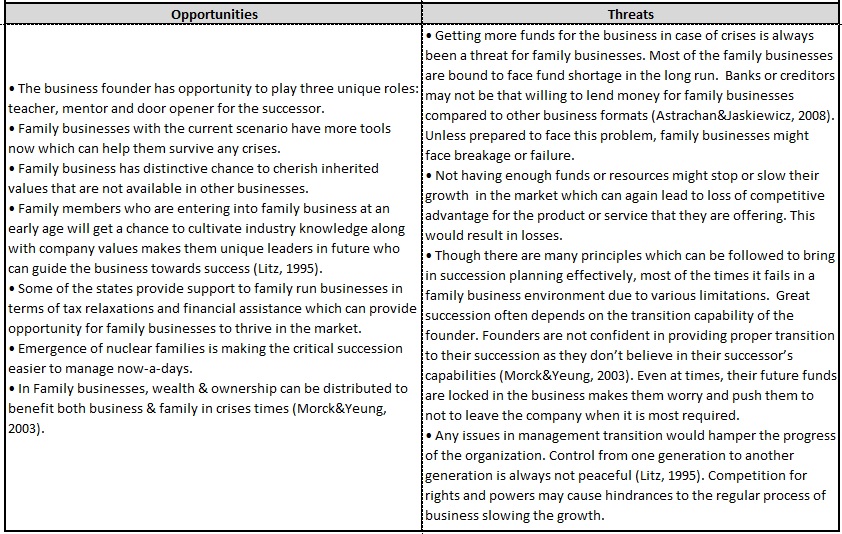
Gossard SWOT

Haier UK Market Entry SWOT

Ellens Stardust Diner SWOT
Crown plaza city center birmingham swot.
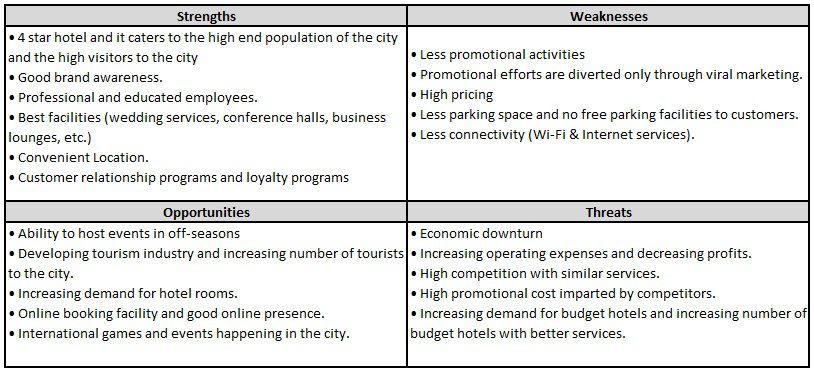
How to Write a SWOT Analysis (Template and Examples Included)
#scribendiinc
Written by Scribendi
Planning for the Future
Where do you see yourself in five years? How about your career? Your business?
These questions keep a staggering amount of people awake at night. All too often, the future can seem like a dark, ominous cloud that looms just out of view. As the old proverb goes, we fear the unknown—and little can possibly be more unknowable than the future.
While there is no crystal ball that can accurately predict future market trends or the steps you should take to optimize your productivity and sharpen your competitive edge, we can offer some advice: Reframe the question. Rather than trying to pinpoint where you think you might be in five years, think about where you want to be at that point in time. Once you have a destination in mind, you can start planning a route to get there. After all, maps are great tools, but they can't help you if you don't know where you're going.
So, what's the metaphorical map in this scenario? We present to you the SWOT (strengths, weaknesses, opportunities, and threats) analysis.
How to Write a SWOT Analysis
SWOT analyses are great strategic tools that are useful in project planning, business development , financial strategizing, and personal advancement . Simple, honest, and to-the-point, they facilitate a profound understanding of your or your business's current standing. Essentially, a SWOT analysis is a comparative list of all your strengths, weaknesses, opportunities, and threats.
There's more power in this process than you might think. You may be only hazily aware of your own strengths and weaknesses. However, thoughtfully recording and reflecting on them creates a thorough, conscious familiarity with both the resources available to you and the obstacles standing in your way. This awareness allows you to map out a path toward your goals with great precision and purpose. Writing a SWOT analysis will help you clearly evaluate whether your goals are feasible according to your resources and needs.
In this guide, we'll break down exactly how to write a SWOT analysis and provide a few examples along the way. Feel free to use our SWOT analysis template, given below, to write your own!
Our SWOT Analysis Template
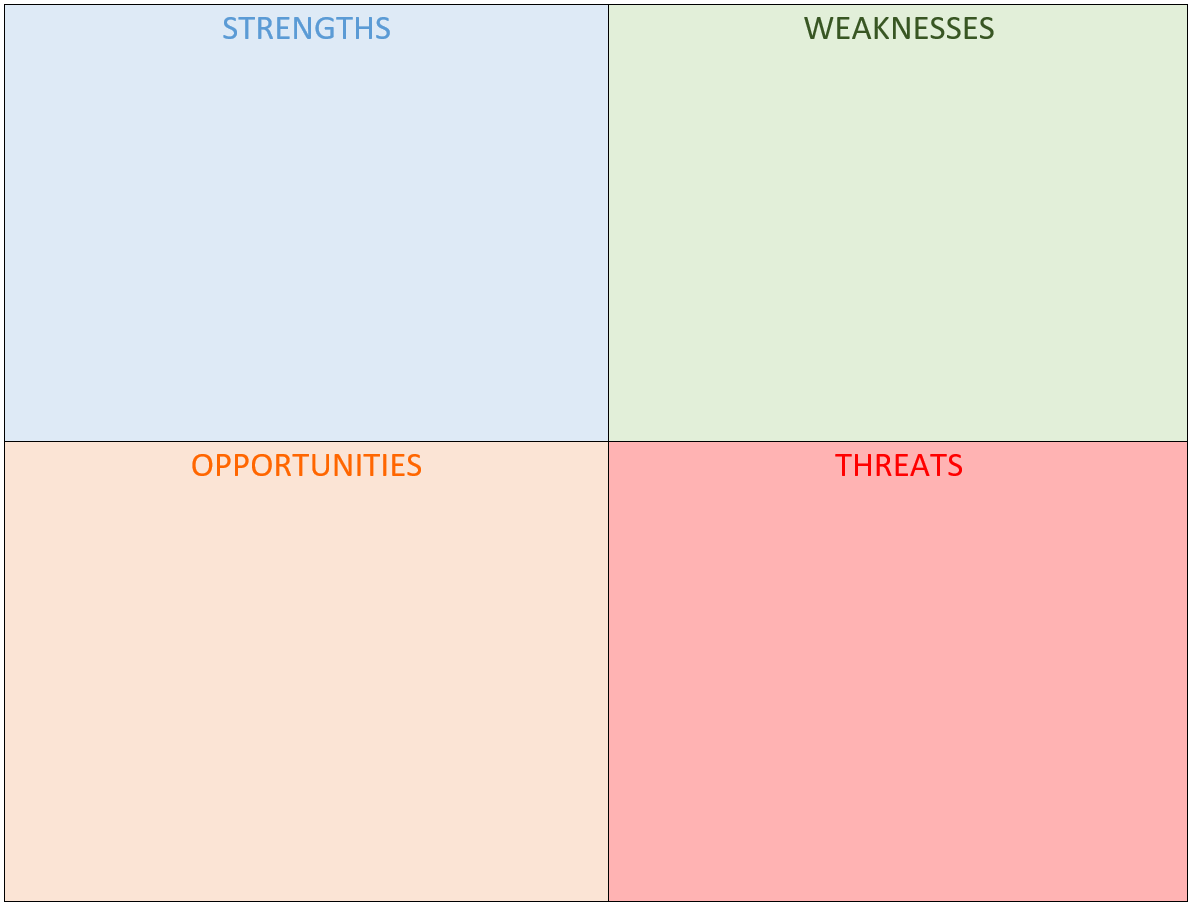
Your list of strengths should focus on your current resources and abilities. It should relate to things that you do or that your company does well. These might be your or your company's accomplishments—both great and small—and the assets that you or your company have. Your strengths give you your greatest edge; they are the resources that propel you forward and that you can continue to develop as you progress.
When you draw up your first SWOT analysis, you may find yourself at a loss. Don't worry—it's difficult for most people to come up with an objective list of strengths and weaknesses on the spot. For your convenience, we've included a list of questions you can ask yourself to get started.
These questions should help you identify a few of your strengths. Remember, while our example questions mostly relate to business strengths, they can also apply to personal strengths. Go ahead and boast as much as you can.
- What sets your company apart from others?
- What do you have that other companies don't?
- What are you most proud of about your company?
- What makes clients come back to you?
- What does your company do well?
- What assets do you have access to?
- What qualities does your company have that other companies try to emulate?
- What has always been easy for your company?
Listing your weaknesses might be a little more uncomfortable than detailing your strengths, but trust us—doing so will help you in the long run. Understanding the obstacles in your path and the elements of your business or skills you may need to improve is just as important as appreciating your strengths. Once you're aware of your weaknesses, you can start working on them and building your next steps around them.
Your list of weaknesses should pertain to any current problems and challenges. Check out the list of questions below—it should give you an idea of where to start. Again, if you'd rather focus on your personal or career growth, feel free to alter these questions to suit your needs.
- What makes your company blend in with its competition?
- What do other companies have that you don't?
- What are the most common criticisms that you receive from clients?
- Why have certain clients not returned to you?
- What does your company need to improve upon?
- What kind of feedback do you receive from your employees?
- What might your competition consider to be a weakness?
- What has always been difficult for your company?
- What are you unwilling to do or change?
Opportunities
Think about the opportunities available to you as potential future strengths. Your opportunities are the assets, resources, and events that could be beneficial to you in some way in the future. You may need to change some of your current approaches or adapt in other ways to capitalize on these opportunities, and that is not necessarily a bad thing.
Here are some questions you can ask yourself to identify your potential opportunities:
- What is happening in the current market that you could capitalize upon?
- What changes have you been making that have returned positive results?
- What is working for other companies?
- How could you introduce new technology to make your processes more efficient?
- What costs can you cut?
- Could you access new sectors or demographic groups?
- How can you improve or modernize your marketing techniques?
- How can you remove existing obstacles?
Threats
Just as your opportunities are based on potential, so are your threats; these are the possible obstacles or issues that are not yet directly affecting your progress. But this doesn't mean that you shouldn't start thinking about them! Being aware of the challenges that you may encounter will help you either plan around them or confront them with solutions. Try to come up with several future events that may realistically hinder the momentum you build from engaging with your strengths and opportunities.
To get started, take a peek at our list of questions:
- What obstacles might your weaknesses create?
- Do changing market trends negatively affect your competitive edge?
- What might stand in the way of the changes you make to accommodate your strengths and opportunities?
- Do you have a lot of debt?
- Could your competition exploit your weaknesses?
How did you do? Do you feel like you've listed everything? Or do you think you're missing something? Below, we've drafted examples of a business and a personal SWOT analysis to provide you with some perspective on what a completed one might look like.
An Example of a Personal SWOT Analysis
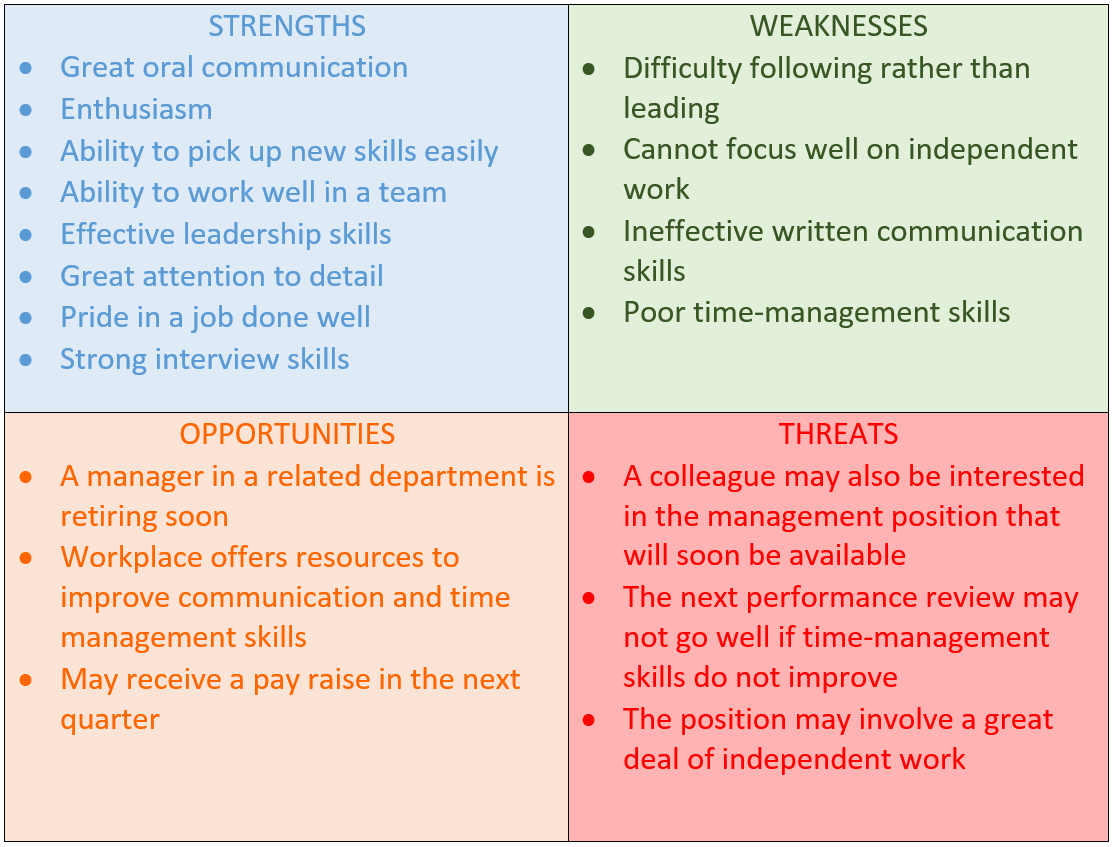
An Example of a Business SWOT Analysis
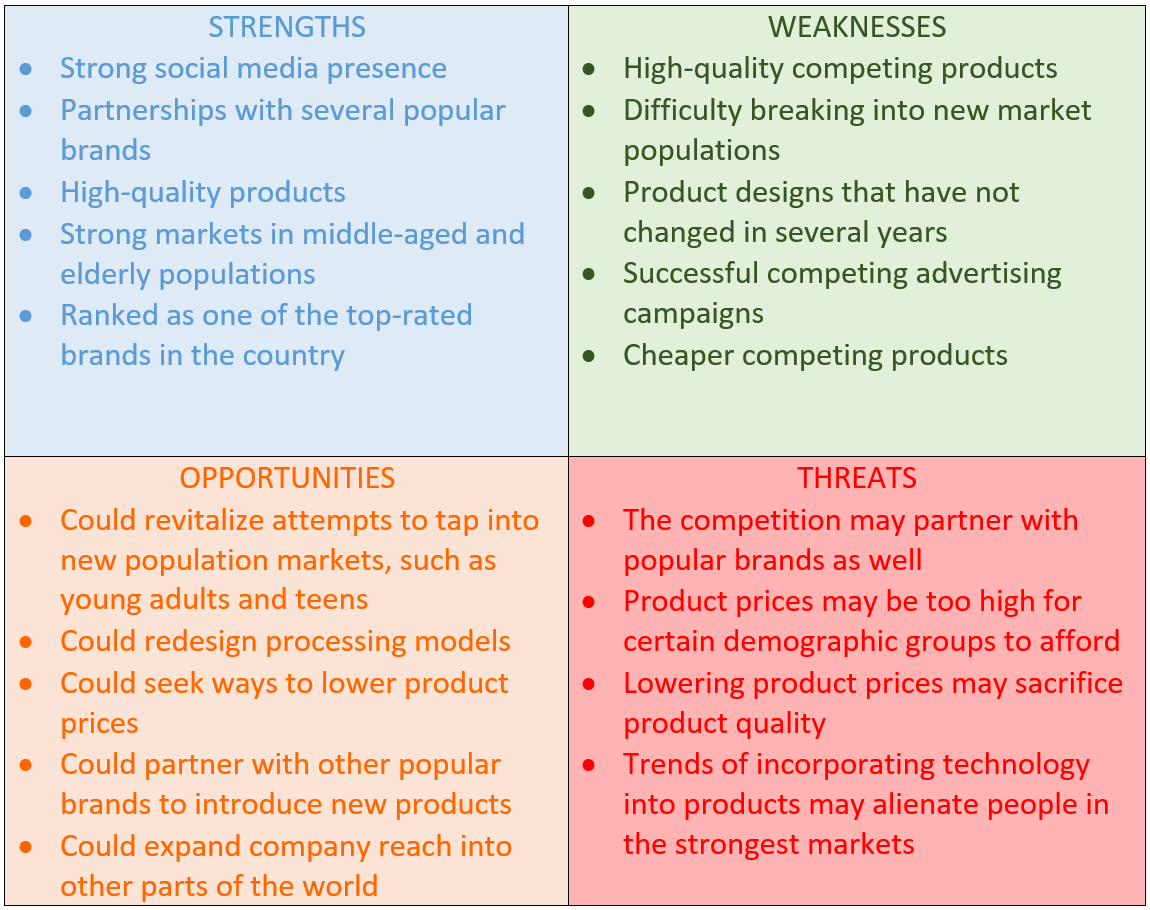
Final Words
The humble but effective SWOT analysis will produce a detailed map of your current environment—its hills and valleys alike. Knowing how to write a SWOT analysis will provide you with the vantage point you need to choose a direction and blaze a trail toward your goals. SWOT analyses may not be crystal balls, but they are something like compasses. Use them wisely, and you will never be lost.
Image source: cookelma/unspla sh.com
Make a Strong Start. Connect with a Professional Editor.
Hire one of our expert editors , or get a free sample, about the author.

Scribendi's in-house editors work with writers from all over the globe to perfect their writing. They know that no piece of writing is complete without a professional edit, and they love to see a good piece of writing turn into a great one after the editing process. Scribendi's in-house editors are unrivaled in both experience and education, having collectively edited millions of words and obtained nearly 20 degrees collectively. They love consuming caffeinated beverages, reading books of various genres, and relaxing in quiet, dimly lit spaces.
Have You Read?
"The Complete Beginner's Guide to Academic Writing"
Related Posts

How to Write a Business Plan

How to Write a Letter of Recommendation

Traditional Publishing versus Self-Publishing: What's the Difference?
Upload your file(s) so we can calculate your word count, or enter your word count manually.
We will also recommend a service based on the file(s) you upload.
English is not my first language. I need English editing and proofreading so that I sound like a native speaker.
I need to have my journal article, dissertation, or term paper edited and proofread, or I need help with an admissions essay or proposal.
I have a novel, manuscript, play, or ebook. I need editing, copy editing, proofreading, a critique of my work, or a query package.
I need editing and proofreading for my white papers, reports, manuals, press releases, marketing materials, and other business documents.
I need to have my essay, project, assignment, or term paper edited and proofread.
I want to sound professional and to get hired. I have a resume, letter, email, or personal document that I need to have edited and proofread.
Prices include your personal % discount.
Prices include % sales tax ( ).

JOIN SOMEKA BUSINESS: Subscribe to Business Membership for exclusive benefits! Dismiss
How to do a SWOT Analysis? With Templates and Examples
- Updated on February 9, 2024
SWOT Analysis is definitely one of the most known business tools to evaluate the future insights for a company or an organization. But do you now how to do a SWOT analysis in an effective way? This article will discover all the details of a clear and efficient SWOT process .
Table Of Content
1. What is a SWOT analysis? 2. What does SWOT stand for? 3. How to do a SWOT analysis? 4. Effective Questions for SWOT Analysis 5. Why is a SWOT analysis important? 6. SWOT Analysis: Pros and Cons 7. When should you use a SWOT analysis? 8. Expert Tips: How do you write a good SWOT analysis? 9. SWOT Analysis Examples 10. Conclusion
Among the many time-tested methods for helping companies find their place in the market, the SWOT analysis has proven to be an invaluable asset. The method’s adaptability makes it useful for both internal and external source identification of opportunities and threats to a company.
If you’re a nonprofit trying to grow, a for-profit business planning to introduce a new product, or a startup trying to break into the market, a SWOT analysis is a must-have tool.

1. What is a SWOT analysis?
A SWOT analysis is a structured planning method used by individuals and organizations to evaluate the Strengths, Weaknesses, Opportunities, and Threats related to business competition or project planning.
Despite its seeming lack of complexity , a SWOT analysis is capable of yielding profound insights. So, stakeholders can find the best places to make changes and use their influence by dissecting the internal and external variables that impact an entity.
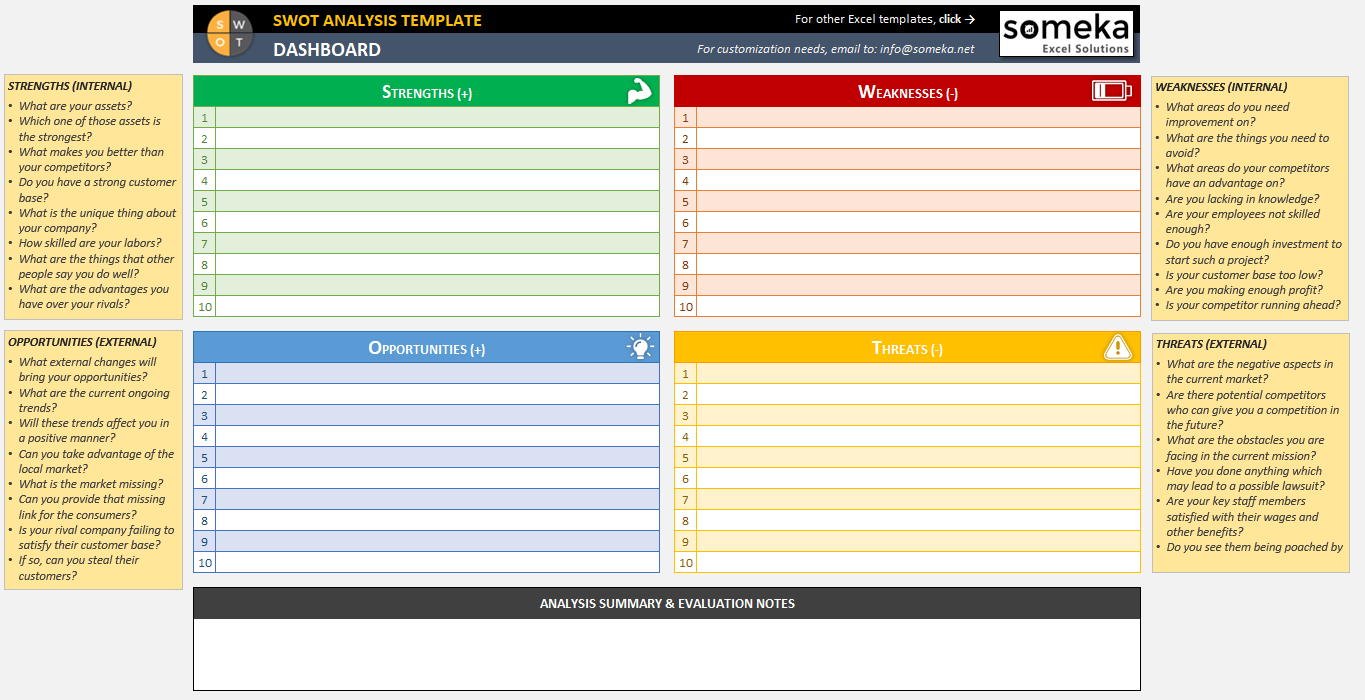
>> Download SWOT Analysis Excel Template
Also, in most cases, an organization’s strengths and weaknesses are things that exist on the inside, such as its resources, systems, and processes. On the flip side, opportunities and threats are things outside of your control, such as changes in the market, the economy, or new technologies.
Additionally, business, marketing, personal career planning, and many more fields can all benefit from this versatile tool. So, an organization’s present position and future prospects can be better understood by conducting a SWOT analysis, which outlines the positives and negatives of the organization’s internal and external environments.
2. What does SWOT stand for?
Here’s a closer look at what each term represents in the context of a SWOT analysis:
- Strengths: These are internal attributes and resources that support a successful outcome. Strengths are what the organization excels at or possesses more advanced capabilities in comparison to competitors. This could include a strong brand reputation, a loyal customer base, unique technology, exclusive access to the best natural resources, or favorable distribution networks.
- Weaknesses: These are internal factors that might hinder the achievement of an objective. Weaknesses detract from the value offer and could place the organization at a disadvantage. Examples might include gaps in expertise, limited resources, poor location, inadequate supply chains, or inferior technology compared to competitors.
- Opportunities: External chances to improve performance in the environment. Opportunities reflect the potential you can leverage to grow your business or project. They might arise from market growth, lifestyle changes, technological advances, partnerships, and other external factors that offer a compelling avenue for expansion or improvement.
- Threats: External challenges that could cause trouble for the business or project. Threats might stem from various sources like economic downturns, increased competition, changes in regulatory landscapes, or other external risks that could impact the entity’s success negatively.

Understanding each of these components in detail allows organizations and individuals to craft strategies that capitalize on the strengths and opportunities while mitigating the weaknesses and threats.
3. How to do a SWOT analysis?
An organization or project’s internal and external environments can be examined using a clear and structured approach in a SWOT analysis. To make sure the analysis is thorough and effective, it can be divided into several steps:
Step 1: Prepare your SWOT layout
First things first, select your platform to perform SWOT analysis and prepare your layout.
Step 2: Assemble a Group for SWOT Analysis
Definitely, multiple viewpoints add depth to SWOT analysis. Thus, gather a group of people with different backgrounds and areas of expertise to get a complete picture. Then, your analysis is more thorough and accurate because of this inclusivity.
Step 3: Make a List of Your Strengths
Thirdly, write down all the personal qualities and assets that will help you reach your goal.
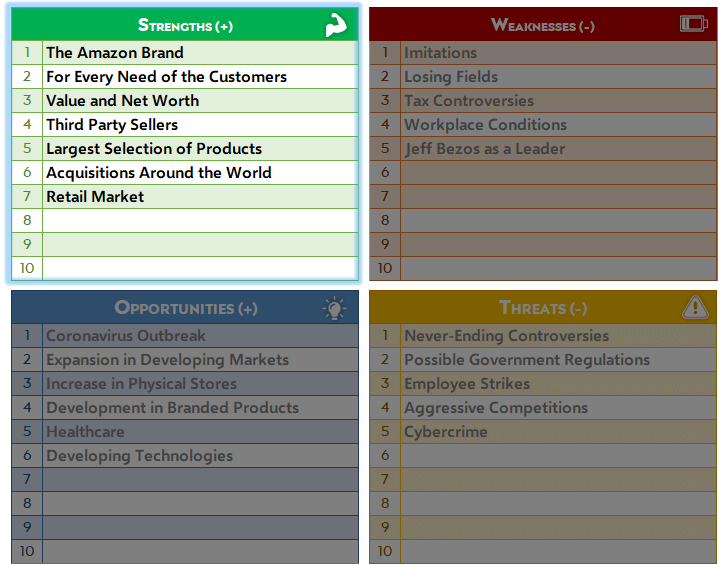
Think about the strengths, resources, and competitive advantages of your company. Intellectual property and other physical assets are part of this category, as are intangible assets like company culture and reputation.
Step 4: Identify Your Weaknesses
Then, recognize the internal variables that may impede your advancement.
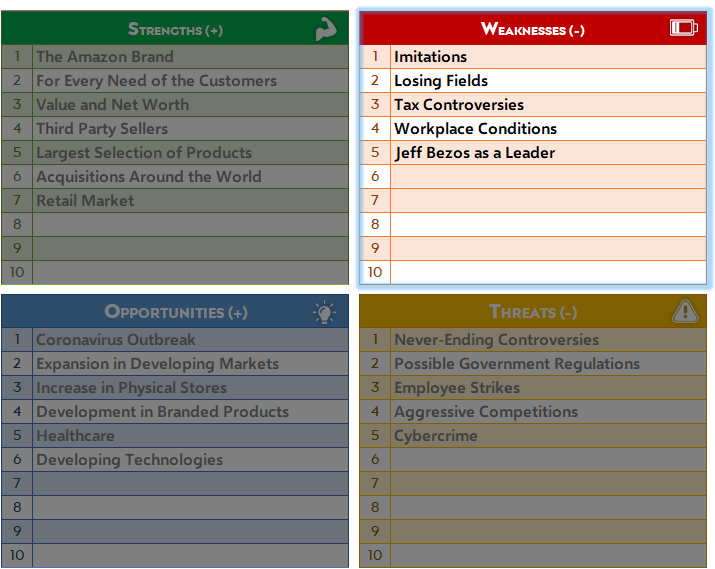
Maintain objectivity and honesty; admitting fault is the first step in fixing it. Think about potential weak spots in your company or areas where your competitors could excel.
Step 5: Seek Out Opportunities
Also, seek out possibilities for expansion or enhancement outside of your current organization.
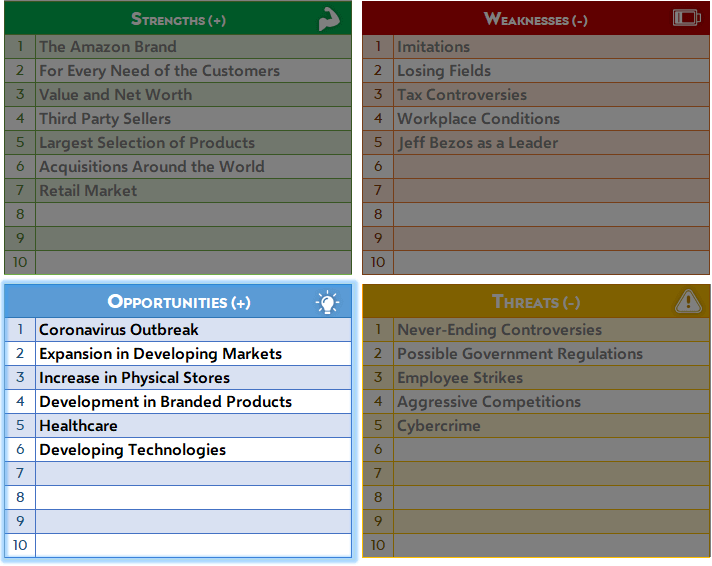
Any external factor that your organization could use to its advantage could be considered here, including trends, changes in technology, market gaps, and so on.
Step 6: List your Threats
Lastly, in a similar vein, you should be aware of the outside forces that might endanger your company.
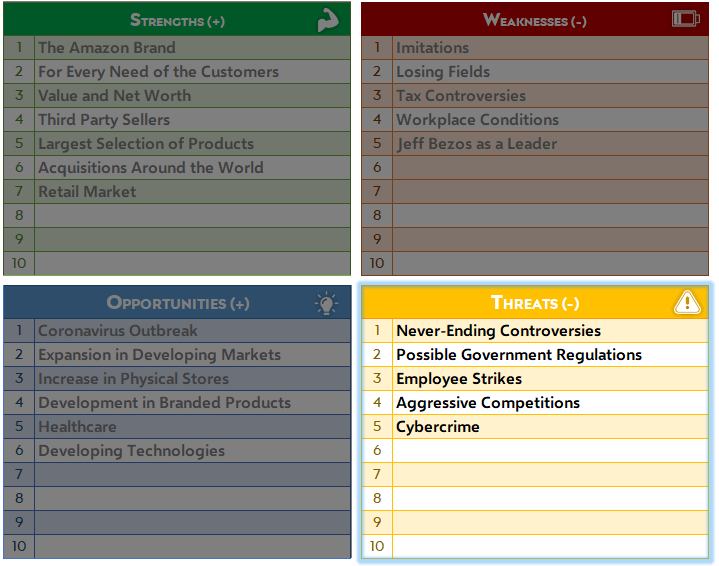
Any outside force that might have a detrimental effect on your company qualifies, whether it be changes in regulations or intense competition.
Step 7: Evaluate your SWOT Analysis results and prepare your Action Plan
Now that you have all the factors listed, it’s time to think about them and figure out how they could affect things.
Sort the SWOT analysis elements in order of how important they are to achieving your goal . You should formulate plans to take advantage of opportunities, fix weaknesses, and lessen the impact of threats. Embrace opportunities when they come, shore up your weak spots, build on your strengths, and fortify yourself against outside dangers.
Turn your strategies into a workable plan with defined objectives, roles, and due dates. In order to transform insights into outcomes, this step is vital .
So, define your goals with risks and opportunities , then list your actions. Also, it’s important to be definitive in your actions with clear mentioning of responsible person, priority, due dates. Lastly, you can use Someka’s action planning tool here to make effective preventive and corrective action plans:
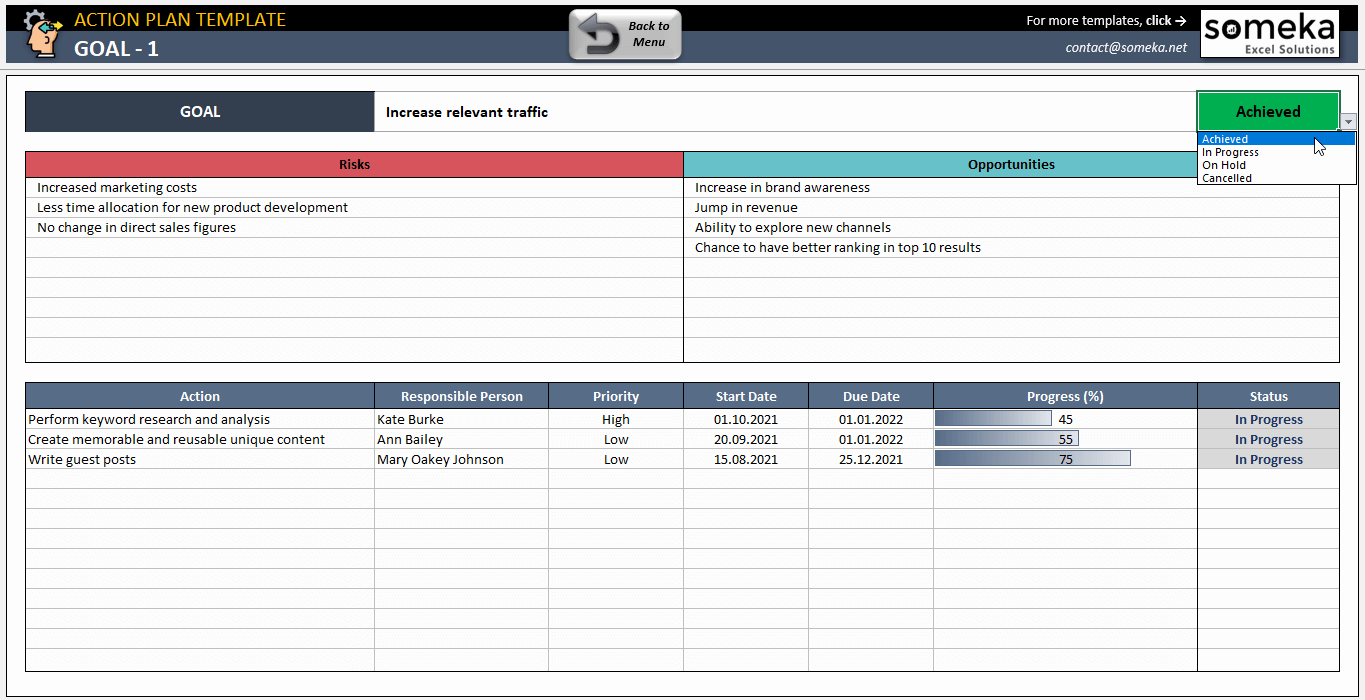
>> Download Action Plan Excel Template
Step 8: Update your SWOT analysis regularly
The external environment and your internal capabilities are subject to change , so it’s important to review regularly. If you want your strategies to stay effective, you need to revisit and update your SWOT analysis regularly.
What follows is an examination of the kinds of questions that might be asked at various points in a SWOT analysis in order to glean useful information.

4. Effective Questions for SWOT Analysis
One of the most important parts of how to do a SWOT Analysis is to ask the right questions for an accurate evaluation.
If you want your SWOT analysis to be really comprehensive, you need to ask lots of questions to get to the bottom of your company’s internal and external environments. For each group, here are some sample questions:
- What advantages does your organization have over others?
- What unique resources can you leverage?
- What do others see as your strengths?
- What is your organization’s competitive edge?
- What processes are efficient, and what expertise do you have?
- What areas need improvement to compete more effectively?
- What resources do you lack?
- What parts of the business are not profitable?
- What are the perceived weaknesses of your organization?
- Where does your organization have fewer resources or capabilities than others?
Opportunities
- What trends or market conditions could you exploit to your advantage?
- Are there emerging needs for your products or services?
- What technological advancements can you leverage?
- How can you turn your strengths into opportunities?
- Are there changes in social patterns, population profiles, lifestyle changes, etc., that suggest an opportunity?
- What obstacles do you currently face?
- Are there new competitors entering your market?
- Could any of your weaknesses seriously threaten your business?
- Are there changes in regulations that could impact your business negatively?
- Is your market or industry declining?
Answering these questions requires honest and critical thinking .
The goal is to uncover insights that can inform strategic decision-making and help prioritize actions that align with the organization’s objectives.

5. Why is a SWOT analysis important?
Firstly, one of the most important parts of strategic planning is doing a SWOT analysis. The SWOT analysis is useful for many reasons, including the following:
- Better understand your company with insights from different angles
- Grab the chances to grow and expand
- Identify weaknesses and threats with a proactive approach
- Help with strategic planning
- Encourages dispassion by minimizing the influence of personal biases on decision-making
- Encourage better communication and cooperation amongst employees
- More informed decisions with better allocation of resources, clearer strategic direction, and higher performance
These are only some general angles that why a SWOT analysis is important for your organization.

6. SWOT Analysis: Pros and Cons
The ease and efficacy of a SWOT analysis have made it a popular tool for strategic planning. Yet, it does have its uses and limitations, just like any other tool:
- Flexibility
- Ease-of-use
- All-Inclusive
- Prompts Strategic Thinking
- Helps with Decision-Making
- Boosts teamwork and communication
- Chance of oversimplification
- Risk of imprecision
- Lack of prioritization
- Need for regular update
- Lack of actionable recommendations
In spite of these caveats, a SWOT analysis is still an excellent resource for strategic planners . It can yield potent insights to direct strategy and decision-making when executed with care, with a dedication to objectivity and continual improvement.
7. When should you use a SWOT analysis?
Definitely, a SWOT analysis comes in handy in the following important situations:

Strategic Planning Process: Organizations can use it to gauge where they are now and plot a course for future development and improvement.
New Product or Project Launch: Before releasing a new service, product, or project to the public, it is wise to conduct a SWOT analysis to weigh the pros and cons of the endeavor.
Competitive Analysis: A SWOT analysis is a useful tool for comparing your company’s strengths and weaknesses to those of your rivals in a competitive analysis.
Responding to Changes in the Market: You can assess the effects of external changes on your organization plan your adaptation strategies for changes like new regulations, technology advances, or changes in consumer behavior.
Organizational Change: Also, this analysis can help shed light on the internal and external factors that will impact the change process during organizational restructuring.
Crisis Management: This methodology can be a useful tool for organizations during times of crisis.
Additionally, SWOT Analysis are an important part of your business plans. So, if you’re preparing a business plan for your stakeholders, creditors, partners, clients, or other third-parties, you should also add a swot analysis to draw a general picture of your business prospects:
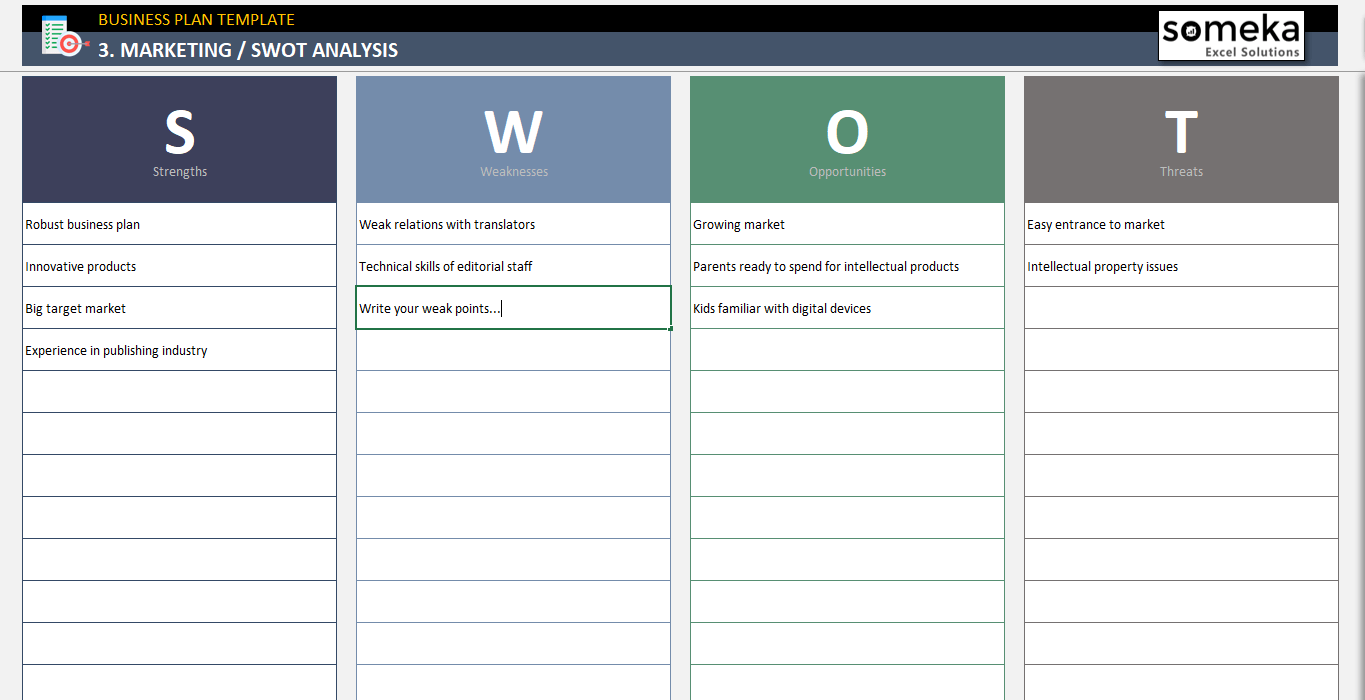
>> This is the SWOT Analysis section of Business Plan Excel Template from Someka collection <<
8. Expert Tips: How do you write a good SWOT analysis?
Here are 8 expert tips for an effective SWOT analysis process:
Don’t be vague, instead be specific!
As an illustration, rather than mentioning “good customer service” as a strength, go more specific by stating what makes your customer service stand out, like “24/7 customer support with an average response time of under 1 hour.”
Make use of real data!
Back up your claims with concrete, measurable facts . Indicators of financial performance, surveys of customers, and analyses of the competition are all examples of what may fall into this category. The validity and accuracy of your SWOT analysis are enhanced by data-driven insights.
Involve all related parties!
To get a full picture, it’s important to include people from different departments and roles in the company. Taking a step back and looking at things from a different angle can help us see things more clearly.
Look Outside!
While taking stock of your company’s internal strengths and weaknesses is a must, it’s also a good idea to take a step back and examine the outside world for opportunities and dangers that you may have missed. Trends in the market, new technologies, and changes in regulations could all be part of this analysis.

Make a ranked list!
The implications of each of the factors presented in a SWOT analysis on your goals will vary. You should rank each factor according to how much it can affect your objectives . By doing so, you can direct your plan’s attention to what’s really important.
Always be truthful!
A SWOT analysis relies on your candor . Poor strategic decisions can result from exaggerating one’s strengths or downplaying one’s weaknesses. Strategies should be based on the organization’s actual capabilities and situation, which can be achieved through a realistic appraisal.
Connect SWOT to strategies!
A SWOT analysis’s end goal is to help with strategic decision-making. After identifying each element, plans should be made to take advantage of opportunities, fix weaknesses, and protect against threats.
Make use of it to begin a conversation!
If you want to get your employees talking about strategy, a SWOT analysis is a great tool to use. Make use of it to get your team members thinking creatively and strategically about ways to improve and innovate.
9. SWOT Analysis Examples
Perhaps, the best way to understand how to do a SWOT Analysis is explore the examples of such evaluations.
Among our examples, let’s first check the the Adidas SWOT Analysis :
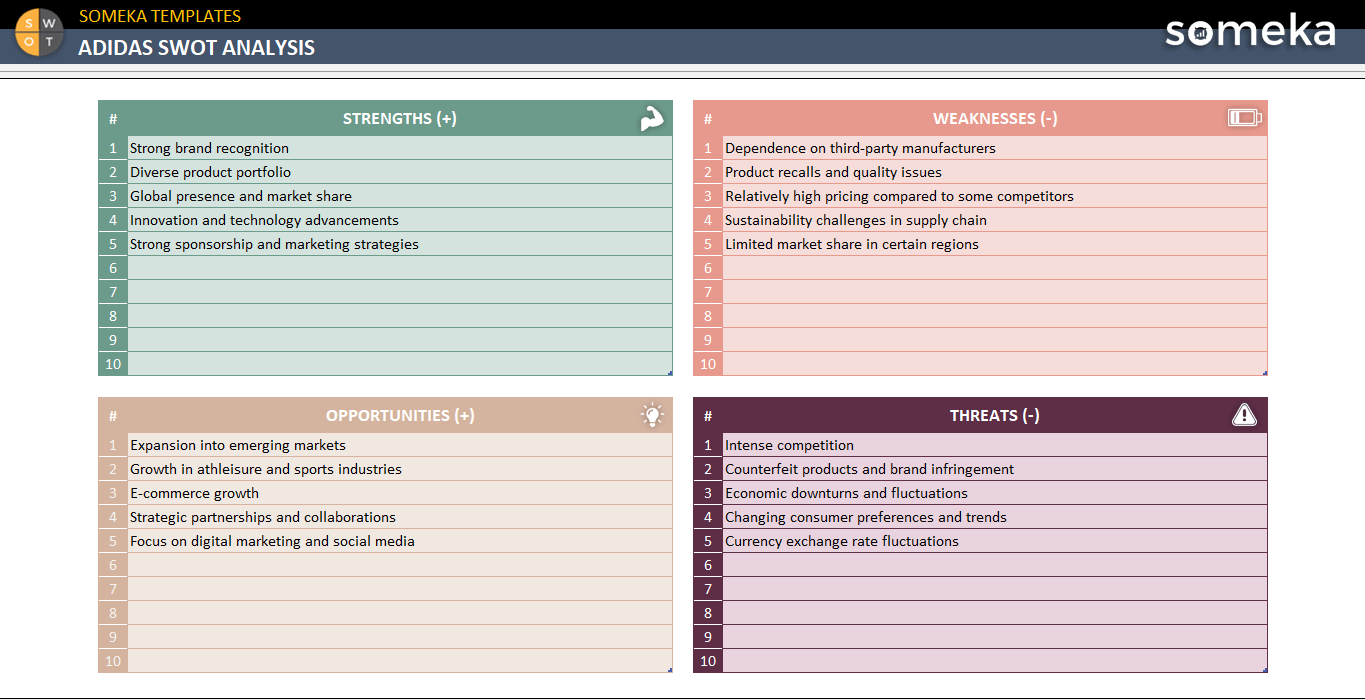
>> Download Adidas Swot Analysis Example
As one of the biggest sportswear companies , Adidas has strengths of strong brand recognition, diverse product portfolio, and big global presence. On the other hand, among the biggest weaknesses , the company has a high dependence on third-part manufacturers, limited market share in certain regains, and sustainability challenges in supply chain.
On the external factors, we see some opportunities on expansion into emerging markets, e-commerce growth and strategic partnerships. However, intense competition, brand infringement, economic downturns and changing customer preferences are among the threats on the company.
Let’s check another example for an Personal SWOT Analysis:
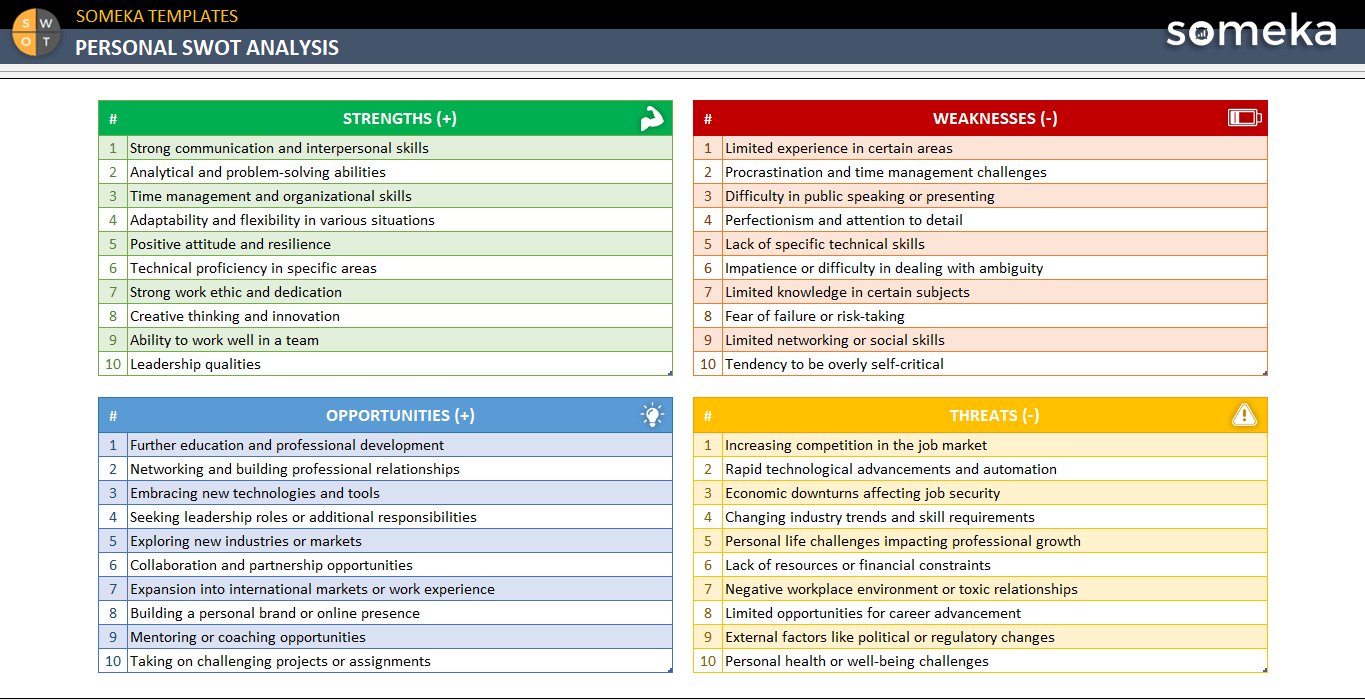
>> Download Personal SWOT Analysis Template
So, this is an individual SWOT example for an hypothetic person. Among the strengths , we can see strong communication skills, analytical abilities, time management skills, leadership qualities, etc. And on the opposite side , we have limited experience, lack of some technical skills, limited networking, perfectionism, procrastination, and so on.
About the opportunities , we can list embracing new technologies, seeking leadership roles, professional development, building online presence, and similar possibilities. Lastly, increasing competition in the job market, economic fluctuations, rapid technological advancements, toxic relationships are some of the possible threats for an individual.

10. Conclusion for SWOT Analysis
One of the most important tools for strategic planning is the strengths, weaknesses, opportunities, and threats (SWOT) analysis. This tool provides a straightforward but effective framework for assessing the position of an organization or person in relation to their environment.
Using a balanced perspective that takes into account both internal and external factors, this model can help with decision-making and strategy development.
In this article, we have explored how to do a SWOT Analysis in detail with definitions, step-by-step instructions, expert tips, examples, and also downloadable templates . Hope you enjoy this article!
Recommended Readings:
How to Conduct PESTLE Analysis? With Examples, Templates and Sample Questions
Overview of Risk Assessment Process: Importance, Steps, and Framework
How to Write a Business Plan? Step-by-step Guide with Excel Template
Related Posts


- You are here:
- Home »
- Blog »
- Business Growth »
SWOT Analysis In Business (With Examples)

- Business Growth
Here is a simple strategic SWOT analysis that you can use as a highly effective method for creating an edge in the market and to insure long term success.
SWOT is an acronym for the Strengths and Weakness of a business and the Opportunities and Threats facing the business. It is used to understand Current and Future, Internal and External factors that may have an effect on a business results and success.
The Strengths and weaknesses are focused inward to analyze what your company does well and where it could be better. Opportunities and Threats are focused externally towards the industry, which analyze any potential negative effect on the business.
How To Carry Out A SWOT Analysis In Business
To carry out a SWOT analysis for your business, summarize the strengths, weaknesses, opportunities and threats of your business relative to competitors. A SWOT analysis is a simple, yet highly effective method for conducting an analysis on a business, product or service. Before you try writing a business or marketing plan, it is highly recommended that you first complete a SWOT analysis.
A SWOT approach to planning requires owners to look very closely and analytically at every aspect of their operation, so that objectives can be evaluated as achievable, while also building up a clear picture of the strategies that need to be adopted under the constraints that have been recognized.

“If you know the enemy and know yourself, you need not fear the result of a hundred battles. If you know yourself but not the enemy, for every victory gained you will also suffer a defeat. If you know neither the enemy nor yourself, you will succumb in every battle.”
- Sun Tzu, The Art Of War -
When completing a SWOT analysis, the aim is to reflect on all aspects of your business’s operations. You may wish to do this exercise alone or include your staff, spouse or business advisor. Whether you choose to do it alone or with others, make sure you allow a solid chunk of time to complete the analysis without being interrupted.
A SWOT analysis is a brainstorming exercise and to get the best results I suggest you allow yourself at least thirty minutes, or preferably an hour. This allows your mind to free itself of the multitude of thoughts and minor details of day to- day living. It takes time to get a flow of ideas going, so be patient and allow yourself time. Once you have allotted sufficient time to focus on this exercise it is time to get started.
SWOT Analysis Template: Excel Download

SWOT Analysis
Download SWOT Analysis Excel Template
This link will open as an Excel spreadsheet and is ready, and
easy to use but you can follow these video instructions for more information.
SWOT Analysis Template Video
The SWOT Analysis Goal
After you have successfully completed the SWOT analysis, take some time to explore ways to consolidate your strengths, minimize your weaknesses, take advantages of the opportunities and be prepared for the threats.
Your priorities should be to:
- Consolidate a strength
- Use a strength to address an opportunity or threat
- Use a strength to minimize a weakness or threat
- Convert a weakness to strength
- Convert a threat to an opportunity
SWOT Analysis Template: PDF Download
Download swot analysis pdf.
A SWOT analysis is a simple, yet highly effective method for conducting an analysis on a business, product or service. Before you try writing a business growth or marketing plan, it is highly recommended that you first complete a SWOT analysis.

S WOT Analysis - STRENGTH
The first step is to reflect on what you do really well. What is working for you at the moment? Can you consolidate on any of these strengths and make them an even bigger advantage for your business? Try asking yourself the following questions
What are your business’s strengths?
- Attractive shopfront
- Operating hours
- Industry experience
- Follow-up service
- What do you do well?
- What unique resources can you draw on?
- What do others see as your strengths?
- How are you superior to your competitors?
- Why are your products or services so good?
- What is it that makes your business unique?
Potential Internal Strengths Can Be:
- Adequate financial resources.
- Well thought of by buyers.
- An acknowledged market leader.
- Well-conceived functional area strategies.
- Insulated from strong competitive pressure.
- Proprietary technology.
- Cost advantages.
- Better advertising campaigns.
- Product innovation skills.
- Proven management.
- Better manufacturing capability.
- Superior technological skills.
“Appear weak when you are strong, and strong when you are weak.”
- Sun Tzu, The Art Of War -
S W OT Analysis - WEAKNESS Examples
Weaknesses need to be understood so you can compensate or improve them. This is not the time to start beating yourself up for being less than perfect. Everyone has weaknesses. Your first task is to identify anything you think you need to improve. These could include:
- Time management
- Marketing strategy
- Certain products or services
- Cleaning up your work environment
- Follow-up procedures
- What could you improve?
- Where do you have fewer resources than others?
- What are others likely to see as weaknesses?
Potential Internal Weaknesses Can Be:
- No clear strategic direction.
- Obsolete facilities.
- Low profitability because …
- Lack of managerial depth and talent.
- Poor track record in implementing strategy.
- Internal operating problems.
- Too marrow a product line.
- Weak market image.
- Weak distribution network.
- Below-average marketing skills.
- Unable to finance needed changes.
- Higher overall costs relative to key competitors.
Make a comprehensive list and start reviewing which ones you could start transferring into strengths. If you find it difficult to be objective, ask someone you trust for his or her feedback on your perceived weaknesses.
“So in war, the way is to avoid what is strong, and strike at what is weak.”
SW O T Analysis - OPPORTUNITY
The third stage of the analysis process is to look at the opportunities that your business has available. Where could you start gaining an advantage over your competitors? The more you know about what your competitors are doing, the easier it will be for you to see opportunities to create something different and compelling. Another great way to discover possible opportunities is to ask your current customers. They will often have all the answers if you are brave enough to ask the question.
- What external factors can you take advantage of?
- Are there current resources that are underutilized?
- How can you turn your strengths into opportunities?
- What trends could you take advantage of?
- What good opportunities are open to you?
Potential External Opportunities Can Be:
- Serve additional customer groups.
- Enter new markets or segments.
- Expand product line to meet broader range of customer needs.
- Diversify into related products.
- Falling trade barriers in attractive foreign markets.
- Complacency among rival firms.
- Faster market growth.
There are always opportunities. Take the time to brainstorm a comprehensive list and don’t sensor your ideas. There will be time to eliminate the most impractical ideas later. For now, just get the ideas down on paper.
“In the midst of chaos, there is also opportunity”
SWO T Analysis - THREAT
Finally, you need to assess any current or future threats to your business. All potential threats should be brainstormed. It is better to be aware of problems that might arise than to be hit with them out of the blue. This list could include things like changes in legislation, a multinational competitor opening a store or a lack of products due to importing issues. Whatever the possible threats, list them and assess whether they are real or unlikely. Are there any threats to your current market share? When all areas have been plotted and identified, you will be in a much better position to plan your future.
Take the time to complete this exercise thoroughly as the benefits are very real.
- What threats do your weaknesses expose you to?
- What is your competition doing?
- What trends could harm you?
Potential External Threats Can Be:
- Entry of lower-cost foreign competitors.
- Rising sales of substitute products.
- Slower market growth.
- Adverse shifts in foreign exchange rates and trade policies of foreign governments.
- Costly regulatory requirements.
- Changing buyer needs.
- Adverse demographic changes.
SW OT Analysis Examples
- Sample SWOT Ideas for a Local Restaurant
- Example SWOT for a Small, Local Coffee Chop Chain
“Who wishes to fight must first count the cost”
About the Author Hans
Hans had 40 of his own businesses over the last 30 years and is famous for creating fast-growing businesses” He is an author, speaker, coach, and consultant and a specialist in business optimization and turnaround, helping smaller business owners eliminate business limitations, threats, and growth challenges in achieving their sales, profit, cash flow, and income goals with sniper precision.
Popular posts
20 big money mistakes business’s make in 2021, 6 ways to save & turnaround a failing business, 7 proven business turnaround strategy steps, ten keys to a successful business turnaround.
ZenBusinessPlans
Home » Business Plans
How to Write a SWOT Analysis Report for Business Plan [Sample Template]
Writing a SWOT analysis is the first step to writing a business plan. Without any doubt, the number one secret of a successful business is planning, and more specifically writing your own business plan. But before you begin planning, you should make sure that you understand your business, your competitive environment and what it is going to take to be successful.
In his book “ The Art of War ”, an ancient general known as Sun Su said that if you know your enemy and know yourself, you need not fear the result of a hundred battles, if you know yourself but not the enemy, for every victory gained you will suffer a defeat and if you know neither the enemy nor yourself, you will succumb in every battle.
With the above analogy, he created a sort of SWOT analysis that will allow you to see yourself and your enemy or competitors more clearly. A lot of small business owners only see just a small part of their competitive environment.
They make decisions at a snap based on what seems to them to be the biggest issue or problem in front of them or they buy equipment thinking that they know their market and then end up not being able to pay for it. In addition, almost every lender or investor will want to make sure that they see the whole picture before they will be willing to part with their money. Before you make any decision you should be sure that you see everything.
What is SWOT Analysis?
SWOT stands for strengths, weaknesses, opportunities and threats and just like its name implies, it tends to review those four aforementioned parameters. SWOT analysis provides an avenue by which the management team identifies the internal and external factors that will affect how the company performs and ultimately its future.
A businesses strengths and weaknesses constitute its internal factors while the opportunities and threats faced by the business makes up its external or environmental factors.
SWOT analysis is done as part of the overall corporate planning process in which financial and operational goals are set for the upcoming year and strategies are created to accomplish these goals. It is also a very important and crucial ingredient in a business plan.
1. Strengths
Strengths refer to those things that a company does that provides it with . It is those things that a company can do which no other company does better than them. It includes what the company is known for.
For instance, for a company like Walmart, one of its main strengths is the fact that they are able to maintain very low cost. This allows them to price their products much lower than a lot of their competitors can because they have the ability to keep their costs low.
Positive brand recognition is also another very good example of strength . Some companies are well known. When you see their image and logo, it evokes positive emotions in you about that brand in particular. These types of companies just have to put their logo on a particular brand and people will buy it just because they have strong brand recognition. They are viewed positively because they are known for the quality they possess.
Yet another example is a skilled work force . This is a very significant strength in the sense that human resources is to a large part the greatest asset that most companies can have. Good employees are hard to come by and employers that can retain their workers and continually train them use it as a competitive advantage. A good example of a company that has this is Costco. They have a well-known reputation of having longer tenure track than most other industries in the same area.
Normally in the retail industry, if you want to maintain low prices , you will have to maintain lower costs which usually means that you will not pay your staff very significantly. Costco on the other hand has done something that is quite different from the norm in that industry.
They pay high wages for the industry, they also offer benefits for part time employees and they also have a lot of other attractive perks that other companies in the line do not offer. This provides them with a benefit of having workers that stay there longer. If workers stay in a particular work for a longer period, they will ultimately get better at what they do.
An employee who has stayed in a business for 3 to 5 years will definitely be better at the job than an employee who has stayed for less than a year in a particular work. This also allows the management to save more money that would have been used to hire and train new staff. Other strengths include access to financial resources, intellectual property, cost advantage et al.
2. Weaknesses
Weaknesses are the things that a company does that are not necessarily positive and could potentially be a liability for them. Sometimes when a factor is not a strength, it may tend to be a weakness. Poor customer service constitutes a significant weakness for a company because it may affect the rate at which future customers will go to that company to purchase their products or services especially if they have heard about someone having a bad experience with them in the past.
Expiring intellectual properties, patents, trademarks and copy rights are also weaknesses . Rising cost is also a major weakness because it will reduce the profit margin of a company. Having an unskilled workforce also provides a weakness because you will have to commit multiple resources to training.
And of course, lack of financial resources can be a major weakness for a company. Just because something is a weakness for a company does not mean that it has to keep being that way. The company can devote more time and resources to reverse this negative trend.
3. Opportunities and Threats
Opportunities and threats are considered to be external to a company because the company cannot necessarily affect or change these elements. These things just happen and it is up to the company to try to recognize an opportunity. If they are able to recognize an opportunity, that can serve as a potential avenue for growth and profitability.
If an opportunity is not ceased, it can quickly turn into a threat. One of the most notable opportunities that exist in recent times is new technology.
Technology has undergone some rapid changes in the past decade or so and this has provided a lot of opportunities for businesses. For example, Amazon was able to look into the option of digital books and digital market and were the first to come up with an e-book reader.
At that time, it was almost impossible to imagine that digital books can even become popular but Amazon was able to key into the opportunity that technology provided and today is the number one in digital books.
Technology could also pose a threat too . Borders is an example of a company that was negatively affected by technology after it failed to foresee the impact that it would have on the industry and as a result they are nonexistent today. The same thing happened when Apple came out with iTunes.
People could now purchase digital rights to songs and not necessarily a physical CD and as such a lot of businesses that specialize in CDs could no longer continue to operate. Technology was an opportunity at one point for them but due to the fact that they did not key into it, it became a threat. Other opportunities include relaxing government regulations, elimination of international barriers, changing consumer preference et al.
Threats are changes in the external environment that have the ability to impact the company . Opportunities and threats are very closely interlinked because opportunities that are not seized can tend to escalate into a threat. Examples of threats are emergence of new competitors into a market, pending government regulations, increased trade barriers, pending lawsuits, new technology et al.
Writing a SWOT Analysis Report for a Business Plan – A Sample Template
To write a SWOT analysis for your business plan you would have to brainstorm and find out what constitutes your strengths, weaknesses, opportunities and threats. For best results, you should conduct a SWOT analysis from the perspective of management, sales, customer care and even the customers. Typically, a SWOT analysis for a business plan is conducted using a foursquare SWOT analysis template but alternatively, you can just make a list of each of the factors you intend to consider.
Once you are done with your brainstorm session, you should create a final version of your SWOT analysis in an order of priority. You should list each category with the elements that are of most priority at the top, and the elements with the least priority should be at the bottom.
For the purpose of illustration, here is a brief SWOT analysis for a hypothetical dog grooming business in the united states of America.
- Have many return customers
- Do get walk-in business
- Mobile grooming van has eye catching logo and gives exposure when performing on-site services
- Customers are satisfied with our level of service
- High overhead cost
- Don’t have a marketing plan
- Don’t have a structured marketing budget
Opportunities
- Increasing popularity of dogs in America
- Increasing use of social media
- Local annual pet fair
- Competition from other dog grooming businesses in town
- Expenses in running media ads
Uses of SWOT Analysis Report
- For strategic planning and decision making: a SWOT analysis is a very important tool for making strategic plans and decisions. It allows the business owner to consider every aspect of the business and also to make informed decisions from the finding he makes.
- Building on strengths: a SWOT analysis will help you to identify the areas in which you are doing well in your business. By identifying these areas, you can make sure that you maintain them so as not to lose that competitive advantage.
- Minimizing weaknesses: conducting a SWOT analysis will help you to identify the characteristics that put your business in a competitive disadvantage. By identifying these areas, you will then be able to easily minimize their impact on your business and thus improve what you already have on ground.
- Seizing opportunities: a SWOT analysis can open your eyes to opportunities that exist around you which your business can take advantage of and turn them into strengths. An opportunity that exists but is not seized by a business can prove to be disastrous in the future.
- Counteracting the effects of threats: with the use of a comprehensive SWOT analysis, a business should be able to identify threats and also proffer ways of nullifying their effects.
More on Business Plans

3 Great SWOT Analysis Examples with Real Companies
Whether you want to assess the current position of your business, expand to new markets, or simply develop a new strategy, a SWOT analysis is probably one of the first steps that you will probably make in that direction. And, if it wasn’t on your radar, it should be! Today, we will see some of the best SWOT analysis examples to get you inspired, and help you understand how to do use it effectively for optimum results.

If you are not familiar with the concept, a SWOT analysis is a key technique for assessing some of the most important aspects of your business. In fact, its name comes from the abbreviation of these aspects:
Strengths – internal
These are the strengths of your company compared to other industry competitors. For example, what is it that you do particularly well that others don’t? What is your unique selling proposition , or that service or aspect of your business that differentiates you from the rest?
Do you have a particular competitive advantage over your biggest competitors? This could be technology, an easy access to primary resources, more product personalization, and so on.

Assessing your strengths will help you identify your current position on the market. But also, give you insights on those aspects that represent a clear advantage for your business, so you can leverage them even more.
Weaknesses – internal
Weaknesses, as you might have guessed, are the exact opposite of your organization’s strength. In other words, what do your competitors do better than you ? In what aspect do they have a clear advantage over you?
Is it something that you offer but can improve, or is it a service or an aspect that you lack altogether? For example, your customer service might be unsatisfactory. Or maybe, a competitor has a particular technological feature that your product don’t offer at all.
We will see more of this with practical cases in our section of SWOT Analysis examples.

Opportunities – external
The next aspect of the SWOT analysis is evaluating the positive trends that can open a new opportunity for your business. They usually arise from the outside of your organization , such as industry changes, important movements on the competitors’ landscape, or even a change in the laws applicable to your industry.
Analyzing other factors, such as VUCA – the leadership theory on volatility, uncertainty, complexity and ambiguity, can also reveal new opportunities for your business. To identify them, you will have to look around you from an external perspective.
Can you spot any current trends that could represent an opportunity for your business? For example, the COVID-19 pandemic made companies like Nike and Adidas sell protective masks on their website as a part of their product portfolio. And many new businesses opened to profit from the changes.

Threats – external
Threats are another aspect that is external to your business, but can impact you negatively if you aren’t paying attention. Some examples include supply chain problems, shift in market requirements, changes to current laws and regulations, and so on.
Of course, threats are not always easy to identify. You will have to be proactively looking for them – if they are obvious, it is probably too late. What is the competition doing? How is the current technology evolving?
Are you noticing a change in user behavior regarding the consumption of your particular product? All these questions can help you get a better understanding of the market , and what could potentially be harmful to you.

And now, let’s get right to our SWOT analysis examples!
Disclaimer: These examples are merely my own analysis and interpretation of the information that is publicly available online for these companies. I don´t work at any of these companies, and I do not pretend that I actually know what is going on behind the scenes for any of them. It is just a practical exercise with real companies with the purpose of giving you a clear idea of how to perform a SWOT analysis.
1. The Coca Cola Company

First on our list of SWOT analysis examples is this one from The Coca Cola Company.

SWOT Analysis examples #1: The Coca Cola Company
Let’s discuss it in detail.
- Variety of products – one of the biggest strengths that The Coca Cola Company has is their incredible variety of products across different categories. In fact, there are over 500 brands across 200 companies owned by Coca Cola. This not only gives them a higher control on the market, but also more diversified expertise, and less overall competition.
- Market share – with a market share of 43% in the soft drink industry, they have a very solid positioning compared to many other competitors. Which also means that it would be extremely difficult to compete with Coca Cola and its almost unlimited resources.
- Brand recognition – Coca Cola is one of the most recognized brands in the world, which gives them a huge advantage in front of their competitors. It also means that any new product or brand they invest in will gain visibility almost immediately.
- Secret recipes – and last but not least, the company prides itself in having a secret recipe for its flagship product – the Coca Cola. This means that this product will be difficult to replicate by competitors.

- Health trends – one of the biggest weaknesses that the company has is its unability to adapt to current health trends. As people are becoming more and more conscious about the unhealthy food and the amount of sugar they are consuming, soft and sugary drinks are slowly getting substituted by healthier options.
- Sugar substitute – another health-related weakness for the company involves the difficulty of improving their quality of their product without affecting its famous taste. Coca Cola has been actively looking for healthy sugar substitutes for years with no success.
- Current positioning – the current positioning of Coca Cola and its soft drinks is both a blessing and a curse. A blessing, because everyone knows the brand and the product it offers. This kind of brand recognition is something that every company dreams of.
However, this weakness comes with the fact that Coca Cola already has a certain reputation established for itself that is difficult to change. And, considering its sugary drinks with mysterious and secret ingredients, it is certainly not the most positive one.

Opportunities
- Health trends – if The Coca Cola Company closely monitors and responds adequately to current health trends, they have a huge opportunitiy to increase their market share. And get an even bigger chunk of the soft drink industry. Especially if they manage to find a healthy substitute for sugar.
- Few major competitors – considering the dominance of the brand and only a few major competitors for these particular types of products, Coca Cola can quickly introduce new products with the right Marketing strategy.
- Healthier alternatives – although the company is quite dominant when it comes to soft drinks, a lot of other healthier alternatives are arising on the market. Flavoured waters, smoothies, organic drinks, green juices, and so on, are just some of the alternatives that people are starting to prefer as they get more conscious with their health.
- Negative press and media coverage – although The Coca Cola Company is known for its brilliant Marketing strategies and its incredible brand recognition, it also gets a lot of negative coverage for being unhealthy. In-depth research, Youtube videos, and even articles from reputable sources such as The Telegraph might cause serious harm in the long run.

Now that we have seen the first one, let´s move on to the next on our list of SWOT Analysis examples!

Next on our collection of SWOT analysis examples is Airbus, the world’s largest airliner manufacturer, and the one who took the most orders in 2019. So, let’s see what are the strengths, weaknesses, opportunities and threats for Airbus:

SWOT Analysis examples #2: Airbus
- Market share – with an estimated market share of almost 63% , Airbus is the largest aircraft manufacturer in the world, which gives the company a very strong and powerful position in the industry.
- Global network & international presence – with business operations located in Europe, the Americas, Africa & The Middle East, and Asia, Airbus has an incredible international network and presence.
- Innovation & technology – additionally, Airbus is putting a huge focus on investing in technology, innovation, and next generation manufacturing, more than any other competitor in the industry.
- Eco-efficiency – and last but not least, another strength that Airbus counts with is eco-efficiency. The company has been recognized is a leader in proposing and developing solutions for sustainable aviation.
- Delay in delivery – in 2019, Airbus took more orders for aircraft delivery than any other competitor, including its biggest rival Boeing. However, this caused a delay in the delivery of the orders, causing the company to accumulate a lot of backlogs.
- Operational inefficiencies – compared to rivals such as Boeing, Airbus has gained a reputation of being somewhat inconsistent when it comes to executing operations. The company is often delaying launches of its new models – for example, the launch of Airbus A380 was delayed by more than one year. This weaknesses is definitely something that Airbus could work on.
- High production costs – another key weakness of the company is the fact that it has higher production costs than its main rival Boeing, which leaves them with lower profit margins.

- Boom in Travelling – as the travelling industry is booming due to the growing percentage of the middle class, and the lower costs for airplane tickets compared to a decade ago, aircraft manufacturers are receiving more orders than ever. In fact, even in the next few years, the air traffic is anticipated to grow by 4.3% annually. According to Airbus , this alone will require “ 39,200 new passenger and dedicated freighter aircraft over the next 20 years.”
- Technological advances – over the last few years, the industry has gone through a lot of innovation processes and technological improvements. This has allowed Airbus to improve its weaknesses and offer better and faster performance. Also, the fact that aircrafts are becoming more and more secure with the new technologies make people want to travel even more.
- Competition – the competition in the aerospace industry is practically considered a duopoly. The reason why is because Boeing and Airbus have a combined share of 91% for the whole commercial aircraft market globally. This means that they will not have to fight off small competitors, but also that the competition between both companies is extremely fierce. Which can be a significant threat for Airbus.
- Global pandemic – in 2020, the whole world suffered from the COVID-19 pandemic. This alone had a severe impact on the growth of the commercial aircraft market, as people suddenly had to stop travelling. And although this was a temporary decrease that is slowly starting to recover, aircraft manufacturers like Airbus will be affected at least for the next one year.
- Potential competitors in key markets – of course, the fact that Airbus and Boeing are currently dominating the global market does not mean that this will last forever. Currently, important markets like China and Russia are also planning to develop their own commercial aircraft. If that happens, it will most probably shrink the market share for Airbus.

Next on our list of SWOT Analysis examples is Zara, one of the biggest clothing companies in the world. Zara is a brand owned by Inditex , among with several others such as Bershka, Stradivarius, and Oysho.

SWOT Analysis examples #3: Zara
- Efficient manufacturing & delivery – Zara is one of the most efficient clothing companies in the world when it comes to all operational processes – manufacturing, delivery, supply chain and logistics. Reportedly, the company needs just 1 week to develop a new product and get it to all 2,259 stores it has worldwide, compared to an industry average of 6 months. This gives Zara a huge advantage when it comes to delivering new designs in record time.
- Competitive pricing – additionally, the company also offers a very competitive pricing for the variety and amount of products it offers. Its clothing is targeted to a middle class audience, although it´s also true that the pricing is adapted to the characteristics of each market. For example, the prices for Zara in South Korea are 96% higher than the prices in Spain, taking into account the exchange rate of the study.
- Strong global presence – As we already mentioned, Zara has over 2,200 stores across 96 countries, positioning itself as a strong international brand with a solid support (Inditex, with over 7,000 stores ).
- Fast reaction to new trends – the company is known for imitating high-fashion trends, and it is extremely fast when it comes to spotting and replicating them for its own products.
The company´s strengths is what makes it one of my favourite SWOT analysis examples on this list. They are very well defined, and definitely makes Zara stand out from competitors. However, this does not mean that there are no weaknesses:

- Zero policy advertising – the company is famous for its zero policy advertising. This means that, instead of investing in Marketing and Communication actions, they use the money for opening new stores. Although this policy has some awesome benefits, I think that it´s also a very big weakness. The heavy digital advertising done by competitors can completely overshadow Zara in the long run.
- Limited product stock – because Zara delivers fashion pieces in record time, they don´t produce as much stock as other companies would. Which is not great news for customers who often love a piece, and it is already out of stock – or simply not in the size they need.
- Controversies – additionally, the company is also involved in multiple controversies revolving child labour and paying under minimum wage. As people are getting more and more conscious about these topics, these controversies is doing a lot of harm to the company´s reputation.
- High fashion imitation – as we already mentioned, Zara is known to imitate fashion trends. Which means that they are not a trend setter, and they do not offer a lot of unique and creative pieces designed exclusively by them.

- Growing demand for high fashion – currently, there is a growing demand for clothing that looks high fashion, but don´t cost thousands of dollars for a single piece. This is a great opportunity for Zara, which does precisely what people want – selling high fashion style for affordable prices.
- Fast fashion – as customer behavior is changing, people get bored with everything faster than ever. And this is true for fashion as well – clothes that people would wear for months and years now get substituted with new pieces much more often. Which is another excellent opportunity for Zara as the so-called “fast fashion is on the rise”.
- Market growth – according to Statista , the growth of the apparel market is steadily increasing by 5-6% every year, which is great news for clothing companies like Zara.
And now, let´s take a look at the external changes that are imposing a threat for this one of our SWOT analysis examples:
- Growing competition – the increasing demand for fashion and apparel also means that competition is growing as well. With huge online providers taking over the Internet such as ASOS, Fashion Nova, Shein and others, Zara´s popularity is becoming threatened by other companies. Especially considering the fact that these providers actually offer products from multiple brands at the same place.
- Increasing costs – another tendency that could impose a significant threat for Zara are the increasing costs for production and raw material. Which, as a consequence, will probably reduce its revenue and profit margins. Especially considering the fact the prices are already relatively low! For now, Zara has managed to develop a well integrated and efficient supply chain that keeps the cost of raw materials low. But this might not last forever, especially if the prices keep rising.
- Regulatory threats – the business industry is gradually getting more and more regulated. On a global scale, governments and legal agencies are regulating all kind of sectors and businesses, and the fashion market is not an exception. This includes labour, quality, customer services, and many other aspects of the industry. All of these regulations might eventually have a negative impact on Zara.

Do you want to learn more about SWOT analysis? You might want to check these articles:
- 9 Effective Ways to Identify Opportunities in SWOT Analysis
- 10 Common SWOT Analysis Mistakes in 2022 & How to Fix Them
Need more SWOT analysis examples? Check out our article on Coca Cola SWOT analysis.

Made with Easelly, free infographic maker
How do you write a good SWOT analysis?
The first step for writing a good SWOT analysis is to determine your objective - what company and strategy are you going to analyze? Next, take a piece of paper and draw a grid with 4 squares, labeling each one of them as it follows - Strengths, Weaknesses, Opportunities and Threats. The key to a good SWOT analysis is getting as specific as possible with each section in order to get more tangible and clear points of action.
What is a SWOT analysis tool?
SWOT analysis is a technique for strategic planning that allows you to assess and identify the strengths and weaknesses of your company (internal factors), as well as the opportunities and threats that may come from the outside, including market trends and competition (external factors).
Why is SWOT analysis important?
SWOT analysis is important for businesses because it provides them with a simple, but powerful framework to assess their own ability to compete on the market, identifying strengths to highlight and weaknesses to work on improving. It also gives them a quick glance at the market from an outside perspective, allowing them to spot current opportunities and identify potential threats that should be addressed as early as possible.
What is the most difficult part of the SWOT analysis?
While the answer may vary between companies and industries, the most difficult part of the SWOT analysis tends to be Opportunities. The main reason why is because the answer may sometimes require a comprehensive and detailed market research to reveal certain opportunities.
And that was all from me, folks! I hope you liked my in-depth SWOT analysis examples. I think the best way to learn a concept is to see how it is applied in practice. For this reason, I wanted to focus this article from a practical rather than a theoretical perspective. However, if you have any questions, do not hesitate to send me an email at [email protected], or just let me know in the comments below!
Thank you for taking the time to read my article 3 Great SWOT Analysis Examples with Real Companies, and I hope to see you in the next one!
animitevabg
Hello, and welcome to my blog! Let me present myself.
My name is Ani and I am a trilingual Digital Marketing & Analytics Specialist with 10 years of experience across multiple sectors including Cloud-based services, SaaS, Digital payments, Mobile apps, and Executive Education, among others.
My expertise covers areas such as Google Ads, Google Analytics, Search Engine Optimization, Content Marketing, and Social Media.
Join the discussion Cancel reply
Further reading.

- Enhance Customer Satisfaction With This Ultimate Guide

The Future of Property Listings: How Tech is Changing the Game

VPN Protocols: A Comprehensive Analysis

8 Reasons To Hire A Design Agency

How Can A Startup Get Its Own Office Space In New Zealand

The Vital Importance of AI in Marketing and Business
Follow my LinkedIn page for the latest updates!
Recent Posts
- Evergreen Marketing: Building A Timeless Brand Strategy
- The Rise of Virtual Health Assistants: Transforming Patient Care
- Best of Both Worlds: How SEO Helps Mortgage Brokers
- 7 Tips for Hosting Successful Virtual Business Meetings
Recent Comments
- Paul on Top 15 Powerful Alternatives to Google Ads for 3x More Leads
- Lilly on Why is High-Quality Content Important for the Educational Business?
- Lilly on How To Create A Marketing Pamphlet For Your Business
- Katarzyna on 10 Brilliant Kpop Marketing Strategies That Set Guinness Records
- animitevabg on Starbucks Marketing Strategy: Selling 4 Million Coffees Daily
- December 2023
- November 2023
- October 2023
- September 2023
- August 2023
- February 2023
- January 2023
- December 2022
- November 2022
- October 2022
- September 2022
- August 2022
- February 2022
- January 2022
- December 2021
- November 2021
- October 2021
- September 2021
- August 2021
- February 2021
- January 2021
- December 2020
- November 2020
- October 2020
- September 2020
- August 2020
- February 2020
- January 2020
- December 2019
- November 2019
- October 2019
- September 2019
- August 2019
- February 2018
- January 2018
- November 2017
- September 2017
- August 2017
- Business Strategy
- Case Studies
- Data & Analytics
- Digital Marketing
- Evergreen Marketing
- Social Media
- Uncategorized
- Entries feed
- Comments feed
- WordPress.org

IMAGES
VIDEO
COMMENTS
Here's how to effectively write a strength in a SWOT analysis: Identify Internal Positive Attributes: Focus on internal factors that are within the control of the business. These can include resources, skills, or other advantages relative to competitors. Consider areas like strong brand reputation, proprietary technology, skilled workforce ...
A SWOT analysis is a technique used to identify strengths, weaknesses, opportunities, and threats in order to develop a strategic plan or roadmap for your business. While it may sound difficult, it's actually quite simple. Whether you're looking for external opportunities or internal strengths, we'll walk you through how to perform your ...
SWOT Analysis: How To Do One [With Template & Examples] As your business grows, you need a roadmap to help navigate the obstacles, challenges, opportunities, and projects that come your way. Enter: the SWOT analysis. This framework can help you develop a plan to determine your priorities, maximize opportunities, and minimize roadblocks as you ...
A SWOT analysis is a high-level strategic planning model that helps organizations identify where they're doing well and where they can improve, both from an internal and an external perspective. SWOT is an acronym for "Strengths, Weaknesses, Opportunities, and Threats.". SWOT works because it helps you evaluate your business by ...
A SWOT analysis is a framework used in a business's strategic planning to evaluate its competitive positioning in the marketplace. The analysis looks at four key characteristics that are ...
For startups, a SWOT analysis is part of the business planning process. It'll help codify a strategy so that you start off on the right foot and know the direction that you plan to go. How to do a SWOT analysis the right way. As I mentioned above, you want to gather a team of people together to work on a SWOT analysis.
SWOT stands for Strengths, Weaknesses, Opportunities, and Threats, and so a SWOT analysis is a technique for assessing these four aspects of your business. SWOT Analysis is a tool that can help you to analyze what your company does best now, and to devise a successful strategy for the future. SWOT can also uncover areas of the business that are ...
Step 6: Draw the SWOT Analysis Table. The final step is crafting a swot analysis table. This involves creating a matrix and dividing it into four sections. The internal factors (strengths and weaknesses) are listed above, with the strengths on the left and the weaknesses on the right. On the other hand, the external factors (opportunities and ...
A SWOT analysis can help a small business owner or business assess a company's position to determine the most optimal strategy going forward. This business practice can help you identify what you're doing well, what you want to do better, and what kinds of obstacles you might encounter along the way. This guide will walk.
See our SWOT analysis examples article for in-depth examples of SWOT analyses for several different industries and business types or download our free SWOT analysis template.. TOWS analysis: Developing strategies from your SWOT analysis. Once you have identified and prioritized your SWOT results, you can use them to develop short-term and long-term strategies for your business.
SWOT analysis is a process that identifies an organization's strengths, weaknesses, opportunities and threats. Specifically, SWOT is a basic, analytical framework that assesses what an entity ...
By doing a SWOT analysis, you can: Use your strengths to stand out from your competitors. Address your weaknesses before they hurt you. Find and seize new opportunities. Prepare for and avoid potential threats. Which means: A SWOT analysis can help you make smarter decisions, plan better, and reach your goals faster.
First, you should attempt to match your strengths with your opportunities. Next, you should try to convert weaknesses into strengths. Let's take a look how this works. 1. Harness your strengths. One of the best things about the strengths you identified in your SWOT analysis is that you're already doing them.
The weaknesses in this free SWOT analysis template for Word should be addressed quickly before they become a threat to the company. A SWOT diagram can also be used to help evaluate employees' work. You can assess your employees' performances and provide detailed feedback, like in this SWOT analysis example.
Using the questions from the previous page as a guide, fill out each quadrant with the stren g th s, w eakn esses, o p p o rtu n i ti es, an d th reats that are unique to your business.
SWOT analysis examples help to get a jump start for those who want to conduct SWOT Analysis for any business. Marketing managers need to segregate any business information into appropriate four quadrants of SWOT (Strengths, weaknesses, opportunities & threats). ... Thus the out flow of cash is much higher as per the plan. Service;
An Example of a Business SWOT Analysis . ... How to Write a Business Plan So you've decided to take the plunge. You have a fantastic business idea that you think will succeed, you're excited about being your own boss, and you're ready to turn your visions into reality. Congratulations—but don't pop open that bottle of champagne just yet.
SWOT Analysis Examples. 10. Conclusion. Among the many time-tested methods for helping companies find their place in the market, the SWOT analysis has proven to be an invaluable asset. The method's adaptability makes it useful for both internal and external source identification of opportunities and threats to a company.
A SWOT analysis is a brainstorming exercise and to get the best results I suggest you allow yourself at least thirty minutes, or preferably an hour. This allows your mind to free itself of the multitude of thoughts and minor details of day to- day living. It takes time to get a flow of ideas going, so be patient and allow yourself time.
SWOT analysis is done as part of the overall corporate planning process in which financial and operational goals are set for the upcoming year and strategies are created to accomplish these goals. It is also a very important and crucial ingredient in a business plan. 1. Strengths.
If that happens, it will most probably shrink the market share for Airbus. 3. Zara. Next on our list of SWOT Analysis examples is Zara, one of the biggest clothing companies in the world. Zara is a brand owned by Inditex, among with several others such as Bershka, Stradivarius, and Oysho. SWOT Analysis examples #3: Zara.
However, the most useful SWOT analysis is best conducted as a considered exercise with input from key members of your team: setting out the objective in writing and working through each one of the four steps to capture the output in a document, for future reference. In this guide, you'll find two full examples of a SWOT analysis - one very ...
A SWOT analysis is a technique that visualizes, organizes, and categorizes internal and external factors that may affect a business, brand project, initiative, or campaign. SWOT stands for its four primary categories: strengths, weaknesses, opportunities, and threats. A SWOT analysis is often done before changing an ongoing plan or implementing ...
Strategic planning is a critical component of professional success, and one effective tool for this purpose is the SWOT analysis. Initially designed for business, SWOT—Strengths, Weaknesses ...
Any DR planning and real-world testing is time well spent. If a crisis strikes, these four disaster recovery plan best practices could help save the day. 1. Set and document recovery priorities. Documentation is a critical aspect of DR planning. Thorough, detailed documentation throughout the planning process provides DR teams with the ...